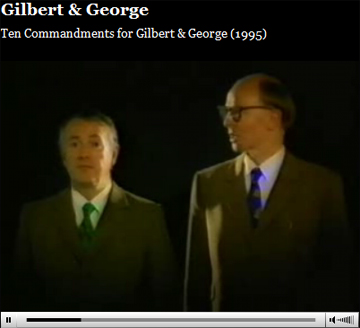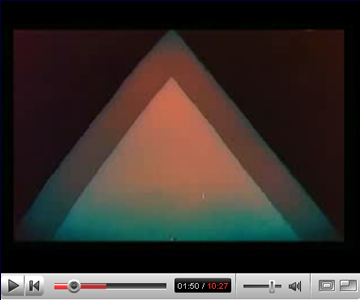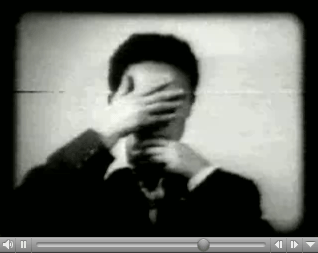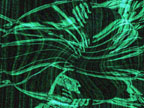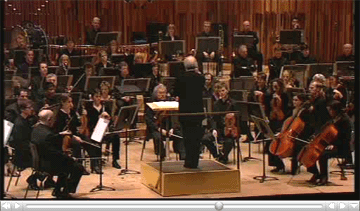May 30, 2007
Douglas Davis
Douglas Davis is primary known for his pioneering video works from the late 60’s through to the 80’s which entailed live, collaborative performances combining newly invented video equipment and satellite broadcasts. The following is an overview of some of Douglas Davis art work.
The Last Nine Minutes (video extract above) was a live performance for international satellite telecast created for Documenta 6.
This performance, presented for German TV’s first live satellite transmission marking the opening of the Documenta VI in Kassel on 24 June 1977, is a continuation of Douglas Davis’ works on telecommunication. His exhortations of the viewers to establish contact with him via the TV screen are made all the more pointed by the physical distance between two continents.
My first discovery of Davis was via his later (and too few) net.art works, particularly The World’s First Collaborative Sentence (image below), where he transfered ideas he had already been thinking about for almost two decades.
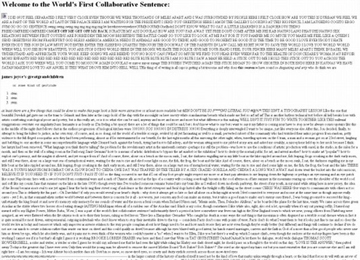
The World’s First Collaborative Sentence,without a doubt Davis’ most known net.art work:
commissioned in 1994 by the Lehman College Art Gallery, was purchased early in 1995 by Mr. and Mrs. Eugene M. Schwartz, then donated to the Whitney Museum of American Art, which now maintains its ever-evolving content.
Metabody a later net.art work from Davis is the worlds first collaborative visions of the beautiful, an attempt to form a collection of images which define the beautiful as interpreted by visitors to the website who upload images of what they think is beautiful.
Davis seems to be interested in weblogs these days (see his profile on blogger.com and his list of weblogs) but not sure whether these are art works in progress or research towards something. This is an interesting Interview of Davis for those who want to know more about his early work. [blogged by Garrett on Network Research]
Posted by jo at 03:30 PM | Comments (0)
May 22, 2007
Synthetic Performances
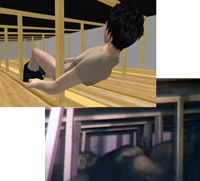
Second Life Re-enactments
While virtual environments like Second Life offer artists a new platform for the creation of original works, it's always interesting to see the past being reinterpreted. I'm pretty sure it was Marshall McLuhan who said all new media consumes its predecessor's content before settling on a new form, and we have witnessed his observations unfolding with the Radio > Television > YouTube evolution.
Eva and Franco Mattes (of 0100101110101101 fame) have taken this ethos of appropriation to heart in their ongoing Synthetic Performances. Seminal performance works from the 1960’s–80’s have been re-staged in Second Life and exhibited in-world and on their web site. Re-performances to date include Joseph Beuys' 7000 Oaks, Valie Export's Tapp und Tastkino, Vito Acconci's Seedbed (he was a bad boy) and Chris Burden's Shoot.
More images after the jump, or you can skip right to their site. If you have an SL account, click here to visit the 7000 Oaks performance in Second Life. More images >> [Posted by christo on selectparks]
Posted by jo at 05:28 PM | Comments (0)
April 09, 2007
Lessons in NetArt: Theory
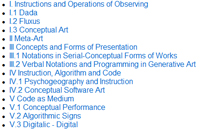
by Thomas Dreher
IASL online Lessons in NetArt: Theory: Now two texts are available in English:
Conceptual Art and Software Art: Notations, Algorithms and Codes: Self-replicative and generative codes have been developed in Software Art. Intermedia Art´s relations between notation and realisation are expanded by new mutations in relations between readable code and computer processing: Examples of program codes appear as the next step after formalizations of verbal concepts in Dada, Fluxus and Conceptual Art. And on the other hand: These formalized notations can be presented as precursors of Software Art.
Participation with Camera: From the Video Camera to the Camera Phone: The development of the camera´s technology (video camera, WebCam, camera phone) and its context had and has consequences for the development of strategies to integrate participative uses of cameras into projects. The article outlines the camera´s use as a subject of change from video and net projects to collaborative mapping with locative media.
The article "Participation with Camera" offers an overview on some of the nearly hundred projects described in German in:
Collected tips: Interactive Urban Experience with Locative Media (Mapping) Part 1, Part 2.
Dr. phil. Thomas Dreher
Schwanthalerstraße 158
D-80339 München
B.R.D.
URL:
http://dreher.netzliteratur.net
Posted by jo at 07:05 PM | Comments (0)
March 16, 2007
Art Since 1960 (According to the Internet)
Internet nerd that I am, I actually recorded some of last Thursday's lecture by Hanne Mugaas + Cory Arcangel titled Art Since 1960 (According to the Internet.) Count yourself lucky for not having to listen to that file though, as the documentation of two people surfing the web doesn't exactly translate well into aural sensation. Somewhat predictably, in lieu of this media I've chosen merely to summarize the most important point I got out of the lecture: There is less and less difference between canonical art works and any other cultural products on the web.
Countless examples reinforcing this point followed, most of which were at the very least entertaining, and often much more than that. The best video comparison cited came from a post Arcangel had curated on Hanne's blog early this January.
Don't let the length of the second video confuse you, as the relevant comparison of falling figures happens in the first few seconds of the video.
On some level, you either buy work such as this as a valid investigation of how art and culture merge on the web or you don't, but for those who are wondering why they just bothered watching those videos, I have to grant that it's not a bad question. That said, it's also unanswerable. Nobody knows precisely what this leveling of fields means for art or art history, which is why we have to pay really close attention to what's being made. If, as Warhol suggests, there really is little difference between the art of Jasper Johns and his lunches, then we at least need to be able to at least identify it.
Following the surfing talk, Hanne Mugaas + Cory Arcangel posted an intimidating list of links (with no anchors so lazy surfers such as myself complain about having to copy and paste these urls into their browser.) I recommend following as many as you can.
[posted by AFC on Art Fag City]
Posted by jo at 09:02 AM | Comments (0)
March 08, 2007
Ten Commandments for Gilbert & George (1995)
[posted on Expanded Cinema]
Posted by jo at 11:10 AM | Comments (0)
February 02, 2007
Allan Kaprow:
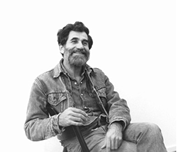
Kunst als leven – Art as Life
Allan Kaprow: Kunst als leven – Art as Life :: February 10 – April 22, 2007 :: VAN ABBEMUSEUM, BILDERDIJKLAAN 10, EINDHOVEN - THE NETHERLANDS :: 31 [0]40 238 1000 :: info[at]vanabbemuseum.nl.
Allan Kaprow, father of ‘happenings’ and ‘the most famous unknown artist’ died in April 2006. In association with the Haus der Kunst, Munich, the Van Abbemuseum organises the largest European solo presentation of the work of this American artist, displaying a development of almost 50 years of artistic work. The concept for this exhibition was developed together with the artist shortly before his death. Much of Kaprow’s art is special because it is interactive, intended to be carried out by people. The exhibition consists of a range of objects from Kaprow’s artistic legacy on view as well as a number of ‘happenings’ in which visitors can participate. The Van Abbemuseum’s artistic policy is to exhibit major overview exhibitions of artists from the sixties and seventies, who are the ‘classics’ of today.
The theme of the Allan Kaprow 'Kunst als leven – Art as Life' exhibition is the paradoxical question of how museums can display art in an appropriate manner in this day and age, while approaching real life with art as closely as possible. A range of objects from Kaprow’s artistic legacy will be displayed: early paintings, environments, video documents and photographs, as well as a fast array of original scores for his ‘happenings’ and ‘activities’.
This special presentation is not intended as an attempt to rewrite or document history, but to encourage visitors to see the ‘museum as mediation’. Kaprow was never interested in passively consumptive viewers but in active participation. The Van Abbemuseum is both a place of mediation and an agency of action. The exhibition will entail a re-enactment of a selection of happenings – on condition, however, that the visitors understand their new role and participate.
ALLAN KAPROW
Towards the end of the 1950s, American artist Allan Kaprow (1927-2006) coined the term ‘happenings’ for a new art form. A decade earlier, Kaprow had studied philosophy and subsequently art history with Meyer Shapiro in New York. At the same time he studied art with Hans Hofmann. It was while following composition classes with John Cage at the New School for Social Research in 1956/57 that he discovered he could use coincidence as well as everyday materials in his art. His work metamorphosed from expressionist scenes of figures through raw assemblies of materials to room-filling ‘environments’. With audiences participating, events took place in these ‘configured’ spaces from the late 50s onwards. Kaprow succeeded in doing what many painters and sculptors had endeavoured to achieve before him: the dissolution of the boundaries between art and reality. He accomplished the move into reality in such a radical fashion that his ‘happenings’ – which he later relabelled ‘activities’ – became indistinguishable from real life. During this process the artist drew back more and more from the institutions. To him, museums were burial chambers of art that no longer had anything to do with life.
HAPPENINGS
During the exhibition various happenings will take place in and outside the Van Abbemuseum. Participation is a must. For more information, dates and reservations, visit http://www.kaprow.org.
CURATOR
Exhibition concept: Eva Meyer-Hermann & Stephanie Rosenthal Van Abbemuseum exhibition curator: Eva Meyer-Hermann
The exhibition Allan Kaprow 'Kunst als leven – Art as Life' is a cooperation with Haus der Kunst, Munich, and co-sponsored by the Andy Warhol Foundation for the Visual Arts. The project has been carried out within the framework of TRANSFORM and with the support of the Culture 2000 programme of the European Union.
Posted by jo at 11:17 AM | Comments (0)
January 25, 2007
Maya Deren
A Study in Choreography for Camera (1945) (with Talley Beatty)
"The movement of the dancer creates a geography that never was. With the turn of the foot, he makes neighbors of distant places. Being a film ritual, it is achieved not in spatial terms alone, but in terms of a Time created by the camera." -- Maya Deren
Click here to read Erin Brannigan's essay on Maya Deren and the history of film utilising choreographic content and form. [via expanded cinema]
Posted by jo at 09:24 AM | Comments (0)
January 18, 2007
Anna Halprin: Dance/Art Experiments

Lecture and Workshop
Graduate Lecture Series presents Anna Halprin: Dance/Art Experiments :: January 31, 2007 from 12:00 PM to 2:00 PM :: USC Roski School of Fine Arts / Watt Hall 104, 3001 S. Flower St., University Park Campus, Los Angeles, CA 90089-0292 :: Telephone: 213.740.2787 /Fax: 213.740.8938 :: more info: slockhar[at] usc.edu
Anna Halprin has been working in the field of dance since the late 1930's creating revolutionary directions for the form and inspiring fellow choreographers to take modern and post modern dance to new dimensions: from theatrical production, to teaching, to improvisation, to celebrations of modern ritual and myth, to environmental and street dance, to multi-cultural collaborations, and dances fostering audience participation and creativity. Among her students were Trisha Brown, Simone Forti, Yvonne Rainer, Meredith Monk, and Robert Morris. Halprin pioneered what became known as "postmodern dance," creating work that was key to unlocking the door to experimentation in theater, music, happenings, and performance art.
"What are the possibilities for merging dance, art, and life?" In a special hands-on lecture/workshop, students will learn about Ms. Halprin's groundbreaking work in dance and education, then have the opportunity to participate in the creation of a dance-art experiment. The lecture will be followed by a workshop from 2-5 p.m. in the Roski MFA Gallery. The workshop is open to USC fine arts and dance students and others by special arrangement. Participants should bring a lunch and a scarf, and wear comfortable shoes & clothing. Please call 213.743.1804 for more information.
This event is co-sponsored by the USC Roski School of Fine Arts MFA Program and the Dance program at the USC School of Theatre.
Posted by jo at 05:38 PM | Comments (0)
November 27, 2006
First Generation:
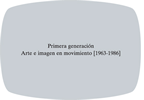
Art and the Moving Image, 1963-1986
First Generation: Art and the Moving Image, 1963-1986 :: November 7, 2006 - April 2, 2007 :: Museo Nacional Centro de Arte Reina Sofía, c/ Santa Isabel, 52, 28012 Madrid (Spain).
First Generation: Art and the Moving Image, 1963-1986 has the intention of presenting in a contextualized manner the historic core of the Museo Nacional Centro de Arte Reina Sofía's video collection. It has been built up in recent years with the goal of laying solid foundations upon which the collection could grow. Curated by Berta Sichel, director of the Museum's Audiovisual Department, the exhibition aims to reconstruct a history which has been neglected for a long time via the acquired works and with the support of a small yet significant group of works on loan to cover existing gaps. The exhibition has been organized around the different approaches and ideas of the artists who worked with video during the first 25 years of this medium. These include the inspiration of Fluxus, the critique of commercial television, the relationship between the medium and the viewer, feminism, performance and the legacy of minimalism and conceptual art.
Not a thematic exhibition, it does not try to follow a strict chronological order either. Rather, it is a vision of how and why a technology of recording, broadcasting and reproducing sound and images, which emerged in 1950 —and technically different than cinema— became an artistic medium. It is also a “study” of the influence technology and mass culture on the social and artistic changes of an era, at a time when cultural acceleration and the cross-pollination of ideas was beginning. In this sense, the year l963 is a landmark for the history of video. Wolf Vostell showed for the first time the installation 6 TV Dé-Coll/age at Smolin Gallery, New York City. Nam June Paik, then living in Germany, had his first exhibition at Galerie Parnass in Wuppertal. Music Electronic Television consisted of twelve altered TV sets, four adapted pianos in the same spirit of John Cage and, in the most genuine Fluxus Spirit, the head of a freshly-slaughtered ox hanging above the g allery's entrance.
1986 was not chosen randomly as the final year. In this timeframe a group of artists from the first generation had achieved international recognition and the young artists started to work in much larger media arts practices, using a wide range of hybrids which have opened a new chapter in the history of art and moving images. The mid 1980s also reflected a change in criticism, with theories of postmodernism and post colonialism raising questions of historiography and subjectivity. Consequently, the year this exhibition closes the term video art was already considered historic.
To tell this story, the exhibition diplays 32 video installations by the main artists belonging to this first generation: Eugènia Balcells, Dara Birnbaum, Jaime Davidovich, Juan Downey, VALIE EXPORT, Rafael França, David Hall, Gary Hill, Takahiko iimura, Joan Jonas, Shigeko Kubota, Thierry Kuntzel, David Lamelas, Mary Lucier, Antoni Muntadas, Nam June Paik, Ulrike Rosenbach, Carolee Schneemann, Ira Schneider, Bill Viola, Wolf Vostell, Roger Welch, Robert Whitman and Hannah Wilke; as well as 14 single-channel projections by: Marina Abramovic, Vito Acconci, Joseph Beuys, Peter Campus, Douglas Davis, Anna Bella Geiger, Joan Logue, Ana Mendieta, Marta Minujín, Bruce Nauman, Otto Piene and Joan Rabascall/Benet Rossell.
The exhibition closes as it opens: with works by Nam June Paik and Wolf Vostell. Mirage Stage (1986) by Paik, and a video recording of his performance with the cellist Charlotte Moorman, made by Otto Piene the same year; and New York Stuhl (l976) by Vostell that immerses us in a state of total amnesia about the origin of information.
A reference area consisting of 80 single-channel videos in a database complements the content of the show. This format allows visitors to make their own connections and discoveries, to interpret and reinterpret the history of the first generation of video artists, and to arrive at a new understanding of video work from its beginnings up to 1986.
For more information and photographic material please contact:
e-mail: prensa3.mncars@cars.mcu.es, tel: +34 91 774 1005, fax: +34 91 774 1009
Posted by jo at 08:25 AM | Comments (0)
November 22, 2006
First Generation in media …
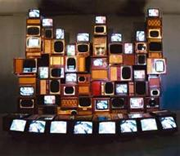
Art and the Moving Image, 1963-1986
First Generation: Art and the Moving Image, 1963-1986 is the title of a recently opened show at the Museo Nacional Centro de Arte Reina Sofía, Madrid. It assembles early video and video performance work mainly focusing from their own collection with emphasis on specific approaches to the medium during the first 25 years. It includes as main themes the inspiration of Fluxus, the critique of commercial television, the relationship between the medium and the viewer, feminism, performance and the legacy of minimalism and conceptual art.
First Generation does not aspire to be a thematic exhibition, nor does it try to follow a strict chronological order. Rather, it is a global vision of how and why a technology of recording, broadcasting and reproducing sound and images, which emerged in 1950 —and technically different than cinema— became an artistic medium;
a “study” of the influence technology and mass culture had on the social and artistic changes of an era, at a time when cultural acceleration and the cross-pollination of ideas was beginning. In this sense, 1968 marks a before and after in this history: for that was the year in which a portable, relatively affordable television set appeared on the market, opening this medium up to a vast new group of people.
Interesting in this context might be as well the link to the complete archive of the early media magazine Radical Software:
The historic video magazine Radical Software was started by Beryl Korot, Phyllis Gershuny, and Ira Schneider and first appeared in Spring of 1970, soon after low-cost portable video equipment became available to artists and other potential videomakers…. [blogged on mind the __GAP*?] [Related]
Posted by jo at 06:07 PM | Comments (0)
November 21, 2006
Martha Rosler:
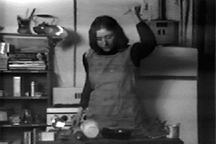
Art & Social Life; The Case of Video Art
"The wide-open field of early video may arguably be the typical condition of a medium at birth (compare the internet, on its way from being a utopian arena of activity to a gated compound locked down by corporate toll takers, if the latter get their way). Despite the competition of sites like Youtube, video as an art form has become, by definition, an expensive captive of the gallery and museum, the black box inside the white box."
unitednationsplaza is pleased to present a seminar and a video festival organized by Martha Rosler: Art & Social Life; The Case of Video Art. The program will begin with a public lecture by Marta Rosler on Sunday, December 10th at 6 pm.
The video festival will present a selection of early video works, dating from 1968 to present, from the personal archive of Martha Rosler, including numerous works rarely seen and largely excluded from the canonical history of video art, and others that form the backbone of early video histories as now written.
The video program will be free and open to the public daily from 2 - 6 pm at the screening room of the unitednationsplaza, starting Monday, December 11th through Friday, December 15. The schedule of screenings will be posted shortly at http://www.unitednationsplaza.org
The seminar, comprised of four evening sessions scheduled to take place from 7- 9PM, will start on Monday and continue through Thursday evening. The seminar is open to the public, however due to space limitations please register in advance with magdalena[at]unitednationsplaza.org
Martha Rosler: Art & Social Life; The Case of Video Art
December 10 - 15, 2006
The early history of autonomous video art is a pivot point in the internal culture wars of the art world. Starting in the late 1960s through the early 1970s, artists with quite diverse practices experimented with the new (but not yet widely available) portable video apparatuses.
Film had by mid-century superseded both architecture and music as the queen of the arts. But by the 1950s the broadcast television industry and its structures of celebrity were challenging the social status of high art. Television was a problem… and then the Portapak was invented. Video suggested varieties of freedom to artists restive about or dismissive of traditional studio practices. Video promised a sort of gesamtkunstwerk on the ruins of a high modernism that had demanded a strict separation between forms. Video offered not just the experience of time married to the illusion of space accompanied by sound; because of poor image quality, video also offered relative freedom even from the concerns of cinema / art film / movies. It provided the opportunity to sketch or to perform, to record a gesture or a narrative, to sing in the shower or dance in the studio, abetted by simple in-camera edits. Artists could, without commitment, break free of the studio if they chose, and, in the political ferment and upheavals of the era, while look around, report, raise a voice, show a face, register anger, offer an opinion, analyze social structures and events, tell a joke, join with friends, and yell back at the mind-melting products of broadcast television while nevertheless making use of its capacity for instantaneous, unrecorded transmission and endless flow or using a recorded format that was easily reproducible and could be widely disseminated. The international potentials of this form were immediately obvious to artists and even museum administrators, to judge by the range of international 'video opens' of the mid-1970s-
The wide-open field of early video may arguably be the typical condition of a medium at birth (compare the internet, on its way from being a utopian arena of activity to a gated compound locked down by corporate toll takers, if the latter get their way). Despite the competition of sites like Youtube, video as an art form has become, by definition, an expensive captive of the gallery and museum, the black box inside the white box. But the transformative impulses that drove utopian hopes in the earliest days have not completely evaporated. It is absolutely vital to revisit early video works and their context (including the texts of the era), to provide a deep slice into the moment of origin and see what may be refurbished and adapted for the present —beyond the stylish appropriations of the 70s “look.” In the face of the Society of the Spectacle, taking back / talking back to the media was a watchword of the era, offering the hope of social transformation through art, activism, and community interventions. This hope animates many today, in whatever form and medium it may be furthered.
Martha Rosler was born in Brooklyn, New York, where she now lives, after spending the 1970s in California. She works in video, photo-text, installation, sculpture, and performance, and writes on aspects of culture. She is a renowned teacher and has lectured widely, nationally and internationally. Rosler's work is centered on everyday life and the public sphere, often with an eye to women's experience. Recurrent concerns are the media and war as well as architecture and the built environment, from housing and homelessness to systems of transport. Her work has been seen in the Venice Biennale of 2003; the Liverpool Biennial and the Taipei Biennial (both 2004); as well as many major international survey shows, including Open Systems at the Tate Modern (2005). Her work has been included in the Documenta exhibition in Kassel, Germany, and several Whitney biennials, and she has had numerous solo exhibitions. She has been invited to participate in Skulptur Projekte 07 in Münster as well as in documenta xii. A retrospective of her work, ‚Positions in the Life World,’ toured Western Europe and was shown at two New York museums from 1998 to 2000. Rosler has published fourteen books of photography, art, and writing. Among them are Decoys and Disruptions: Selected Essays 1975–2001 (MIT Press, 2004, An October Book, in conjunction with the International Center of Photography), the photo books Passionate Signals (Cantz, 2005), In the Place of the Public: Airport Series (Cantz, 1997), and Rights of Passage (NYFA, 1995). Sur/Sous le Pave (Rennes, 2006), like the much earlier If You Lived Here (Free Press, 1991) addresses the urban landscape and focuses on housing, homelessness, and urban life. Rosler has been awarded the Spectrum International Prize in Photography for 2005, the Oskar-Kokoschka Prize (Austria’s highest fine arts award) in 2006, and an Anonymous Was a Woman Award for 2007. Her solo exhibition, London Garage Sale, was held at the Institute of Contemporary Arts in London in 2005. Her installation Kriegeschaüplatze (Theaters of War) was shown in Berlin (Christian Nagel) in 2006, and a selected retrospective of her work was shown at the University of Rennes.
unitednationsplaza is exhibition as school. Structured as a seminar/residency program in the city of Berlin, it involves collaboration with approximately 60 artists, writers, theorists and a wide range of audiences for a period of one year. In the tradition of Free Universities, most of its events are open to all those interested to take part. unitednationsplaza is organized by Anton Vidokle in collaboration with Liam Gillick, Boris Groys, Martha Rosler, Walid Raad, Jalal Toufic, Nikolaus Hirsch, Natascha Sadr Haghighian and Tirdad Zolghadr.
unitednationsplaza
Platz der Vereinten Nationen 14a
Berlin 10249 Germany
T. +49 (0)30 700 89 0 90
F. +49 (0)30 700 89 0 85
http://www.unitednationsplaza.org
Posted by jo at 05:09 PM | Comments (0)
November 14, 2006
Joao Ribas
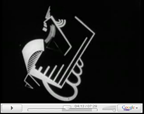
Expanded Cinema
"I've received quite a few emails asking why I haven't curated something online, particularly in terms of culling film and media, and things that are hard to incorporate into more 'conventional' exhibition formats. I've taken the suggestion seriously and decided to launch this online platform for just that, Expanded Cinema. I'll be posting some material here every few days, along with guest curators, as part of a series focused mainly on experimental film, early video, and sound-based, durational work. All of the material is being pulled from available media online elsewhere, as part of emphasizing an overlooked facet of the archival function of new media." -- Joao Ribas
Posted by jo at 11:45 AM | Comments (0)
November 09, 2006
Walter Ruttmann
Lichtspiel Opus I
With a background as a painter, and cellist/violinist, Walter Ruttmann found his way to making experimental abstract animations in the 1920s, and later, feature length documentary films.
Ruttmann was in a milieu of painters, poets and musicians who saw in the new media a possibility to expand the limits of the fine arts. They described their abstract films as visual music, seeking to achieve a similar experience in the visual as in music. The overall idea of their works was also linked to the concept of the absolute film; the idea of a universal language of abstract images.
Ruttmann's most well-known film is Berlin-Symphony of a Great City, which utilized the Kino-Eye or Cinematic-Eye technique of Dziga Vertov. This is documentary filmmaking at its most poetic and expressive. His later World Melodies expanded on the synthesis of the visual and the musical with scenes taken from all over the world.
During the late 1930s Ruttmann delved deeper into documentary filmmaking, which likely led to his work on various propaganda films. As Germany moved towards World War II, Ruttmann worked with Leni Riefenstahl in the writing of the famous Nazi propaganda film Triumph of the Will(1934), and later the editing of Olympia (1938). Whether or not Ruttmann would have suffered the same lapse in reputation that Riefenstahl did after the war will never be known, as he was killed on the war front making a newsreel just three short years later.
Weekend (1930) 11'10": Weekend is a pioneering work from the early days of radio, commissioned in 1928 by Berlin Radio Hour. In a collage of words, music fragments and sounds, the film-maker and media artist Walter Ruttmann presented on 13 June 1930 a radically innovative radio piece: an acoustic picture of a Berlin weekend urban landscape.
Posted by jo at 03:42 PM | Comments (0)
October 17, 2006
Dan Visel
Finishing Things
Yoko Ono's Cut Piece
One of the most interesting things about the emerging online forms of discourse is how they manage to tear open all our old assumptions. Even if new media hasn't yet managed to definitively change the rules, it has put them into contention. Here's one, presented as a rhetorical question: why do we bother to finish things?
The importance of process is something that's come up again and again over the past two years at the Institute. Process, that is, rather than the finished work. Can Wikipedia ever be finished? Can a blog be finished? They could, of course, but that's not interesting: what's fascinating about a blog is its emulation of conversation, it's back-and-forth nature. Even the unit of conversation – a post on a blog, say – may never really be finished: the author can go back and change it, so that the post you viewed at six o'clock is not the post you viewed at four o'clock. This is deeply frustrating to new readers of blogs; but in time, it becomes normal.
But before talking about new media, let's look at old media. How important is finishing things historically? If we look, there's a whole tradition of things refusing to be finished. We can go back to Tristram Shandy, of course, at the very start of the English novel: while Samuel Richardson started everything off by rigorously trapping plots in fixed arcs made of letters, Laurence Sterne's novel, ostensibly the autobiography of the narrator, gets sidetracked in cock and bull stories and disasters with windows, failing to trace his life past his first year. A Sentimental Journey through France and Italy, Sterne's other major work of fiction, takes the tendency even further: the narrative has barely made it into France, to say nothing of Italy, before it collapses in the middle of a sentence at a particularly ticklish point. [continue reading at If:Book]
Posted by jo at 05:59 PM | Comments (0)
October 09, 2006
9 Evenings Lecture
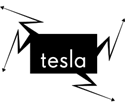
Berlin October 20
TESLA Berlin, Thursday 12 October, 20.30 h; (in English, free admission) The 9 Evenings performance series (1966) were a very important event in the history of performings arts and new media. The French art historian Clarisse Bardiot talks about this seminal moment for the interdisciplinary relationship between art and engineering.
http://www.tesla-berlin.de/_page.php?aktion=SHOW_PAGE&Page_ID=257.
Posted by newradio at 03:12 PM | Comments (0)
August 15, 2006
Edge Conditions
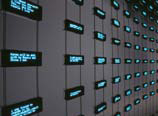
intersectional territory
The Edge Conditions exhibit at the San Jose Museum of Art runs through November 26, 2006 and anyone who didn't catch it as part of ISEA/ZeroOne and who is local to the area, should make the effort to experience it.
Most remarkable sensory engagement was Listening Post by statistician Mark Hansen and media artist Ben Rubin. If you know that Ben, in addition to a background in computer science, works in sound and live performance you can undertand why this piece is so compelling. It is conceptually rich in that the content is pulled live from the internet, but it's the implementation and presentation of the audio, music, and physical layout that combine to envelope, and mesmerize. It's contemplative, yet disturbing in its slickness; seemingly simple in its presentation though it's underlaid by technical sophistication. In sum, it's the well executed balance of aesthetics and computation that is so powerful. The artists' statements are insightful as well.
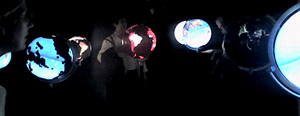 Most remarkable cognitive engagement was Ingo Gunther's fascinating WorldProcessor, an installation of illuminated globes visualizing social, political and environmental issues. This catalogue gives some indication of the data represented and how it's mapped to the globes. But it's the ability to walk around each globe and move one to another through the array of illuminated globes in the space that contributes to the impact of the meaning. The relative scale of the globes in relation to your comprehension of the data on a global scale is quite powerful. In this 2001 Shift interview he talks about his process and this ongoing project that began in 1988.
Most remarkable cognitive engagement was Ingo Gunther's fascinating WorldProcessor, an installation of illuminated globes visualizing social, political and environmental issues. This catalogue gives some indication of the data represented and how it's mapped to the globes. But it's the ability to walk around each globe and move one to another through the array of illuminated globes in the space that contributes to the impact of the meaning. The relative scale of the globes in relation to your comprehension of the data on a global scale is quite powerful. In this 2001 Shift interview he talks about his process and this ongoing project that began in 1988.
The above installations, each in a gallery, comprised part I of the exhibit with part II comprised of sculptural and screen-based works. The Edge Conditions curatorial statement noted computers and the internet are simply a set of tools and that the Edge referred to in the exhibit's title is about boundaries and intersectional territories. The following artists re-imagine space in some way, recognizing that the contemporary condition is to be in several places at once.
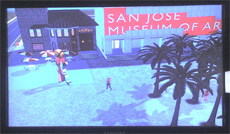 SimVeillance uses surveillance camera footage of the plaza outside the museum to generate characters in the game environment; I-5 Passing Lane uses pollution sensors along US I-5 to dynamically playback video scenes from the road; Takuji Kogo's Song for Silicon Valley is a video fabricated from the imagination based on iamgery culled from the internet; Tamiko Thiel's 3d VR installation The Tales of Mariko Horo inverts the Marco Polo story as an exploration of the mythic west; Michael Samyn and Auriea Harvey's MMORPG game Endless Forest, also envisions a fantasy game place that is beatiful and other; C5's Analogous Landscape sculpture and GPS data visualization investigate if mapping from one mountain ascent can be used to navigate another; while Thomson and Craighead's Light from Tomorrow draws attention to the social construction of time, yet the international date line exists because of the interconnectedness of time, space, and place where a day is lost or gained when circumnavigating the globe.
SimVeillance uses surveillance camera footage of the plaza outside the museum to generate characters in the game environment; I-5 Passing Lane uses pollution sensors along US I-5 to dynamically playback video scenes from the road; Takuji Kogo's Song for Silicon Valley is a video fabricated from the imagination based on iamgery culled from the internet; Tamiko Thiel's 3d VR installation The Tales of Mariko Horo inverts the Marco Polo story as an exploration of the mythic west; Michael Samyn and Auriea Harvey's MMORPG game Endless Forest, also envisions a fantasy game place that is beatiful and other; C5's Analogous Landscape sculpture and GPS data visualization investigate if mapping from one mountain ascent can be used to navigate another; while Thomson and Craighead's Light from Tomorrow draws attention to the social construction of time, yet the international date line exists because of the interconnectedness of time, space, and place where a day is lost or gained when circumnavigating the globe.
Posted by michelle at 01:44 AM | Comments (0)
May 17, 2006
Performance Paradigm, Number 2

Japan After the 1960s: The Ends of the Avant-Garde
"It is widely acknowledged that dramatic changes wrought in 1960s Japan were such that art and cultural practice were transformed into an emergent avant-gardism. Hybridity, physical and intellectual intensity, formal innovations and transgressive acts are all characteristics of 1960s theatre, dance, cinema, literature and performance art in Japan and elsewhere.
The 1960s era was significant not least for the emergence of new aesthetics connected to a rapid evolution of political sensibilities. In Japan, as in Europe and America, artists were rethinking materials and forms often in terms of bodies juxtaposed with mediated spaces and objects. Art works began rejecting academic and formal qualities of art and instead related to the everyday experience of the world, foregrounding experiences of time and immediate sensory perception in a language which was conceptual and dynamic. This emerging performative discourse challenged ideas of representation and politics in art as performance began re-connecting with the social sphere.
As Marvin Carlson suggests, it is a language and a set of practices which became paradigmatic of the post 60s world: 'With performance as a kind of critical wedge, the metaphor of theatricality has moved out of the arts into almost every aspect of modern attempts to understand our condition' (Carlson, 1996: 6). This issue of Performance Paradigm looks at some of the places this metaphor migrated to and investigates how, in the process, ideas of culture and experiences of the world became actively performative. In a similar vein, this issue examines how perception and experience in the arts in the post 60s era came to stand for the embodiment of a new politics..."
ARTICLES
- Peter Eckersall and Edward Scheer 'Introduction'
- Satô Makoto, translated by Yuji Sone 'On Vernacular Theatre'
- Yasuko Ikeuchi 'Performances of Masculinity in Angura Theatre: Suzuki Tadashi on the Actress and Satô Makoto's Abe Sada's Dogs'
- Michael Hornblow 'Bursting Bodies of Thought: Artaud and Hijikata'
- Shannon C. Moore 'Ghosts of Premodernity: Butoh and the Avant-Garde'
- Jonathan Marshall 'Dancing the Elemental Body: Butoh and Body Weather: Interviews with Tanaka Min and Yumi Umiumare'
- Lisa Kuly 'Translation, Hybridity, and 'The Real Thing': Don Kenny's English Kyôgen'
- Vera Mackie 'The Spectacle of Woman in Japanese Underground Theatre Posters'
- Midori Yoshimoto 'Off Museum! Performance Art That Turned the Street into 'Theatre,' Circa 1964 Tokyo'
- Gunhild Borggreen 'Ruins of the Future: Yanobe Kenji Revisits Expo '70'
- Uchino, Tadashi 'Mapping/Zapping 'J' Theatre At The Moment'
BOOK REVIEWS
M.Cody Poulton, 'Unspeakable Acts: The Avant-Garde Theatre of Terayama Shûji and Postwar Japan' Carol Fisher Sorgenfrei
Mika Eglinton, 'Into Performance: Japanese Women Artists in New York' Midori Yoshimoto (New Jersey and London: Rutgers University Press, 2005).
Yuji Sone, 'Alternatives: Debating Theatre Culture in the Age of Con-Fusion,' Peter Eckersall, Uchino Tadashi and Moriyama Naoto (eds.), No. 11 in the series Dramaturgies: Texts, Cultures and Performances (Brussels: P.I.E.-Peter Lang 2004).
EVENT REVIEW
Zack Fuller, Tradition and Innovation: Dance Hakushu 2005. August twelfth through twenty-first, Body Weather Farm, Yamanashi, Japan.
From Japan After the 1960s: The Ends of the Avant-Garde, Performance Paradigm, Number 2, Edited by Peter Eckersall, March 2006 [ISSN 1832-5580]
Posted by jo at 10:02 AM | Comments (0)
May 05, 2006
MIT List Visual Arts Center

Art + Technology
Currently at the MIT List Visual Arts Center, Cambridge, Massachusetts: 9 Evenings Reconsidered: Art, Theatre, and Engineering, 1966; Choreographic Turn: Daria Martin; Peter Welz in collaboration with William Forsythe; and Chris Doyle: Recent Video Works
9 Evenings Reconsidered: Art, Theatre, and Engineering, 1966, Curator: Catherine Morris.
This exhibition, organized by independent curator Catherine Morris, takes a fresh look at 9 evenings: theatre and engineering, a series of performance events organized by Billy Klüver, a Bell Laboratories engineer, that took place at the 69th Regiment Armory in New York from October 13-23, 1966. 9 evenings featured ten artist/engineer collaborators who attempted to realize previously unattainable creative projects. 9 Evenings was a significant turning point for many artists who became aware, many for the first time, of the implications that advancements in technology had for the development of their own work. The exhibition 9 Evenings Reconsidered: Art, Theatre, and Engineering, 1966 includes works of art, ephemera, drawings, film, and photo documentation of the 1966 performances.
The artists involved in 9 evenings: theatre and engineering were John Cage (composer); Lucinda Childs (dancer and choreographer); Öyvind Fahlström (painter and author of theater pieces); Alex Hay (painter and choreographer); Deborah Hay (dancer and choreographer); Steve Paxton (dancer and choreographer); Yvonne Rainer (filmmaker, dancer and choreographer); Robert Rauschenberg (painter and choreographer); David Tudor (musician and composer); and Robert Whitman (film/video artist, author of theater pieces). Bell Laboratories’ Billy Klüver brought these artists together and paired each artist with an/a Bell Labs engineer to create new works. Engineers included: Per Biorn, Cecil Coker, Ralph Flynn, Larry Heilos, Peter Hirsch, Harold Hodges, Robert Keronski, Jim McGee, Robby Robinson, Herb Schneider (MIT Class of 1948), Fred Waldhauer, Witt Wittnebert, and Dick Wolff.
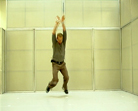
Choreographic Turn: Daria Martin; Peter Welz in collaboration with William Forsythe, Curator: Bill Arning, MIT List Visual Arts Center.
This exhibition features a 16mm film entitled Soft Materials by Daria Martin, an American artist living and working in London, and a large five-screen video installation entitled whenever on on on nohow on / airdrawing by German artist Peter Welz in collaboration with celebrated dancer/choreographer William Forsythe. In bringing together the work of these artists, curator Bill Arning offers audiences the opportunity to consider the space between dance and moving image in contemporary art practice. There is a growing history and cultural practice of choreocinema, or dance on film/video, a hybrid art form that offers previously unavailable experiences of dance. Choreographic Turn celebrates this exciting shift in cultural practice by showing two recent extraordinary iterations of this new form-film/video installations offering new modes of experiencing the art of bodies in motion.
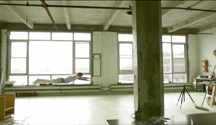
Chris Doyle: Recent Video Works
Flight (2005) 31 seconds
Tower (2005) 4 minutes
Hotel Bernini I (excerpt) (2004) 2 minutes, 33 seconds
Watershed (2004) 3 minutes, 02 seconds
Extraordinary Perceptual Dilemmas and the Madness of Climbing (2003) 1 minute, 30 seconds
Chris Doyle's themes are drawn from the psychology of everyday life. By using only the most low-tech special effects, he transforms everyday images into short films that are magical and moving.
Doyle is perhaps best known for Leap , a public artwork sponsored by Creative Time in April, 2000, for New York City's 2 Columbus Circle. A celebration of hope, Leap , showed moving images projected onto a tall building of various New Yorkers from all five boroughs jumping skyward. Beginning at dusk, depictions of a continuous stream of New Yorkers appeared at the base of the building, and one by one, four hundred and twenty jumpers soared up the height of the facade, slipping into the night sky.
In recent years, Doyle has worked less in the public sphere, and more in the private fictional spaces he creates in his videos. This selection of videos shows a wide range of Doyle's interests, but each manifests a dreamlike vision in which the quotidian becomes extraordinary. Doyle likens his practice to a "Pathetic Magician, a sad sack trying to make magic out of what is at hand."1 Writing in Art News magazine Linda Yablonsky said "(Doyle) has cast hot dogs, red bricks, and lawn chairs as human surrogates in videos that constantly mix storytelling with abstraction." 2
Flight (2005) shows the artist doing aerial circuits in a Superman pose around his Brooklyn studio before heading out the window. Today, when even amateurs have access to Hollywood-quality special effects, the artist's goal is clearly not a seamless effect. The jerky motion is left as a clue to his methodology, in which the artist performed 230 individual leaps and then sequenced the still photographs to depict flight.
Tower (2005) uses an animation technique known as "claymation". Doyle has turned the descriptive form upside down; and we see the effects of unseen artist's hands on the tower, wounding and suturing the form. and twisting it like taffy.
Hotel Bernini I (2004) is among Doyle's most evocative works, in that how one perceives the turbulence of the white hotel sheets will invariably be affected by one's own psychology. Whether it is understood as the result of anxiety, insomnia, or passion, the sheets are now vacant, and the bodies that gave them life are now missing.
Watershed (2004) shows a partly deconstructed bank building that the artist found in upstate New York. Using only flashlights for special effects, Doyle uses the skeletal frame as a metaphor for the psychological structures that contain thought, with the flashes of light serving as the events or perceptions that define human relationships. The artist appears at the very end sweeping up after the emotional fireworks.
Extraordinary Perceptual Dilemmas and the Madness of Climbing (2003) was a site specific project done for an exhibition in East Hampton, Long Island, NY. Like many natural paradises that have become popular resorts, longtime residents describe the area's past in idyllic terms that are too dreamy to be true. The old movie feel and the slightly horrific over-profusion of images are meant to conjure the dark side of paradise.
Posted by jo at 10:51 AM | Comments (0)
May 04, 2006
Save The Net
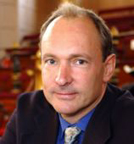
Tim Berners-Lee On Network Neutrality
Tim Berners-Lee, the father of the web, so to speak, weighs in on Net Neutrality.
When, seventeen years ago, I designed the Web, I did not have to ask anyone’s permission. [3]. The new application rolled out over the existing Internet without modifying it. I tried then, and many people still work very hard still, to make the Web technology, in turn, a universal, neutral, platform. It must not discriminate against particular hardware, software, underlying network, language, culture, disability, or against particular types of data. The Internet is increasingly becoming the dominant medium binding us. The neutral communications medium is essential to our society. It is the basis of a fair competitive market economy.
More than anyone, I think it is time for start-ups and their backers to take stock of what the loss of network neutrality would mean to their business. Win or lose, this one has business implications, more so for many of the smaller corporate citizens. [blogged by Om Malik on Broadband] WHAT YOU CAN DO.
Posted by jo at 12:53 PM | Comments (0)
April 21, 2006
Allan Kaprow
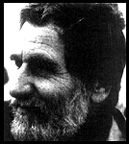
Creator of Artistic 'Happenings,' Dies at 78
Allan Kaprow, Creator of Artistic 'Happenings,' Dies at 78 by HOLLAND COTTER, April 10, 2006, The New Yok Times.
Allan Kaprow, an artist who coined the term "happenings" in the late 1950's and whose anti-art, audience-participation works contributed to radical changes in the course of late-20th-century art, died on Wednesday at his home in Encinitas, Calif., near San Diego. He was 78.
He died of natural causes after a long illness, said Tamara Bloomberg, his studio manager.
Mr. Kaprow was born in Atlantic City and began his career as an abstract painter in New York City in the 1940's, studying with Hans Hofmann. Inspired by the swirling drips and spatters of Jackson Pollock, and focusing on the idea of the painting as a physical event rather than as the production of an object, Mr. Kaprow pushed the "action painting" aesthetic in multimedia directions, at first by bulking up his canvas surfaces with hunks of straw and wadded newspapers and adding movable parts that viewers were invited to manipulate.
He called the results "action collages" and predicted, in a 1958 article in Art News, that in the art of the future action would predominate over painting and an increasing array of materials would come into play, including "chairs, food, electric and neon lights, smoke, water, old socks, a dog, movies, and a thousand other things." His own collages began to develop into room-filling environments that would pave the way for the installation art and performance art of today.
Along with Pollock, Mr. Kaprow's other great influence was the composer John Cage, with whom he studied from 1956 to 1958 at the New School for Social Research. He was particularly interested in Cage's Zen-inspired reliance on chance as an organizing, or disorganizing, element in art. Like Cage, he used a combination of choice and accident as a way of creating nonverbal, quasi-theatrical situations in which performers functioned as kinetic objects, the role of the single artist-genius was de-emphasized, audience members became creative participants, and no clear distinction was made between everyday actions and ritual.
The first such work, "Eighteen Happenings in Six Parts," took place in October 1959 at the Reuben Gallery in Manhattan, which Mr. Kaprow had co-founded. Although later the term "happening" would come to mean spontaneous, celebratory group behavior, Mr. Kaprow's early events were scripted assemblages of movement, sound, scent and light, with instructions given to performers and viewers alike. In the October 1959 version, spectators moved, on cue, to different parts of the gallery to experience a woman squeezing oranges, artists painting and a concert played on toy instruments.
Throughout his career Mr. Kaprow, who referred to himself as an "un-artist," created happenings outside galleries and museums, in lofts, stores, gymnasiums and parking lots. An element of absurdity was never far away: with the assistance of viewer-workers, he built houses from ice in Southern California and, in 1970, constructed a wall of bread with jelly as mortar near the Berlin Wall.
Mr. Kaprow was only one of the several artists involved in inventing happenings as a form: Jim Dine, Red Grooms, Claes Oldenburg, Robert Watts and Robert Whitman continued to use it. But he eventually stopped creating large public events in favor of what he called "activities" — intimate, personal pieces for a small number of participants. People in pairs, for example, would breathe into each other's mouths, or sweep the street, or go shopping.
In some case, Mr. Kaprow himself was the sole participant and audience, as in a 1980's piece that focused on the details of his daily tooth-brushing at home. He documented these private works in small booklets of instructions that read like Concrete poetry.
As an undergraduate at New York University, Mr. Kaprow was much influenced by John Dewey's book "Art as Experience." He did graduate work in art history at Columbia University with Meyer Schapiro, for whom he wrote a master's thesis on Mondrian. He taught at Rutgers University, Pratt Institute, the State University of New York at Stony Brook, California Institute of the Arts and, from 1974 to 1993, the University of California at San Diego.
He was a prolific and personable writer, and much of his work is collected in "Essays on the Blurring of Art and Life," edited by Jeff Kelley and published by the University of California Press in 1993. Mr. Kelley's book on the artist, "Childsplay: The Art of Allan Kaprow," was published by the same press in 2004.
That book has a foreword by the poet and performer David Antin, a longtime colleague of Mr. Kaprow, in which Mr. Antin describes a piece from the late 1980's that required a participant to carry cinder blocks, one at a time, up five flights of stairs, then down again. The number of blocks corresponded to the carrier's age. "I know that Allan sees his work as 'un-art,' " Mr. Antin concludes, "and wants to see its separation from art, envisioning it as simply an articulation of meaningful experiences from ordinary life. I'm sympathetic to this intention, but I find it hard to distinguish the existential power of this piece, which now exists only in the telling, from that of any other great work of art I've ever encountered."
Mr. Kaprow is survived by his second wife, Coryl Crane; two sons, Bram, of Encinitas, and Anton, of Altadena, Calif.; two daughters, Amy, of Berkeley, Calif., and Marisa, of Pacific Beach, Calif.; and three grandchildren.
Posted by jo at 06:02 PM | Comments (0)
February 15, 2006
Art Spaces Archives Project

Activist Arts Organizations of the 1970s and 1980s: Research Opportunities for Scholars
The Art Spaces Archives Project [AS-AP] is pleased to announce a panel discussion entitled Activist Arts Organizations of the 1970s and 1980s: Research Opportunities for Scholars, to be held at the College Art Association's 94th Annual Conference on February 23, 2006, from 5:30 to 7:00 PM in Boston at the Hynes Convention Center, Plaza Level, Room 112.
The panel will feature Linda Frye Burnham, Dr. Margo Machida, and Steven Englander. Moderating the panel will be David Platzker, the Project Director of AS-AP, a non-profit initiative founded in 2003 to assess and survey the state of the archives of art spaces throughout the United States.
The presenters will investigate the history of three formative organizations: High Performance Magazine, Godzilla: The Asian American Art Network, and ABC No Rio, and discuss what each of these organizations prompted, how they interacted within a community, how they co-existed, melded into, or changed a broader constituency. Additionally, the panel will discuss the role their archival materials play in telegraphing, or revealing, underlying historic information about these organizations and the state of these archives.
The goal of the panel is two fold: first to encourage emerging scholars to engage with the avant-garde / alternative organizations of the period, and secondly to highlight three selected organizations and to pair an emerging scholar with each. Ultimately, each scholar will conduct research using an organization's physical archival materials; perform oral histories with founders of the organization, and publish, on AS-AP's website, the conclusion of the research and oral histories.
In Spring 2006, AS-AP will invite proposals from emerging scholars to conduct the research with High Performance, Godzilla, and ABC No Rio. The three chosen individuals will conduct on-site work in 2007 with the edited oral history to be published by the close of that year.
AS-AP is using the panel as a template for emerging scholars to engage with the rich history of the avant-garde / alternative arts movement. Central to this investigation is the utilization of archival materials; the identification and preservation of which is fundamental to AS-AP's mission.
Linda Frye Burnham will reflect on the history of High Performance magazine (1978-1998) and the changes it tracked in the alternative arts movement during those years. High Performance followed the cutting edge from performance art through feminism, multiculturalism, activism and community-based art. High Performance was also closely engaged in the so-called Culture Wars of the early 1990s. After the demise of High Performance, Burnham and her co-editor, Steven Durland, wrote about these changes in The Citizen Artist: 20 Years of Art in the Public Arena (New York: Critical Press, 1998), and they have carried on their investigations at the Community Arts Network on the Web: http://www.communityarts.net. A traveling exhibition about the first five years of High Performance -- along with an award-winning essay in College Art Association's Art Journal -- were created by historian Jenni Sorkin in 2003 [Art Journal, vol. 62, no. 2 (Summer 2003), pp. 36-51. High Performance's archive resides at the Getty Research Institute in Los Angeles.
Margo Machida will discuss the formative years of Godzilla: The Asian American Art Network, from her perspective as a co-founder of this collectively-run group of New York City-based artists, writers, and curators. She will examine the period in which it arose, and what distinguishes Godzilla from groups that emerged in the context of 1970s Asian American arts activism. Founded in 1990 and active for over a decade, Godzilla was conceived as a pan-ethnic, cross-disciplinary, and multigenerational forum aimed at fomenting a wide-ranging dialogue in Asian American visual art. Over its "lifetime" it sponsored art exhibitions, public symposia, and open slide viewings for new artists; published a newsletter that featured emerging critical writing and news from artists across the country; and also served as a platform for arts advocacy. Godzilla's archive is housed at New York University's Fales Library, http://www.n yu.edu/library/bobst/research/fales/.
Steven Englander will discuss the history of the Lower East Side arts center ABC No Rio founded on New Year's Day, 1980, in New York City. He'll address the changes the organization has undergone over the years, and how the spirit and values that animated its early days continue to inform No Rio as its facilities, projects and programs have expanded and evolved. Since its founding No Rio has been host to a wide range of artistic expression dealing with war, homelessness, drugs, punk rock, performance art, spoken word and poetry, sex, violence, and the politics of housing and real estate, among much else.
About Art Spaces Archives Project
Art Spaces Archives Project [AS-AP] is a non-profit initiative founded by a consortium of alternative art organizations, including Bomb Magazine, College Art Association, Franklin Furnace Archive, New York State Council on the Arts [NYSCA], New York State Artist Workspace Consortium, and The Skowhegan School of Painting and Sculpture, with a mandate to help preserve, present, and protect the archival heritage of living and defunct for- and not-for-profit spaces of the "alternative" or "avant-garde" movement of the 1950s to the present throughout the United States.
With funding provided by NYSCA, The National Endowment for the Arts, and the Andy Warhol Foundation for the Visual Arts, AS-AP has a mandate to begin the documenting process by rooting out both a national index of the avant-garde -- assessing the needs for archiving and preservation-and helping to establish universal standards for archiving the avant-garde.
AS-AP's belief is beyond simply identifying the whereabouts of centers of activity. There is an underlying need to assess, catalogue, and preserve important formative materials for study by historians with a critical distance from the creation of the material itself.
AS-AP's website is a virtual resource and finding aid for locating the places and spaces of alternative and avant-garde activity. A central location for information pertaining to reservoirs of archives, tools to assist in archiving, and other aids for scholars interested in the alternative or avant-garde movement in the United States as well as for the locations of activity themselves.
About the Panelists
Linda Frye Burnham is a writer who founded High Performance in 1978 in Los Angeles and served as its editor through 1985 and its co-editor 1995-1998. She holds an MFA in Writing from University of California at Irvine. Burnham also co-founded the 18th Street Arts Complex and Highways Performance Space in Santa Monica, California; Art in the Public Interest in Saxapahaw, North Carolina; and the Community Arts Network on the World Wide Web. She has served as a staff writer for Artforum, contributing editor for The Drama Review and arts editor for the Independent Weekly of North Carolina. High Performance's website is: http://www.apionline.org/hp.html
Margo Machida is an educator, independent curator, researcher, and writer specializing in Asian American art and visual culture. She holds a Ph.D. in American Studies, and has a joint appointment in Art History and Asian American Studies at the University of Connecticut. Most recently she co-edited a major anthology of new critical writing entitled Fresh Talk / Daring Gazes: Conversations on Asian American Art (University of California Press, 2003). Dr. Machida has recently completed a book for Duke University Press, Art, Asian America, and the Social Imaginary: A Poetics of Positionality.
Beginning in 1995 Steven Englander has led the campaign to resist New York City's effort to evict ABC No Rio. Using the courts, public and political support, and finally direct action, the eviction was prevented, and the City, surprisingly, then offered the building to ABC No Rio for acquisition and renovation. Englander was hired as Director in 1999, and has overseen No Rio's transformation from storefront gallery / performance space to arts center with four floors of resources and facilities for area artists and activists. No Rio anticipates taking title to the building this winter, and renovation construction is expected to begin towards the end of 2006. ABC No Rio's website is http://www.abcnorio.org.
David Platzker is the Project Director of Art Spaces Archives Project. From 1998 through 2004 he was the Executive Director of the non-profit institution Printed Matter, Inc. He is also the co-author, and co-curator -- with Elizabeth Wyckoff -- of Hard Pressed: 600 Years of Prints and Process (New York: International Print Center New York & Hudson Hills Press, 2000); and -- with Richard H. Axsom -- the book and exhibition entitled Printed Stuff: Prints, Posters, and Ephemera by Claes Oldenburg: A Catalogue Raisonné 1958-1996 (Madison, Wisconsin: Madison Art Center & New York: Hudson Hills Press, 1997), which was awarded the George Wittenborn Award for Best Art Publication of 1997 by the Art Libraries Society of North America. Platzker is also the president of Specific Object, an on-line arts bookstore [http://www.specificobject.com]
For additional information regarding the panel or AS-AP please contact David Platzker at david[at]as-ap.org or at (212) 330-7688.
For admission information and additional information regarding the College Art Association's 2006 Annual Conference please visit CAA's website: http://conference.collegeart.org/2006/.
Posted by jo at 07:30 AM | Comments (0)
February 07, 2006
Statement of Purpose
Experiment in Art and Technology
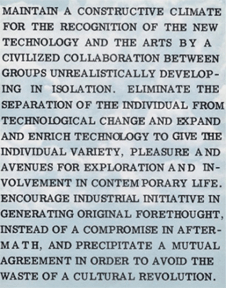
[image: Statement of purpose, Experiment in Art and Technology, (New York, United States), 1967. E.A.T. aims drafted by Billy Klüver and Robert Rauschenberg. via Daniel Langlois Foundation]
See 9 Evenings and Experiments in Art and Technology: a gap to fill in art history's recent chronicles, by Sylvie Lacerte, delivered at REFRESH! The First International Conference on the Histories of Media Art, Science and Technology, held at the Banff New Media Institute from September 28 to October 3, 2005. Following her in-depth research into the many activities conducted by EAT to support artists in their experiments with technology in the 1960's and 1970's, Ms. Lacerte asks why the chronicles of this groundbreaking organisation have been largely overlooked by the majority of works that examine art history of the past four decades. In her text, she offers a few hypothesis to help explain this mystery.
Posted by jo at 08:35 AM | Comments (0)
February 01, 2006
Nam June Paik
[Quicktime video] In memoriam Nam June Paik 1932 – 2006:
»There is no rewind button on the Betamax of life.«
Posted by jo at 10:22 AM | Comments (0)
January 31, 2006
Marshall McLuhan

tomorrow is our permanent address...
…McLuhan claimed some decades ago but nowadays we are simply already immersed and embedded …Arthur C. Kroker (editor of ctheory) states that we live in the electronic culture that he (McLuhan) prophesied. And since he wrote about it, technology has become more pervasive, but silent. It’s invisible. An elder article (written 2005 to remind McLuhan’s actuality 25 year after his death) gives..(an) overview on McLuhan’s opinions and as well both the enthusiasm and critique his thoughts evoked.
"For the first time, the central nervous system has been 'exteriorized," says Kroker, U Vic's Canada Research Chair in technology, culture and theory. "It is our plight to be processed through the technological simulacrum…in a "technostructure" which is nothing but a vast simulation and amplification of the bodily senses." McLuhan’s early (1960s) wake-up call about the extent to which people’s very identities are determined by the tools that they themselves invent can be listened to via these two links of the old recordings.
The Medium is the Massage; with Marshall McLuhan.
Long-Playing Record 1968.
Produced by John Simon.
Conceived and co-ordinated by Jerome Agel. Written by Marshall McLuhan, Quentin Fiore, and Jerome Agel.
Columbia CS 9501, CL2701.
[posted on mind the_GAP*]
Posted by jo at 11:02 AM | Comments (0)
Nam June Paik
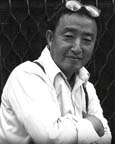
Paik, Pioneer of Video Art, Dead at 74
"Nam June Paik, the Korean-born artist and composer regarded as the inventor of video art, died Sunday of natural causes at his Miami home. He was 74. Paik is thought to have coined the terms "information superhighway" and "the future is now," as well as having global influence with his work.
Paik's art combined the use of music, video images and sculptures in a way that set the style for future video artists. "Paik's work would have a profound and sustained impact on the media culture of the late 20th century; his remarkable career witnessed and influenced the redefinition of broadcast television and transformation of video into an artist's medium," John Hanhardt, media arts curator at New York's Guggenheim Museum of Art, said in a statement.
"Through a vast array of installations, videotapes, global television productions, films, and performances, Paik has reshaped our perceptions of the temporal image in contemporary art," Hanhardt added." From Paik, pioneer of video art, dead at 74 CBC.CA.
Posted by jo at 08:21 AM | Comments (0)
January 20, 2006
WBAI-FM "Avant Garde Concert III"
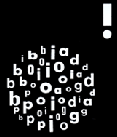
Charlotte Moorman
A Trove of Archival Performances by Charlotte Moorman: UbuWeb is proud to host the audio archive of Charlotte Moorman (1933-1991), containing hours worth of unreleased works and collaborations by Nam June Paik, John, Cage, Earle Brown, Karlheinz Stockhausen, Terry Jennings, Toshi Ichiyanagi, Jackson Mac Low, David Behrman, La Monte Young, Sylvano Bussoti, George Brecht, Dick Higgins, Giuseppe Chiari and others. The selection is curated by Stephen Vitiello, with special thanks to Barbara Moore / Bound & Unbound.
WBAI-FM "Avant Garde Concert III" was originally broadcast December 12 & 17, 1964. A Recording of the Annual Avant Garde Festival Program of August 30, 1964. From an original announcement card: "Avant Garde Concert III. Third in a series of concerts recorded by WBAI this fall at Judson Hall. Cellist Charlotte Moorman is assisted by pianist Nam June Paik and soprano saxophonist Terry Jennings. In the Cage opus she utilizes not only her cello but additional whistles, chains, balloons (for breaking), etc. with recorded supplements such as the Queen Mary's departure blast and sounds from Big Ben. In Stockhausen's 'Plus-Minus', Miss Moorman is assisted by a full-size robot named Robot Opera, built by Nam June Paik."
Posted by jo at 06:06 PM | Comments (0)
January 09, 2006
Time for John Cage
![]()
As Slow as Possible/ASLSP
The world’s longest performance of a piece of music is being played in Germany, and it will go on playing for another 639 years. John Cage's composition ASLSP, or to give it its full title As Slow As Possible, is part of what organisers have described as ‘a revolution in slowness.’ But can this really be taken seriously or is it simply a publicity stunt? Arts In Action reports.
Throughout his life, the experimental American composer, John Cage, was celebrated for his various efforts to subvert audiences’ conventional concepts of what music is, and should be. Famously quoted as saying, ‘if my work is accepted I must move on to the point where it isn’t’, Cage continually pushed back artistic boundaries and led audiences to the edge of reason.
Much of his theory of art was based on random events. Whether he used conventional percussion instruments or tinkered with audio frequencies, performances of Cage’s work always sparked conversation. In 1952 he hallenged every musical assumption with his most notorious piece entitled 4'33". Here players sat silently for the allotted time, allowing the ambient noise to fill the void. This quite literally was the sound of silence. more [via netbehaviour]
Posted by jo at 09:45 AM | Comments (0)
November 02, 2005
criticalartware
![]()
Dan Sandin Interview
Since the late 1960's Dan Sandin has developed artware systems integrating digitial + analog computers, customized circuits, home{brewed|built}-hardware, video games + virtualReality. Sandin, a professor at the University of Illinois at Chicago, founded the Electronic Visualization Lab (EVL), created the Sandin Image Processor (I.P.), developed the CAVE virtual reality (VR) system + various other [artware systems/technologies/projects/pieces]. His Image Processor (built from 1971 - 1973) offered artists unprecedented abilities to [create/control/affect/transform] video + audio data, enabling live audio video performances that literally set the stage for current realtime audio video art praxis.
To facilitate the open release of the plans for the Image Processor as an [artware/system/toolset], Sandin + Phil Morton created the Distribution Religion. As a predecessor to the open source movement in the tradition of free software, this approach allowed artists to engage with these hardware systems + continues to [interest/inspire] [artisits/developers]. In order to honor the innovative {recent futures|parallel hystories} of the Image Processor + the Distribution Religion, criticalartware has converted the deadTree Distribution Religion into a single PDF file + a web-based version, for release to the {criticalartware} community.
criticalartware interviews Dan Sandin, [discussing/illuminating] the community + development of the early moments of video art in Chicago, artware, performing live audio video, virtual reality, open source, righteous NTSC outputs, the video revolution + the changes + similarities that [bridge/differentiate] then && now. criticalartware freely offers this interview as {text|audio|video} data to be downloaded via the interweb + exchanged as shared cultural resources.
Posted by jo at 10:22 AM | Comments (0)
October 12, 2005
CYHIST/Community Memory:
Discussion List on the History of Cyberspace
The purpose of Community Memory: Discussion List on the History of Cyberspace is to create an oral history of cyberspace meaning the discussion of the history of computers, computer networks, and related technologies.
This archive contains unique first-person recollections from people who were active in building the Internet and its precursor networks, such as Arpanet, and myriad other networks and computers, dating back to the 1940s. The purpose of this archive is to serve future and present scholars and researchers interested in the history of cyberspace. For this reason, you are widely invited to store this archive of messages and make it publicly available via the Internet for people to search and retrieve the posts contained herein.
To ensure that this archive exists in perpetuity, please copy and duplicate and circulate to others, so that several copies may exist online. The wider it spreads, the more likely it will survive over time. Ideally, this entire archive would be placed online and made accessible through a searchable web-based interface, and indexed, in turn, by additional commercial search engines. Libraries are invited to add this archive to their digital collections.
The list is known as "CYHIST" and ran on two different listservers. The first listserver is cpsr-history[at]cpsr.org; that listserver handled messages from June 4, 1996 until August 15, 1996, when it was shut down. On August 13, 1996 all subscribers were shifted to a new listserver known as cyhist[at]maelstrom.stjohns.edu Searchable archives of the cpsr-history[at]cpsr.org messages are available at: http://www.memex.org/community-memory.html
Searchable archives of the cyhist@maelstrom.stjohns.edu messages can be found at: http://maelstrom.stjohns.edu/archives/cyhist.html. More.
CYHIST is a Center for Literary Computing project.
Posted by jo at 05:31 PM | Comments (0)
October 03, 2005
Systems Esthetics
Technological Shifts
"A polarity is presently developing between the finite, unique work of high art, that is, painting or sculpture, and conceptions that can loosely be termed unobjects, these being either environments or artifacts that resist prevailing critical analysis. This includes works by some primary sculptors (though 0 some may reject the charge of creating environments), some gallery kinetic and luminous art, some outdoor works, happenings, and mixed media presentations. Looming below the surface of this dichotomy is a sense of radical evolution that seems to run counter to the waning revolution of abstract and nonobjective art. The evolution embraces a series of absolutely logical and incremental changes, wholly devoid of the fevered iconoclasm that accompanied the heroic period from 1907 to 1925. As yet the evolving esthetic has no critical vocabulary so necessary for its defense, nor for that matter a name or explicit cause.
In a way this situation might be likened to the "morphological development" of a prime scientific concept-as described by Thomas Kuhn in The Structure of Scientific Revolutions (1962). Kuhn sees science at any given period dominated by a single "major paradigm"; that is, a scientific conception of the natural order so pervasive and intellectually powerful that it dominates all ensuing scientific discovery. Inconsistent facts arising through experimentation are invariably labeled as bogus or trivial-until the emergence of a new and more encompassing general theory. Transition between major paradigms may best express the state of present art. Reasons for it lie in the nature of current technological shifts." From Systems Esthetics by Jack Burnham. Reprinted from Artforum (September, 1968). Copyright 1968 by Jack Burnham.
Posted by jo at 12:01 PM | Comments (0)
August 31, 2005
Marcel Duchamp:
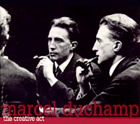
The Creative Act
A luminous text that will set the listener free! This CD is devoted exclusively to Marcel Duchamp and brings some very rare documents, all of which are crucial not only to understand Duchamp’s work but also grasp the rebellious, unconventional, anti-conformist spirit that was Zurich of 1919. Picasso and Duchamp: these two names span the extraordinary iconoclastic adventure of art in the early 20th century. Picasso, the incessant creativity where everything becomes art and Duchamp, ‘former Cartesian’ underminer of every received idea, Dada before Dada, inventor of the ready made and the Big Glass, cool humorist and debunker, creator of a creative universe, constantly being renewed, and creator of the mysterious person called Rrose Selavy.
Tracklist:
1. the creative act - lecture in Houston, Texas - April 1957
2. some texts from à l’infinitif (1912-1920)- lecture in New York, shortly before his death
3. musical erratum (la mariée mise à nu par ses célibataires, même) long before John Cage, the first aleotory composition.
4. an interview by George Heard Hamilton recorded in New York (1959)
5. an interview by Richard Hamilton recorded in London (1959)
6. musical erratum (a score for 3 voices) only score written by Duchamp for his 2 sisters
Visit GPod radio to listen. [via loreto martin]
Posted by jo at 11:59 AM | Comments (0)
August 24, 2005
Schema
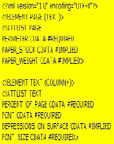
Instructions + Thought Experiments Made Tangible, Now Machine-Readable
XML Translation of Dan Graham's "Schema" by matt_butler: In 1966 conceptual artist Dan Graham composed a language-based work entitled Schema. The artwork consisted of a formal procedure for how to describe a document, or a "set of pages," with no real reference to the content of that document. This schema, as he called it, shares a remarkable similarity with XML, invented over 30 years later.
The conceptual artists of the late 1960's and early 1970's were interested in the nonvisual abstraction of art and how artworks might be represented as information. Using language in a non-literary and non-poetic manner, they sought to continue the tradition of visual artists in a search for abstraction and minimalism. Many conceptual works of this time were simply words on paper, instructions, or thought experiments. Schema allowed the viewer to be aware of the material nature and structure of the document they were holding — as well as any document they might hold. Using XML, I have created a machine-readable translation of his 1966 work. Schema was originally published in issue 5+6 of Aspen magazine. It is now being archived at UbuWeb.
Biography:
m.f.a. university of iowa (intermedia art). ph.d omega university (unaccredited parapsychology). maybe logic academy (robert anton wilson instructor).
matt is currently employed at the iowa city public library where he produces television programs for the library channel. he also teaches digital art at coe college in cedar rapids, ia.
matt has participated in a variety of art and technology events including versionfest at the m.c.a. chicago. his published books can be found at printed matter, inc. new york. [via Rhizome]
Posted by jo at 09:52 AM | Comments (0)
August 23, 2005
[-empyre-] clothing [and/as] technology

Clothing as Interface
From: Empyre/Felix Sattler
Sent: Sunday, August 21, 2005 8:24 PM
Subject: [-empyre-] clothing [and/as] technology
hi Heidi, Katherine Moriwaki, Floyd & empyreans,
just a few quick and maybe too loosely connected thoughts on wearables, clothing and technology. at the same time as the whole debate about the fusion of clothing with technology (high fashion colliding with high technology, etc...) is fascinating, it unfortunately is likely to cover its own cultural history.
in the past, clothing had not been enhanced by [digital] technology but itself had been rather synonymous with technology. together with the development of language the use of materials to cover the human body (i.e. the naked animal life) had been the primary cultural operation by which man (indeed physically) established a border between himself and the animal world, hence becoming human at all.
interestingly enough, the german word for this "border" between the naked body and the environment "grenzflaeche" (grenze=border, flaeche=surface) translates as "interface" in english, which makes the quality of clothing-as-technology quite apparent.
from this point of view, it becomes obvious that clothing/wearables fulfill several cultural tasks at the same time which even seemingly contradict each other. their function as a cover/shield/border for/of the human body "seamlessly" interacts with the one as a means of communicating/ exposing the body to the outside world. fashion has largely understood this ambivalence (being the original concept of an interface) for a long time and basically works on this principle.
the idea that wearable technology is something that is rather hidden while at the same time used to communicate with the outside world is therefore found at the beginning of the development of wearable computers. claude shannon and ed thorpe developed the first wearable computer in 1961-66 in order to "predict" roulette wheels, i.e. cheat casinos in las vegas. the computer (that was later famously labelled the "eudaemonic shoe computer" after the group of MIT-students called the "eudaemonics") was a small device hidden in the sole of a shoe. it was controlled by the movement of the toes and its feedback consisted of acoustic information via an almost invisible headphone connection.
anyway, before going too much into technical detail (i'm always trying to avoid that, but you can check out the links below for more info) i'd rather stop here.
i guess when we are dealing with wearable computer technology and especially with those that is able to establish [physical] connections between users we should be aware that clothing is way more than just a second skin (in fact it is (culturally) entirely different from skin and never a mere skin-extension). performing/transmitting data/language/touch/etc... through clothing as an interface therefore should imply a sense for the cultural function clothing inherits from the past.
best
felix
links to the history of wearable computing/MIT-shoe comp:
http://en.wikipedia.org/wiki/Wearable_computer
http://www.media.mit.edu/wearables/lizzy/timeline.html#1966a
http://wearcam.org/historical/node2.html
http://physics.ucsc.edu/people/eudaemons/layout.html
http://www.eyetap.org/wearcam/eudaemonic/
Felix Sattler Research Project: *Mapping the Casino - A Curatorial Adventure Into The Postindustrial Paradigmatic* Faculty of Media Bauhaus University Weimar Ernst-Kohl-Str. 2 D-99423 Weimar Germany phone: +49-3643-815968 mobile: +49-160-4155881
Posted by jo at 05:04 PM | Comments (0)
August 17, 2005
Nicolas Schöffer
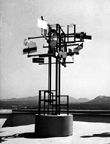
The Father of Cybernetic Art
Review of Nicolas Schöffer Exhibition by Joseph Nechvatal: Espace EDF Electra, 6, rue Recamier, 5007 Paris; Until September 11th, 2005.
"If one discounts the existence of László Moholy-Nagy’s Bauhaus Light Space Modulator (1923-30) (rebuilt in 1970 and now in the collection of Harvard University's Busch-Reisinger Museum) – a visionary multimedia artwork that helped inaugurate the artistic dialogue between machines, light, shadow and motion - there is something to the claim that the Hungarian-born French artist Nicolas Schöffer (1912-1992) is 'the Father of Cybernetic Art'. At the very least this premise may now be entertained while viewing actual work (mostly mobile sculpture under theatrical lighting effects) and an incredible amount of documentation now on view in Paris at the museum of the French electricity company Espace EDF Electra.
What is immediately evident in this exceptional historic presentation is that Schöffer’s career touched on painting, kinetic sculpture, architecture, urbanism, film, TV, and even music (he collaborated with Pierre Henry) – all in the pursuit of a dynamism in art which was originally initiated by the Cubo-Futurists and then intensified and solidified by the Russian Constructivists such as Naum Gabo, Anton Pevsner, Moholy-Nagy and Ludwig Hirschfeld-Mack. All were concerned with opening up the static three-dimensional sculptural form to a fourth dimension of time and motion, and this was Schöffer’s intention as well. Schöffer however, coming well after, benefited pleasingly from cybernetic theories (theories of feedback systems (interactivity) primarily based on the ideas of Norbert Wiener (1894-1964)) in that they suggested to him artistic processes in terms of the organization of the system manifesting it (e.g., the circular causality of feedback-loops). For Schöffer, this enabled cybernetics to elucidate complex artistic relationships from within the work itself.
His CYSP 1, from 1956 (top), is considered the first cybernetic sculpture in art history in that it made use of electronic computations as developed by the Philips Company. The sculpture is set on a base mounted on four rollers, which contains the mechanism and the electronic brain. The plates are operated by small motors located under their axis. Photo-electric cells and a microphone built into the sculpture catch all the variations in the fields of color, light intensity and sound intensity. All these changes occasion reactions on the part of the sculpture.
Consequently Schöffer’s kinetic sculptural compositions were able to parallel Warren McCulloch's adaptation of cybernetics in formulating a creative epistemology concerned with the self-communication within an observer's psyche and between the psyche and the surrounding environment. This is cybernetics’ primary usefulness in studying the supposed subject/object polarity in terms of artistic experience. That is the theoretical premise, at least.
In actuality we are treated here to dramatic light shows (some on the trippy side) that come whirling out of his spinning mechanical metal sculptures. Colored lights bounce off revolving polished metal towers - casting ever-changing lights and shadows onto huge wall screens and into our eyes. There also is a very basic interactive room consisting of a group of smaller whirling sculptures which respond to the presence of a viewer and a large prismatic triangle structure containing infinity views. This work brought to mind Lucas Samaras, Room 2 and other mirrored immersive works such as Getulio Alvani’s Cubic Environment and Luc Peire's Environment – all of which similarly offered the viewer a pervasive reflective arrangement where mirrored surfaces rebound amplitude to an indefinite degree.
In Schöffer’s triangular structure, my image was being ceaselessly mixed and reflected within spinning lights as I was made to feel an integral part of an exploding expanse. In general, this infinity experience bided me to view myself in infinity and so to feel space not in the traditional passive Euclidean custom - but in a conceptually operative and viractual (viractive) manner.
In addition, the exhibition demonstrates Schöffer’s three period styles. First is his “spatio-dynamic” constructions from 1948 on: attempts at a synthesis of spatial and dynamic elements. Next come the “lumo-dynamic” constructions of 1957, which connect light projections to music. In his “chrono-dynamic” works of 1959, word and tone, movement and space, light and color form together a totality of space-time.
Also well documented is Schöffer’s 52 metres high Cybernetic Tower from 1961, which was constructed in Liege with 66 revolving mirrors.
Given the period-piece nature of the exhibition, I found it stylistically engaging - and not overly retro looking. Indeed, the show surprisingly did not appear that dated, even though of course it recalled the early Paris 60’s and the futuristic 'space age' designs of Paco Rabanne which involved the use of moving metallic discs or plates. Yet my subject/object polarity never shifted much.
But given that, shouldn’t Nicolas Schöffer work be considered something other than an art object per se? Perhaps it is more appropriate to think of it as a means of transforming static perspective vision into a luminous motion study. We might just as well consider it then as stage props. Or better, an apparatus for painting with light. With his video works of 1961, Schöffer is additionally regarded as an early representative of video art – so perhaps it all funnels into special effects broadcast TV (which he did).
For me, the final interest of this show (which I have seen three times now) is in its allowing me to better position Schöffer in a certain art-tech artist-engineer intellectual history – a living history which has not yet exhausted itself. Indeed it is touching to consider that László Moholy-Nagy’s Light Space Modulator – which was driven by a motor and equipped with 128 electric bulbs in different colors - was finally demonstrated at the 1930 Paris Werkbund exhibition. So we see Nicolas Schöffer here not only as a pioneer of cybernetic art, kinetic sculptor, town planner, architect and theoretician of art - but as a key player in the middle of the art-tech intellectual narration – a narration which increasingly defines artistic achievement in the beginning of the 21st century." --Joseph Nechvatal. [Video]
Posted by jo at 08:00 AM | Comments (0)
August 11, 2005
INTERACTIVA 05
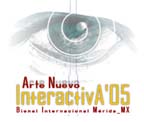
THE POSTCOLONIAL DILEMMA OF INTEGRATION VS. OPPOSITION
"Western thought is a particular metanarrative that has been heavily criticized by postcolonialism. Technology is considered by many an extension of Western thought and something that must be resisted or at least be critical of. This is the case with Balanquet. He considered InteractivA 05 a space where people could move towards a "post-technological" period, when the fetish for the machine would no longer exist, and the current models would be no more.[5] In his curatorial statement he contextualizes all of the participants as struggling with the inequalities that emerging technologies bring about in particular localities.[6] Balanquet's position actually resonated in every presentation, given that he would introduce everyone. Like most curators, Balanquet has a vision, an agenda that came into conflict with some of the works that he selected." From INTERACTIVA 05: THE POSTCOLONIAL DILEMMA OF INTEGRATION VS. OPPOSITION by Eduardo Navas, Net Art Review.
Posted by newradio at 09:59 AM | Comments (0)
August 06, 2005
The Matrix of Sensations
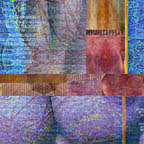
Art Grounded in Codes Rather than Images
"I present to you what I think is a radical thesis: that the period of avant-garde painting, which officially began with the so-called color patches of paint in Manet’s Music in the Tuileries Gardens in 1862, and climaxed almost a century later in the dynamic tachisme of European art informale and American modernist painting, was a time of transition from traditional analogue art to postmodern digital art, that is, to an art grounded in codes rather than images.
The status and significance of the image changes in postmodern digital art: the image becomes a secondary manifestation -- a material epiphenomen, as it were -- of the abstract code, which becomes the primary vehicle of creativity. Before, the creation of material images was the primary goal of visual art, and the immaterial code that guided the process was regarded as secondary. Now, the creation of the code -- more broadly, the concept -- becomes the primary creative act. The image no longer exists in its own right, but now exists only to make the invisible code visible, whatever the material medium. It makes no difference to the code whether it appears as a two-dimensional or three-dimensional image..." From The Matrix of Sensations by Donald Kuspit, artNet magazine. [via Rhizome]
Posted by jo at 09:39 AM | Comments (0)
August 02, 2005
Christopher Strachey:

The first digital artist?
"Christopher Strachey is rightly viewed as a pioneer of modern computing. He’s not usually, however, viewed as the creator of the first work of digital literature. Research toward my submission for DAC, however, has lead me to believe that he was — and that his initial digital literature project was also, quite probably, the first piece of digital art. I’d be quite interested to hear any thoughts (or refutations) from GTxA readers.
To begin with, however, I should explain that when I use the terms “digital literature” and “digital art” I mean something in particular by them." Continue reading Christopher Strachey: The first digital artist? by Noah Wardrip-Fruin and get involved in the discussion (blogged by Noah on Grand Text Auto].
Posted by jo at 10:29 AM | Comments (0)
July 18, 2005
Op Art + DualView LCD

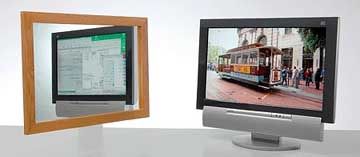
Optical Art or Op Art (1950's to 1960's) is a mathematically-themed form of Abstract art, which uses repetition of simple forms and colors to create vibrating effects, moiré patterns, foreground-background confusion, an exaggerated sense of depth, and other visual effects.
In a sense, all painting is based on tricks of visual perception: manipulating rules of perspective to give the illusion of three-dimensional space, mixing colors to create the impression of light and shadow, and so on. With Optical Art, the rules that the viewer's eye uses to try to make sense of a visual image are themselves the "subject" of the artwork.
Sharp has fused 2 LCD screens into 1 with its DualView LCD technology. The image changes depending on the viewing angle – bringing back sweet memories when Collectible Comic Trading Cards inserted a more primitive version in their sets as a rare bonus. Notice the mirror image in the picture on the left is different from what is shown. Simply amazing, I cannot wait to see what happens when such technology is implemented in desktops and notebooks in the near future!
Posted by jo at 10:44 AM | Comments (0)
June 13, 2005
Indeterminacy

A young man in Japan arranged his circumstances...
John Cage was an American composer, Zen buddhist, and mushroom eater. He was also a writer: this site is about his paragraph-long stories -- anecdotes, thoughts, and jokes. As a lecture, or as an accompaniment to a Merce Cunningham dance, he would read them aloud, speaking quickly or slowly as the stories required so that one story was read per minute. Indeterminacy archives 186 of those stories. Each story is spaced out, as if it were being read aloud, to fill a fixed area. If you like, you can also read them aloud at a rate of one a minute. The stories are taken from two of Cage’s books, Silence and A Year from Monday, and from the Folkways recording of him reading 90 of them aloud as David Tudor plays piano (among other things).
Posted by jo at 09:57 AM | Comments (0)
June 08, 2005
At a Distance:
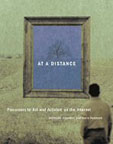
Precursors to Art and Activism on the Internet, 2005
At a Distance: Precursors to Art and Activism on the Internet, 2005 — Edited by Annmarie Chandler and Norie Neumark.—Cambridge: MIT Press, 2005.—486 p.—Includes an index.—Include a chronology of network art.—ISBN 0262033283. Reviewed by V.B. for The Daniel Langlois Foundation.
In their anthology, Annmarie Chandler and Norie Neumark assemble essays by authors who examine the networked collaborations of the 1960s and 1970s (Fluxus, mail art, cable video) as well as those of the 1980s (telematic art). Chandler and Neumark classify these practices under the heading of "distance art" to underscore the fact that they were not dependent on technological communication modes. They did, however, share a vision to utilize the space (physical, geographic, cultural, etc.) between the information transmitter and receiver in a performative fashion. And with an emphasis on programs rather than form, they introduced network art, experiments in augmented space, and the net.art of the decades that followed.
Norie Neumark's essay — which also serves as introduction — presents an overall view of the appropriation of communication tools by artists during the 20th century. The author goes on to suggest that the notion of distance could signify any combination of physical discrepancy, the time span between two events, and the division of object and subject in scientific observation. Neumark pursues her commentary by citing that the postal system was the first communication mode to close geographic distances. Broadly speaking, this system survives today, says the author, through the more sophisticated modes of technological exchange that have since emerged (telematics, Internet).
The book's first section, "Critical Perspectives on Distance Art/Activist Practices," is a collection of contributions that seek to trace the theoretic premises of these practices as they developed concurrent to the global implementation of communication modes from the 1960s onwards. The contributors assess, among other aspects, how these practices have historically been categorized according to technological progress, while the cultural contexts of their emergence and the way that participants and spectators identify with them have been largely neglected. To this end, in "Interactive, Algorithmic, Networked: Aesthetics of New Media," Johanna Drucker states that the precursors of network art reflected the technical aspects of their projects within a mainly conceptual and metaphorical perspective. By placing the accent on process rather than material repercussions or technological advances, these experimental practices allowed many artists to shed the formalist yoke of the previous decade. In "Immaterial Material: Physicality, Corporality, and Dematerialization in Telecommunication Artworks," Tilman Baumgärtel discusses the impact of exhibitions such as "Les Immatériaux," which was presented at the Centre George Pompidou (Paris, France) in 1985. According to Baumgärtel, through this multidimensional event that united theorists and artists, curator Jean-François Lyotard succeeded in defining the paradigm of an open and performative artwork. In his essay, Baumgärtel also highlights the innovative practices of the 1960s, such as the N.E. Thing Company, an entity both real and fictional created by Canadian artists Ian and Ingrid Baxter. The author states that this collective reflected the artist's public identity by parodying the protocols surrounding the exchange of economic information between a company and the outside world.
Like Baumgärtel, Reinard Braun in "From Representation to Networks: Interplays of Visualities, Apparatuses, Discourses, Territories and Bodies" reiterates the notion of dematerialization used to qualify conceptual art practices. He adds, however, that the telematic art projects of the 1970s went beyond this concept by taking into account the impact that locations transmitting and receiving information had on the significance of artistic proposals. With "The Mail Art Exhibition: Personal Worlds to Cultural Strategies," John Held Jr. addresses the problem of exhibiting mail art works. A number of representatives of the movement (including Ray Johnson) felt that these works should not become mere relics displayed in a gallery or museum. The author nevertheless makes an attempt to assemble a chronology of such exhibitions by describing the strategies used by the curators to present the works outside the network as still lively traces. In "Fluxus Praxis: An Exploration of Connections, Creativity and Connectivity," Owen F. Smith describes the sites of communication created by the Fluxus events, where communicational transparency took a back seat to humour, parody and play.
The second section presents case studies of important "distance" art projects. The studies are written either by the artists themselves or by participants who were witness to these practices. Annmarie Chandler interviews Kit Galloway and Sherrie Rabinowitz, artists who experimented with videoconferencing and satellites as early as 1970. They discuss the genesis of projects such as Satellite Art (1977), Hole in Space (1980) and Electronic Café (1984), ambitious planetary telecommunication undertakings presented to an audience that reached far beyond the perimeters of the art world. In "An Unsuspected Future in Broadcasting: Negativland," Don Joyce discusses the importance of the Negativland audio art collective of the 1980s, whose primary creative medium was the radio. One of the features of their radio show saw Negativland members inviting the public to call in and even join the broadcast (radio jamming). In "Mini FM: Performing Microscopic Distance," Annmarie Chandler and Norie Neumark interview Tetsuo Kogawa, a precursor of radio art in Japan. Kogawa describes the emergence in the 1980s of a community of young Japanese artists who used mini FM radios to communicate among one another, despite broadcasting regulations that normally filtered out this type of transmission. In "From the Gulf War to the Battle of Seattle: Building an International Alternative Media Network," Jesse Dew reports on the "Gulf Crisis TV" project, produced by Deep Dish TV Network and Paper Tiger Television (New York, U.S.A.) between 1990 and 1991. A series of cable programs documenting protests by Americans opposed to the Gulf War, the project constitutes for the author a counter testimony to the images being broadcast at the time by the mass media.
With "The Form: 1970-1979 and Other Extemporaneous Anomalous Assemblings," Melody Summer Carnahan summarizes her mail art work that began at the end of the 1970s and was derived from an alternative use of administrative procedures.
In "Networked Psychoanalysis: A Dialogue with Anna Freud Banana," Craig Saper interviews the artist known as Anna Banana, whose work drew on the paradigm of network psychoanalysis (using mail art), where participants could alternately play the role of analyst and analyzed. In "From Mail Art to Telepresence: Communication at a Distance in the Works of Paulo Bruscky and Eduardo Kac," Simone Osthoff offers a detailed analysis of the work of these Brazilian artists in the 1980s, when they primarily exhibited in South America. Osthoff studies Bruscky's fax and network art experiments and the early holography and telematic performance efforts by Kac.
"Distance Makes the Art Grow Further: Distributed Authorship and Telematic Textuality in La Plissure du Texte" by Roy Ascott recounts the collective writing experiment of 1983, which used the ARTEXT electronic textual network to capture the imagination of participants in cities around the world. In "From BBS to Wireless: A Story of Art in Chips," Andrew Garton discusses his involvement in various network projects, interweaving an autobiographical account into a history of communication technologies that he would use successively throughout his career. With "REALTIME-Radio Art, Telematic Art, and Telerobotics: Two Examples," Heidi Grundmann comments on a series of radio programs that she has curated and produced for Kunstradio in Austria since the 1970s. She also discusses the origins of the CHIP-RADIO (1992) and REALTIME (1993) projects, telerobotic musical performances that saw musicians play using motion sensors to remotely activate their instruments.
The third section focuses on the impact of the network on the art in the decades examined earlier in the publication. Contributions to the section study the emergence of artistic communities created through communication technologies. In "Estri-Dentistas: Taking the Teeth Out of Futurism," Maria Fernandez applies the notion of network as defined by theorist Armand Mattelart to examine the literary projects of the Mexican group Estridentistas, who produced works in their own country between 1920 and 1930. Among the group's influences were the Italian futurists. The author explains that the technological tools of the era were not directly accessible to the members of Estridentistas. However, they experimented with writing techniques inspired by their observations of communication and transport modes (telegraph and railway), which at the time constituted networks that bridged the physical distance between two points.
With "Computer Network Music Band: A History of the League of Automatic Music Composers and The Hub," Chris Brown and John Bischoff write about their use of telematics in musical improvisation and composition. The "League of Automatic Composers," which they created at Mills College, Oakland (California, U.S.A.) in the 1970s, was a precursor to today's widespread networking of computers by musicians and composers. In "Assembling Magazines and Alternative Artists' Networks," Stephen Perkins analyzes the phenomenon of magazines created by artists in the U.S. and South America in the early 1970s. Perkins emphasizes that by availing themselves of underground distribution methods, the artists succeeded in circulating subversive content outside of the mainstream media and in doing so escaped the grip of the authorities (particularly in countries under the stranglehold of a dictatorial regime).
In "The Wealth and Poverty of Networks," Ken Friedman, following the example of John Held Jr.'s text, returns to Fluxus and its derivatives, this time to analyze the concept of intermedia described by Dick Higgins in the 1960s. The author adds that the creators of these networks focused on relational aspects at the expense of the networks' sustainability. As a result, very little is left today with which to chronicle their historical path.
"From Internationalism to Transnations: Networked Art and Activism," by Sean Cubitt, underscores the extent to which the highly diverse political and social contexts of the collaborative projects impact their significance. Within a broader perspective, Cubitt maintains that the globalization of capital has the paradoxical effect of producing marginal networks that reinforce cultural particularities (demonstrated, says the author, by the artistic practices emerging from these networks).
Finally, the anthology includes a conclusion by Annmarie Chandler and Norie Neumark as well as a chronology of the role played by the network in art between 1921 and 2001, which encompasses all of the projects studied by the book's contributing authors.
Posted by jo at 07:00 AM | Comments (0)
May 23, 2005
Transvergence in Art History
The Polymathic Spirit of Transvergence
"In transdisciplinary projects, the traditionally assumed binary nature of art and science is exposed, and not taken for granted. Transvergence philosophy implies that the conventional distinctions between art and science have been artificially constructed and must be transcended for innovative artistic possibilities to happen. Creating permeable boundaries between art and science is a positive leap out of a restrictive, historical Western mind set that dictates these fields are dichotomous. Many have argued that art and science in fact share many common elements in conception and practice. According to Robert Scott Root-Bernstein, a self-proclaimed “practicing scientist and amateur artist,” “both scientists and artists are engaged in the common pursuit of new ways of perceiving and of controlling nature.”" From Transvergence in Art History by Ami Davis, Switch 20
Posted by jo at 11:04 AM | Comments (0)
May 13, 2005
The Future of the Reciprocal Readymade:
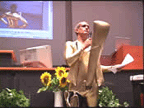
An Essay on Use-Value and Art-Related Practice
"The Future of the Reciprocal Readymade: An Essay on Use-Value and Art-Related Practice" by Stephen Wright [via 16 beaver group]
In a late text, Marcel Duchamp set out to distinguish several different types of readymades. Of particular interest here is the genre which he punningly described as "reciprocal readymades." Anxious, he claimed, "to emphasize the fundamental antinomy between art and the readymade," Duchamp defined this radically new, yet subsequently neglected genre through an example: "Use a Rembrandt as an ironing-board."(1) More than a mere quip to be taken at face value, or a facetious mockery of use-value, Duchamp’s example points to the symbolic potential of recycling art – and more broadly, artistic tools and competence – into the general symbolic economy of everyday life. For in that respect, the reciprocal readymade is the obverse of the standard readymade, which recycles the real – in the form of manufactured objects – into the symbolic economy of art.
Historically speaking, the readymade is inseparably bound up with objecthood: it refers to a readymade, manufactured object .Yet, it would be reductive to confine the readymade to its objective dimension alone, if only because it provides such a strong general image of the reciprocal logic between art and the real.
In the same way that framing an object in an art context neutralizes it as an object (distinguishing it, as it were, from the mere real thing), can the de-framing of an artwork neutralize it, in reciprocal fashion, as art? This is an important question, and one to which Duchamp was expressly alluding, because it would enable art to produce a use-value. Since Immanuel Kant’s influential championing of “purposeless purpose” and “disinterested satisfaction” as defining features of our engagement with art, it has been broadly held that art cannot produce use-values. Kant argued in effect that art, unlike design, could not be evaluated and appreciated on the basis of its objective purpose – be it external, regarding the utility of the object, or internal, regarding the perfection of the object. In so doing, Kant sought to preserve art from the realm of the “merely useful”; and in the contemporary world where utilitarian rationality and the sort of cost-benefit analysis to which it leads reign supreme, where art is regularly co-opted by such profit-driven, subjectivity-production industries as advertising, to even mention use-value tends to smack of the philistine. Of course one might say that in such a context there is something circular about defending art on the basis of its uselessness alone (or even its “radical uselessness,” as Adorno put it), for it would seem to suggest there is something worthwhile and thus useful about something ostensibly lacking use-value…
In any event, I have found that many contemporary artistic practices in the public sphere cannot be adequately understood unless their primary ambition to produce a use-value is taken into account. In trying to grasp what is at stake and at play in many of the art-informed practices which are, today, self-consciously concerned with generating use-value by injecting artistic skills into the real, it is useful to anchor their approach in art-historical terms; I want to argue that one way of understanding these works is as attempts to reactivate the unacknowledged genre of artistic activity conceived by Duchamp. For though he never got beyond the speculative phase – never actually putting his thoughts on the reciprocal readymade into practice – Duchamp clearly saw it as a way of “de-signing” art, of removing the signature by using an artwork to produce a use-value. For it is quite difficult to imagine how an artist-signed artwork (a “Rembrandt”), put to use as an ironing board, could then be re-signed as an “artistic” ironing board. Indeed, Duchamp’s point was that it would revert to non-art status – the price to be paid for acquiring use-value, though it would assuredly be a most uncommon ironing board.
That’s just art!
By that reckoning then, Kant was quite right: use-value and art, at least as it is now conventionally understood, are mutually exclusive terms. But is it perhaps possible to envisage dealing with use-value in substantively different terms? In terms literally reversing the dominant mode of twentieth-century artistic production? By thinking of art in terms of its specific means (its tools) rather than its specific ends (artworks)? In contexts often far removed from art-specific spaces and time, the past few years have witnessed the emergence of a broad range of such practices, which, in spite of certain affinities and indeed, in some cases, of undeniable family ties, can only be described as art-related rather than art-specific activities – often laying no particular claim to art status. The particular form of these activities suggests that they may be motivated by the desire to escape what is surely one of the most enfeebling accusations with which art is often, implicitly or explicitly, targeted: that it’s not for real; or to put it bluntly, that it’s just art. For much of modernity, this could be dismissed as quite an unfair charge, and in any case situating art tautologically as what it is would not have been seen as disqualifying its role or impact in the public sphere. Much twentieth-century aesthetic philosophy was devoted to placing art in invisible parentheses, in an effort to separate art objects from the “mere real things,” as analytical aesthetics cleverly puts it. Comparing a readymade to the “mere real thing” is certainly an elegant way of underscoring art’s ontological privileges; but there is something insolent and obviously fraudulent about describing non-art as “merely” real, particularly as art has often shown itself all too ready to fall back on its status as the “mere” partner of the real. Invariably, when some artwork or other is threatened with censorship, the artworld’s reaction is to assert the work’s art status, upholding the privileged status it enjoys in the symbolic order. Ironically however, in so doing, it is implicitly acknowledged that it is merely art, not the dangerous, and thus potentially censorship-deserving, real thing. In other words, cordoning art off from the real has, in many cases, afforded art a place in the public eye, but it has done so at the considerable cost of stripping art of its capacity to find a way to have any real use-value and undermining its claim to do much damage to the dominant order of signs.
Art without artists, without artworks, and without an artworld
What happens when art crops up in the everyday, not to aestheticize it, but to inform it? When art appears not in terms of its specific ends (artwork) but in terms of its specific means (competence)? Well, for one thing, it has an exceedingly low coefficient of artistic visibility: something is seen, but not as art – for without the validating framework of the artworld, art cannot be recognized as such, which is one reason why it is from time to time useful to reterritorialize it in an art-specific space through documentation. The four collectives whose work I shall consider in a moment – The Yes Men, bureau d’études, AAA Corp, and the Grupo de Arte Callejero – all confront a common operative paradox: though informed by art-related skills, their work suffers from – or, one could say, enjoys – impaired visibility as art. Yet this impaired visibility may well be inversely proportional to the work’s political efficiency: since it is not partitioned off as “art” – that is, as “just art” – it remains free to deploy all its symbolic force in lending enhanced visibility and legibility to social processes of all kinds. It is a form of stealth art, infiltrating spheres of world-making beyond the scope of work operating unambiguously under the banner of art. The art-related practitioners I mention here, and many others like them, have all sought to circumvent the reputation-based economy of the artworld, founded on individual names, and have chosen to engage in collaborative action; they use their skills to generate perception and produce reality-estranging configurations outside the artworld. As the wide range of tools developed by these collectives show, this has nothing to do with shunning or banning image production; art has no reason to renounce representation, a tool it has done much to forge and to hone over its long history. The question is the use to which such tools are put, in what context, and by whom: tools whose use-value is revealed as they are taken up and put to work. Specifically, then, how can art-related skills and perceptions be channelled in such a way that they empower rather than impress people? In other words, what do reciprocal-readymade practices, which see art as a latent activity rather than as an object or a process, physically look like?
The Yes Men: donning the fictional garb
The device which The Yes Men have most effectively gleaned from the toolbox of art history is verisimilitude, which they deploy in a framework of what might be described as deferred-disclosure tactics. The group is perhaps best known for designing fake-functional websites that parody, imperceptibly and incisively, those of socially pernicious political and business organizations, including the G.W. Bush campaigns in 2000 and 2004, and perhaps most notoriously, the World Trade Organization (WTO). So un-artlike – that is, so unidentifiable as art – was The Yes Men’s parallel WTO website design that it actually led to the group being invited, on several occasions, to represent the WTO at prestigious gatherings of various sectors of the business community, invitations which The Yes Men were only too pleased to accept. Asked to represent the WTO at a textile-manufacturers congress in Finland, one of The Yes Men took the podium and proceeded to deliver a keynote address on the virtues of free-trade and the evils of protectionism, which appeared to most audience members so WTO-like that they barely cringed when the speaker went on to argue that the abolition of slavery was an unreasonable interference in a market-driven economy. This impeccably designed performance was only revealed for what it was – a radical and thought-provoking spoof on the absurdity of laissez-faire discourse – when the impostor stripped off his three-piece, pin-striped suit and, clad only in a skin-tight bodysuit, proceeded to deploy a four-foot long phallus-like object attached to his midriff. Deadpan as ever, he described this Priapic excrescence – to the dismay of the security guards and the guffaws of the audience suddenly shaken from its ideological torpor – as a managerial tool for keeping close tabs on labour activity on the factory floors of the world. Such antics are made possible only by the deployment of art-related, fiction-design skills to infiltrate spheres well outside the world of art.
Perhaps a still more caustic fiction-based instance of “subversion of corporate subversion,” as The Yes Men put it, was the genuinely fake press release they designed and sent out by email to thousands of people, ostensibly from Dow Chemical Corporation, on the eighteenth anniversary of the accident in Bhopal, India, which begins as follows:
December 3, 2002
FOR IMMEDIATE RELEASE
Contact: mailto:press@dow-chemical.com
DOW ADDRESSES BHOPAL OUTRAGE, EXPLAINS POSITION
Company responds to activist concerns with concrete action points
In response to growing public outrage over its handling of the Bhopal disaster's legacy, Dow Chemical (http://www.dow-chemical.com) has issued a statement explaining why it is unable to more actively address the problem.
"We are being portrayed as a heartless giant which doesn't care about the 20,000 lives lost due to Bhopal over the years," said Dow President and CEO Michael D. Parker. "But this just isn't true. Many individuals within Dow feel tremendous sorrow about the Bhopal disaster, and many individuals within Dow would like the corporation to admit its responsibility, so that the public can then decide on the best course of action, as is appropriate in any democracy.
"Unfortunately, we have responsibilities to our shareholders and our industry colleagues that make action on Bhopal impossible. And being clear about this has been a very big step."
In many cases unaware that what they were reading was art, public reaction was one of outrage. Dow’s reaction was to use its corporate influence to immediately shut down the ThingNet – the New York-based Internet provider The Yes Men had been using (along with tens of thousands of other subscribers) – which offers stinging testimony as to how the corporation assessed the action’s veritable use-value, and gives some insight into the limits of corporate respect for the Internet as a public domain. In light of this action (further information on which can be found at www.theyesmen.org/dow/), I emailed The Yes Men the following question:
If threatened legally for having defamed, slandered or libellously depicted the WTO, the GATT, the Republican presidential candidate, DOW Chemical or whomever, would you argue that, ontologically speaking, your work is in the realm of fiction, rather than in the realm of the real, and therefore no more subject to prosecution than a character in a novel can be judged in a court outside of that novel’s fictional framework? In other words, do you consider yourselves to be intervening in the real or in fictional representation?
To which I received the following, unambiguous reply:
In the real. Using fiction very truthfully, is how we see it. Providing transparency through truth masquerading as fiction. Actually not even masquerading, for that implies dressing-up, and there's no dressing-up – it's by donning the fictional garb that the nakedness is achieved. (2)
All too often, art’s engagement with the real is construed in terms exemplified by the fruitless efforts of Don Quixote to set the world aright: the cockeyed knight’s self-detrimental though sublime misapprehension of reality has led many to the melancholic conclusion that art is well advised to remain in its own sphere, rather than combating an order of reality entirely foreign to it. The Yes Men, however, seem to take fiction by the horns, reversing the logic of Quixotic antics, thereby suggesting that today the conventional relationship between fiction and reality has itself been reversed. Rather than fighting a reality anachronistically misconstrued in terms of fiction, The Yes Men “don the fictional garb” to smuggle a public reality check right to the foreground of the stage-managed theatrics devised to conceal big business interests, exposing the naked truth beneath the mantle of legitimacy which media consultants – the real fictioneers of today – spend their days carefully spinning.
bureau d’études: autonomizing cartography
The truth-value of fiction, particularly when wielded with humour, can be powerful indeed. But in the end, the point is to incite people to look at the real – and to do something about it. Mapping information, power and influence networks, producing flowcharts that link the often invisible, overlapping interests of technological, bureaucratic and economic power – in short, the component parts of biocracy in the era of the post-national state – has been the project of the art collective, bureau d’études over the past eight or so years. The Paris-based group has produced a dozen or so cognitive maps in an attempt to foster autonomous knowledge – autonomous, that is, from the monopoly held by the information-production regime of contemporary capitalist society. While many of the maps are denunciatory, revealing the collusion between pharmaceutical, biotech, telecommunications, media and resource-extraction interests, others contribute to solidarity by drawing attention to networks of alternative knowledge and power (social centres, alternative media coops, squats, etc.). Typically, the group produces hand-out maps (60 x 84 cm), which are distributed in contexts where such autonomizing cartographic information may be empowering – in demonstrations or social forums, for instance. What is significant is that nothing whatsoever indicates that the maps have anything to do with art: of course, if one thinks about the extraordinary intricacy – and no less remarkable legibility – of the maps’ design, one might well conclude that they are informed by art-related, graphic-design skills. Yet, situated outside the legitimating frame of the artworld, from which they have freed themselves financially and ideologically, they lay no claim to artistic status, and as such are diametrically opposed to Kant’s “purposeless purpose” of aesthetic delectation: their objective purpose is clearly the production of autonomous knowledge. For it would be a mistake to reduce bureau d’études’ work to graphic design alone: the maps are not an end in themselves, but an art-informed contribution to a far broader resistance to the transnational production line. Unfolding the map, one is confronted with an almost dizzying accumulation of information; bewilderment however quickly yields to fascination and – thanks to the index of proper names on the back of the map – to the desire to investigate these unnoticed ties of power more carefully. The maps designed by bureau d’études have often been compared to the wonderfully detailed maps, hand-drawn by the late New York-based artist Mark Lombardi. The information presented is indeed comparable – but after all, the information is all publicly available and verifiable, and appears seditious only because the links are seldom explicitly drawn. The difference lies in the very different artistic status of the two projects, and the entirely different gaze to which that status leads: whereas Lombardi produced unique artworks whose coefficient of artistic visibility was consequently maximal, bureau d’études batch-print and distribute their maps by the thousands, inviting an entirely different perception.
AAA Corp: the use-value of the artworld
What bureau d’études does in figurative terms – pulling apart the intricate semiotic machinery of post-Fordist capitalism and reassembling it in unconventional ways – the group AAA Corp, also based in France, does in entirely literal, hands-on fashion. With technical means and an esprit de bricolage comparable to what one might find in an automotive repair shop in the outskirts of Africa, the group’s members recuperated the carcass of a Mercedes 508 diesel truck, which they entirely redesigned and re-outfitted into a mobile and (more or less) roadworthy silkscreen studio, which they drive from event to event, making the silkscreen equipment available to those who wish to use it to print stickers, etc. Behind this low-tech, autonomous media truck, known as AAA Corp Serigraphik (2001), they tow a mobile pirate FM radio station (AAA Corp Transmission, 1999), comprised of a sound and broadcasting studio which is also open to all those desirous to disseminate alternative information. A second trailer has been revamped as a fully functional refinery for extracting oil from such oleaginous plants as rape seed. The oil produced serves a double purpose: as an edible oil for salad dressing and French fries, and as a fuel oil used for running the group’s expanding fleet of vehicles. In this instance, AAA Corp’s slightly blurred, yet nonetheless undeniable, visibility on the radar screens of the artworld is a crucial tactical component in the group’s work: just as the legitimacy of using a pirate radio broadcasting unit is dependent on the group’s quasi-art status (“It’s just art!”), so too their provocative use of self-pressed (and thus of course road tax-free) fuel oil to run their trucks escapes prosecution because of the exceptional status of art-related activities as opposed to their merely real counterparts. In this respect, AAA Corp is playing a double game; however, the contradiction is a productive one, for it enables them to engage in a reciprocal questioning both of the use-value of art and of the artworld (which in this light appears to be founded less upon a commitment to freedom than on the extension of privilege). The group’s point is not to suggest that the world should abandon fossil fuels, nor even to merely condemn the wars waged to ensure their extraction, in favour of rape seed fuels – which would necessitate growing vast tracts of pesticide-concentrated monoculture. The point is to offer a tangible and infectious example of do-it-yourself autonomy.
Grupo de Arte Callejero: Making absence felt
Its name notwithstanding, the Grupo de Arte Callejero (GAC, “Street Art Group”) is, of the four groups mentioned, undoubtedly the one with the lowest coefficient of artistic visibility, though its contribution to enhancing the visibility of popular movements in Argentina has been highly significant. Founded in 1997 in Buenos Aires, it is currently made up of eight members, some of whom have formal artistic training, while others are bio-chemists or graphic designers. The group works in situations of public participation, rather than art-referenced contexts, using its graphic-design and art-related competencies to challenge the public consumption and foster the public production of signs. Over the past few years, the GAC has worked with the steering committee of the H.I.J.O.S. movement (“Hijos” is the Spanish word for sons and daughters, and was founded by the children of some of the 30,000 people those who were “disappeared” by the military dictatorship), in organizing public actions with the objective of drawing attention to the ongoing presence in Buenos Aires’ residential neighbourhoods of those who, in one capacity or another, took part in the criminal activities of the military government. These actions, highly specific to the Argentine context, and developed by H.I.J.O.S. in 1995, are known as escraches. An escrache is a sort of collective performance, where the production of memory and knowledge is inseparable from the production of form. The point is not so much to demand that the perpetrators of the genocide and political repression – which were of course not carried out by a handful of officers and their henchmen but required an extensive network of profiteers from all walks of life – be brought to trial, nor certainly to lynch them in a further miscarriage of justice, but to shed light on the role they played and their ongoing impunity, in order to constitute a sort of social memory and a popular understanding at the neighbourhood level of how the dictatorship actually functioned, so as to prevent its re-emergence. To this end, the GAC has developed a full array of tools – street signs indicating the location of clandestine detention centres, city maps showing the addresses of the perpetrators of repression – that the group deploys itself and makes available to others.
To a greater extent than the other examples I have mentioned, the GAC has chosen to inject art-specific competence into social processes as a tangible form of energy, while at the same time maintaining art as such in a state of objective absence. What they do is not art, yet without art it would not be possible to do it. This paradox underscores an ethical imperative: how could art adequately reconcile form and content to represent the absence of the 30,000 people assassinated by Argentina’s military regime some two decades ago, for it is not their presence which is absent, but their absence which is so devastatingly present. In such circumstances, and others too, art must have the grace to respect that absence with its own.
Notes
An earlier version of the above text was first published in the leaflet accompanying the exhibition “The Future of the Reciprocal Readymade,” shown at Apexart, New York, March 17 – April 17, 2004.
1. Marcel Duchamp, “Apropos of ‘Readymades’”, was initially given as a lecture at the Museum of Modern Art, New York, October 19, 1961; first published in Art and Artists, 1, 4 (July 1966), it is included in Michel Sanouillet and Elmer Peterson (eds.), The Writings of Marcel Duchamp (New York: Da Capo, 1989), p. 32. The text is easily accessible online, at http://iaaa.nl/cursusAA&AI/duchamp.html. In a spirited television interview with Guy Viau on Radio Canada, first aired on July 17, 1960, Duchamp gave an even more explicit description of his notion of reciprocal readymades. A transcription of this little known conversation is now available in French on the website of the online journal Tout-fait (vol. 2, isue 4, january 2002):
www.toutfait.com/issues/volume2/issue_4/interviews/md_guy/md_guy_f.html.
2. The Yes Men, email correspondence with the author, April 27, 2003.
Posted by jo at 05:36 PM | Comments (0)
May 11, 2005
Open Systems: Rethinking Art c.1970
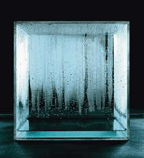
Radically Rethinking the Object of Art
Open Systems: Rethinking Art c.1970 brings together the work of international artists who radically rethought the object of art in the late 1960s and 1970s. The featured artists sought to connect with the increasingly urgent political developments of the decade and make their work more responsive to the world around them. Building on the structures of Minimalism and Conceptualism, they reacted against art's traditional focus on the object by adopting experimental aesthetic 'systems' across a variety of media including photography, dance, performance, painting, installation, video and film.
The exhibition begins with a room devoted to the cube exploring how artists reacted and rebelled against it. Included is Hans Haacke's Condensation Cube(1963-65) which directly responds to the conditions of the space it is exhibited in thus exploring the direct relationship between an object and its environment. Also presented are key installations from this period, including Hélio Oiticica's Projecto Filtro - Para Vergara New York 1972, Gordon Matta Clark's collaborative work Anarchitecture (1974) and Mel Bochner's Measurement: Room (1969).
Posted by jo at 10:47 AM | Comments (0)
April 28, 2005
Tout-Fait

Marcel Duchamp
Tout-Fait: The Marcel Duchamp Studies Online Journal, is the first academic journal in electronic format devoted to Marcel Duchamp (1887-1968) and his peers. The term "tout fait," the standard French translation for "ready-made", was a phrase used by the French mathematician Henri Poincaré (1854-1912), whose influence on Duchamp was crucial. Thus, Tout-Fait not only represents the intersection between art and science, but serves as a site promoting the interdisciplinary study across diverse fields of scholarship.
Tout-Fait brings together international scholars and writers from art and science backgrounds and many other fields of study. An interdisciplinary project, Tout-Fait is committed to presenting a variety of news features, articles, interviews, and short notes relating to Duchamp, one of modern art's most important figures, and his circle of contemporaries. [via loreto martin]
Posted by jo at 08:04 AM | Comments (0)
April 26, 2005
The HUB

One Instrument, Many Parts
The HUB, a group of composer/performers, were among the first to practice network music. The Hub is a computer network band. Six individual composer/performers connect separate computer-controlled music synthesizers into a network. Individual composers design pieces for the network, in most cases just specifying the nature of the data which is to be exchanged between players in the piece, but leaving implementation details to the individual players, and leaving the actual sequence of music to the emergent behavior of the network.
Each player writes a computer program which make musical decisions in keeping with the character of the piece, in response to messages from the other computers in the network and control actions of the player himself. The result is a kind of enhanced improvisation, wherein players and computers share the responsibility for the music's evolution, with no one able to determine the exact outcome, but everyone having influence in setting the direction.
The Javanese think of their gamelan orchestras as being one musical instrument with many parts; this is probably also a good way to think of The Hub ensemble, with all its many computers and synthesizers interconnected to form one complex musical instrument. In essence, each piece is a reconfiguration of this network into a new instrument. (Perkis)
The Hub, formed in 1984 in and around San Francisco, by Tim Perkis, John Bischoff, Scot Gresham-Lancaster, Phil Stone, Chris Brown, and Mark Trayle, used a network approach to improvisation, where each player controlled an aspect of the same compostion.
Posted by jo at 09:30 AM | Comments (0)
April 21, 2005
Participation TV
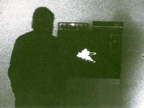
TV as Interactive Canvas
"In 1963, «Participation TV I» (by Nam June Paik) passed the qualifying rounds at the «Exposition of Music—Electronic Television» exhibition in Wuppertal [where, in the case of a few devices, acoustic signals already determined the television image]. [«Participation TV I»] concerns a purely acoustic-oriented type of «Participation TV,» with an integrated microphone. The later version serves a television showing in the middle of its screen a colored bundle of lines which explosively spread out to form bizarre-looking line formations the moment someone speaks into the microphone or produces any other type of sound. Depending on the sound’s inherent quality or volume, the signals are intensified by a sound-frequency amplifier to produce an endless variety of line formations which never seem to repeat themselves or be in any way predictable." (Source: Edith Decker, Paik Video, Cologne, 1988, p. 64) [from Medien Kunst Netz; see related texts]
Posted by jo at 10:52 AM | Comments (0)
April 18, 2005
Radical Software
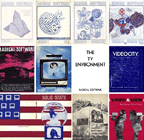
Video Art
"Radical Software was an important voice of the American video community in the early 70s; the only periodical devoted exclusively to independent video and video art at the time when those subjects were still being invented. Issues included contributions by Nam June Paik, Douglas Davis, Paul Ryan, Frank Gillette, Beryl Korot, Charles Bensinger, Ira Schneider, Ann Tyng, R. Buckminster Fuller, Gregory Bateson, Gene Youngblood, Parry Teasdale, Ant Farm, and many others.
Eleven issues of Radical Software were published from 1970 to 1974, first by the Raindance Corporation and then by the Raindance Foundation with Gordon and Breach Publishers. PDF files, opened with the popular application Adobe Acrobat Reader, can be downloaded and stored on a recipient's hard drive for later use. They can be enlarged, reduced, and zoomed in on. The recipient can not only read the text and view the graphics, but also view the original page layout."
Posted by jo at 08:26 AM | Comments (0)
April 15, 2005
Movie-Drome
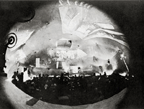
Network-Dependent Events
"Influenced by Buckminster Fuller’s spheres, (Stan) VanDerBeek had the idea for a spherical theater where people would lie down and experience movies all around them. Floating multi-images would replace straight one-dimensional film projection. From 1957 on, VanDerBeek produced film sequences for the Movie-Drome, which he started building in 1963. His intention went far beyond the building itself and moved into the surrounding biosphere, the cosmos, the brain and even extraterrestrial intelligence." [links to related texts]
BIOGRAPHY
Born in 1927—died in 1984. VanDerBeek studied art and architecture first at Cooper Union College in New York and then at Black Mountain College in North Carolina, where he met architect Buckminster Fuller, composer John Cage, and choreographer Merce Cunningham. VanDerBeek began his career in the 1950s making independent art film while learning animation techniques and working painting scenary and set designs for the American TV show, «Winky Dink and You.» His earliest films, made between 1955 and 1965 mostly consist of animated paintings and collages, combined in a form of «organic development.»
VanDerBeek's ironic compositions were created very much in the spirit of the surreal and dadaist collages on Max Ernst, but with a wild, rough informality more akin to the expressionism of the Beat Generation.
In the 1960s, VanDerBeek began working with the likes of Claes Oldenburg and Allan Kaprow, as well as representatives of modern dance, such as Merce Cunningham and Yvonne Rainer. Building his Movie Drome theater at Stony Point, New York, at just about the same time, he designed shows here using multiple projectors. These presentations contained a very great number of random image sequences and continuities, with the result that none of the performances were alike.
His desire for the utopian led him to work with Ken Knowlton in a co-operation at the Bell Telephone Company laboratories, where dozens of computer animated films and holographic experiments were created by the end of the 1960's. At the same time, He taught at many universities, researching new methods of representation, from the steam projections at the Guggenheim Museum to the interactive television transmissions of his «Violence Sonata» broadcast on several channels in 1970. [via Medien Kunst Netz]
Posted by jo at 07:13 AM | Comments (0)
March 22, 2005
John Cage's 4'33" Revisited
CLICK ON IMAGE TO PLAY MOVIE [Format: MP4 38.5mb]
BBC 4, 2004 (9:22), January 15, 2004. [via UbuWeb]
Radio 3 plays 'silent symphony'
BBC Radio 3 has aired more than four minutes of complete silence... by design. The BBC Symphony Orchestra gave a performance of composer John Cage's seminal piece 4'33", which does not contain a single note. Radio 3 broadcast the entire composition live, even having to switch off its emergency system that cuts in when there is apparent silence.
The performance took place on Friday night at London's Barbican Centre. It was part of a weekend of Cage's work. The late avant-garde composer "wrote" the piece in 1952. TV viewers were also able to watch the event when BBC Four broadcast the concert, which also featured works that music lovers could hear.
Cage's reasoning for composing 4'33" was to demonstrate that "wherever we are what we hear mostly is noise". Mostly what you could hear was people getting up and walking out. BBC Symphony Orchestra general manager Paul Hughes of the 1952 premiere. His estate won a bizarre copyright battle in 2002, when composer Mike Batt agreed to pay a six-figure sum to a charity because his album featured a tongue-in-cheek silent track which he credited as co-written by Cage.
General manager Paul Hughes told BBC Radio 5 Live the orchestra had rehearsed to "get in the right frame of mind". Despite having no notes to play, the musicians tuned up and then turned pages of the score after each of the three "movements" specified by the composer. The silence was broken at times by coughing and rustling sounds from the audience, who marked the end of the performance with enthusiastic applause.
Mr Hughes denied the performance was a "mindless gimmick" and said Cage believed "music was all around us all the time" and the piece was his attempt to make the audience focus on sounds that were "part of our everyday lives".
'Discomforted'
But the audience at the premiere in 1952 was "so discomforted that mostly what you could hear was people getting up and walking out", he said. "They were completely outraged and extremely angry," Mr Hughes added. He said Cage, who died in 1992 aged 80, was very proud of the silent composition. In readiness for the performance, Radio 3 bosses switched off their emergency back-up system - designed to cut in when there is an unexpected silence on air.
Posted by jo at 03:49 PM | Comments (0)
UBUWEB
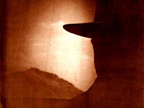
37 Short Fluxus Films
UbuWeb is pleased to present 37 Short Fluxus Films. Dating from the sixties and compiled by George Maciunas (1931-1978, founder of Fluxus), this is a document consisting of 37 short films ranging from 10 seconds to 10 minutes in length. These films (some of which were meant to be screened as continuous loops) were shown as part of the events and happenings of the New York avant-garde.
Starting in the early sixties, Fluxus followed in the footsteps of the Futurist and Dada avant-gardes, going against the established grain of Fine Art and Official Art and promoting imposture as an aesthetic dimension. Fluxus interdisciplinary aesthetic brings together influences as diverse as Zen, science, and daily life and puts them to poetic use. Initially received as little more than an international network of pranksters, the playful artists of Fluxus were, and remain, a network of radical visionaries who sought to reconcile art with life.
Films by Nam June Paik, Dick Higgins, George Maciunas, Chieko Shiomi, John Cavanaugh, James Riddle, Yoko Ono, George Brecht, Robert Watts, Pieter Vanderbiek, Joe Jones, Eric Anderson, Jeff Perkins, Wolf Vostell, Albert Fine, George Landow, Paul Sharits, John Cale, Peter Kennedy, Mike Parr, Ben Vautier. (16 mm, b&w/color, 120 minutes, 1962 - 1970).
Posted by jo at 10:29 AM | Comments (0)
March 21, 2005
THREE CITIES
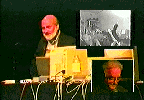
MULTIMEDIA TELE-CONCERT
Featuring Morton Subotnick, David Rosenboom, Steina Vasulka with Leo Smith and J.B. Floyd. The three part evening began with a performance by Morton Subotnick, in New York, who played the Yamaha Disklavier in Santa Monica using finger controlled midi triggers. The second part of the evening was a bi-coastal tele-collaborative concert between David Rosenboom, Dean of the CalArts School of Music in Santa Monica, and pianist B. Floyd and trumpet player Leo Smith in New York City. In each city there were two Disklavier pianos, the one played by the local artist, the second one playing the notes activated by the pianist in the other city. The third part of the evening featured Seina Vasulka in Santa Fe playing a MIDI violin which controller laser videodisk players in both New York and Santa Monica.
As she played her violin in Santa Fe she controlled and selected sections of the videodisk showing her playing the same piece 20 years earlier. Also during the course of the evening we took the Santa Monica and New York audiences through a tour of Netscape-based World Wide Web sites on the Internet and discussed the implications of performing artists disseminating their work and working together through this medium. This is an example of many years of collaboration between ECI, Mort Subotnik, David Rosenboom, Mark Coniligo, and CalArts. This collaboration continues with the hope of showcasing at least one "State-Of-The-Art Tele-collaborative Music Performance a year working with the leading avant-garde musicians of our time. See additional Electronic Cafe projects from 1984-1998 here.
Posted by jo at 07:37 AM | Comments (0)
February 25, 2005
the FluxusPerformanceWorkbook
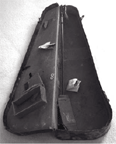
Performances in Musical Form
"The first examples of what were to become Fluxus event scores date back to John Cage's famous class at The New School, where artists such as George Brecht, Al Hansen, Allan Kaprow, and Alison Knowles began to create art works and performances in musical form. One of these forms was the event. Events tend to be scored in brief verbal notations. These notes are known as event scores. In a general sense, they are proposal pieces, propositions or instructions.
The first collections of Fluxus event scores were the working sheets for Fluxconcerts. They were generally used only by the artist-peformers who were presenting the work. With the birth of Fluxus publishing, however, colections of event scores soon came to take three forms..." From the introduction to the FluxusPerformanceWork book edited by Ken Friedman, Owen Smith and Lauren Sawchyn.
Posted by jo at 06:00 PM | Comments (0)
February 24, 2005
The New Performer: Data as Performer and Performance
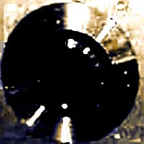
In Pursuit of the Virtual Performer
"The nature of all performance includes the elements of time-based experience and space as "stage". I use the term "stage" as a simple reference point to describe the space in which a performer performs and not as reference to the theatre. The nature of performance in the computer age includes these elements of time and stage as space. A simple definition of performance is : that which is feigned or pretended. It is action. It is speech. It is anything performative. The nature of the performer includes any entity who/which feigns, pretends, acts, and speaks. So, it is natural to include non-human entities, such as robots, cyborgs, and databases in this discussion of performance. Baudrillard might describe performing and the performer as more real than real, so real that they are virtual. "Of course we have a multitude of objective, real proofs, but what does one do with historical reality in a system which itself has become virtual? "(1)
New media's complex nature has influenced the nature of performance to become something many don't consider performance. Anything involving action, interaction, time, and space is performance. Therefore, performing is both real and virtual, becoming more real than real through the very nature of simulation. Performance on and of the net includes everything from virtual actors (interactors) interacting with real actors, Moos, Mud's, Mucks, Games, Chat groups, telepresence, Database as performance. The performer is data. The performer is virtual. The history of virtual performance begins with interaction between the real and hyperreal in time-based experience in a space referred to as the stage." From The New Performer: Data as Performer and Performance by Sheila A. Malone.
Posted by jo at 08:11 AM | Comments (0)
February 22, 2005
Experiments in Art and Technology (E.A.T.)
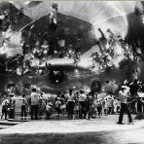
One Forgotten History of Transdisciplinarity
"At a recent meeting of PLAN I mentioned E.A.T. and drew a number of blank looks-so here is one forgotten history of transdisciplinarity and early locative projects:
Experiments in Art and Technology was founded in 1966 by engineers Billy Klüver and Fred Waldhauer and artists Robert Rauschenberg and Robert Whitman. The non-profit organization developed from the experience of 9 Evenings: Theatre and Engineering. This event, which was held in October 1966 at the 69th Regiment Armory in New York City (U.S.), brought together 40 engineers and 10 contemporary artists who worked together on performances that incorporated new technology. It became clear that achieving ongoing artist-engineer relationships would require a concerted effort to develop the necessary physical and social conditions. E.A.T. saw itself as a catalyst for stimulating the involvement of industry and technology with the arts. [blogged by Martin Rieser on Mobile Audience]
The organization worked to forge effective collaborations between artists and engineers through industrial cooperation and sponsorship. Membership was opened to all artists and engineers, and an office set up in a loft at 9 East 16th Street in New York.
Artists and the art community responded enthusiastically to E.A.T. By 1969, given early efforts to attract engineers, the group had over 2,000 artist members as well as 2,000 engineer members willing to work with artists."
Related: Whitman's Phones; PLAN Notes; and On Locative Media's European Reception.
Posted by jo at 02:04 PM | Comments (0)
February 17, 2005
THE A - Z OF INTERACTIVE ARTS
![]()
From Double Gaze to Telenoia
Double Gazing: Just as we see, hear, and feel in ways unknown directly to biological man, we also now live in an environment which increasingly hears, sees and feels us. With computer laser tracking of our retina, the artist's gaze is returned. The walls will indeed have ears, and buildings will speak volumes.
Interactivity: Trivial and non-trivial. The first is a closed system with a finite set of elements. The second is open ended and infinite in its capacity to accommodate new variables.
Telematic Imperative: When there's no more geographical boundaries, territorial aggression is as irrelevant as polarised politics. The only imperative is to connect. Nowadays even the self is permeable.
Telenoia: Computer-mediated, distributed mind-at-large: asynchronous global connectivity. In celebrating telenoia we reject the individualism of the old industrial culture- solitary, anxious, alienated, neurotically private. Telenoia replaces paranoia in the telematic culture.
From THE A - Z OF INTERACTIVE ARTS by Roy Ascott, Leonardo Electronic Almanac, Volume 3, No. 11, November 1995
Posted by jo at 08:35 AM | Comments (0)
From A to D and back again:
![]()
The Emerging Aesthetics of Interactive Art
"...Screen-based 'hypertextual works', 'instrumented physical spaces' and 'mapped virtual and real environments' are three new genres. Another 'dimension' can be added to each of these by the inclusion of fast, wide bandwidth digital communications technologies. We might call this tele-interactivity. There are identifiable sub-genres, in which the interaction is: between people geographically separated; between a person and a machine, geographically separated; or between people geographically separated at a virtual site.
The first we might call 'teleconferencing art'. Paul Sermon has produced provocative works in this vein, such as Telematic Dreaming...A second sub-genre utilises the idea of teleoperation. Eduardo Kac and Ed Bennett's Ornithorinco allows a user to teleoperate a robot (over phone lines) to explore an environment.
More provocatively, Stelarc's recent Fractal Flesh project allows his body to be teleoperated over the net. In both these works some aspect of the user (vision, volition) is extruded over the communication network to 'be' in another place. A third sub-genre (exemplified by Agnes Hegedus' Fruit Machine) allows multiple remote users to cooperate in tasks in a shared virtual environment.
The sudden explosion of networked multimedia (via the World Wide Web) has finally realised the dreams of the pioneer network artist of the mid eighties, (though this realisation has a decidedly commercial cast to it). A recent network project by the Berlin based Art+Com group, T-Vision is on the one hand chillingly panoptical, on the other it demonstrates coordinated global data retrieval in a way that the WWW only hints at. "T-Vision" offers a radical new paradigm of computation. In this work, a user rolls a beach-ball sized trackball, and a globe of the world presented on the screen, rolls correspondingly. This image is made up of a patchwork of satellite and aerial photos. This world can be zoomed. In some cases one can zoom from the entire globe down to a city street in one smooth swoop. In one case, one can zoom into the Art+Com office, and look through a video camera pointing out the window, and see real time video action! "T-Vision" can utilise the entire internet, drawing on dispersed databases for its images, so that the globe is continually updated, even to the extent of real time video, if available..."
From From A to D and back again: the emerging aesthetics of interactive art by Simon Penny, Leonardo Electronic Almanac, Volume 4, No. 4, April 1996.
Posted by jo at 08:30 AM | Comments (0)
February 10, 2005
Corpos Informáticos
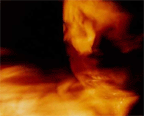
Bodies Re-Dimensioned by Technology
"The research group Corpos Informáticos was created at the University of Brasília (Brazil) by researchers, professors and students from the Visual and the Dramatic Art Courses in 1992. The central concern of this research...is the human body mediated by technologies: the existing human body is daily crossed over by imperceptible or perceptible technical elements from the most tender age; the body of the other is constructed in the same way - the image of other bodies (spectral) also makes us aware of our own – printed, broadcast, distorted, corrected images…one that becomes object of desire, desire of being, desire of becoming, and yet desire of manipulating, of possessing; our bodies and their prostheses – be them means of locomotion, reading, seeing, hearing, or creating – all of them are somehow interactive; finally, bodies constantly re-dimensioned by new technologies, and soon new bodies, new consciences." From Performance Art and Digital Bodies by Maria Beatriz de Medeiros.
See also:
Performative Sites: Intersecting Art, Technology, and the Body
Performance Art in Telepresence: Information and Communication in the World Net of Computers
Performance in Telepresence: the Body in Telepresence
Tenouous Border of the Performance Artistic Language, its Possibilities Within Technological Means
Posted by jo at 08:13 AM | Comments (0)
February 09, 2005
Performance in Plato’s Cave
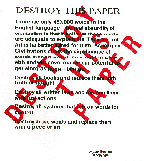
Three Distinct Performances
On Saturday, April 24th, 1999 at 9:24 and 21 seconds, a portion of the Performance in Plato's Cave was transmitted over the internet. In an attempt to follow the Plato’s Cave Performance we have to realize that there are three distinct performances going on simultaneously.
1. The Fake Performance was made to transmit from another location over the Internet in case the equipment failed at the Cleveland Performance Art Festival. The equipment did fail and the fake was transmitted; 2. The Environmental Performance was Alice in Wonderland's tea party adapted to a modern world environment. This also is the Internet Performance; The Non-Performance was a preparation for a conventional performance that would not occur.
To do an Internet Performance you have to get an audience...My goal was to get one viewer...The counter/trackers indicated that at least five people hit the site at the time of the performance.
Posted by jo at 11:43 AM | Comments (0)
January 31, 2005
Mail Art
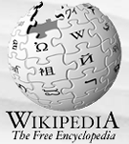
Early Networked+Distributed Art
In an earlier post, telecommunications art pioneer Robert Adrian was quoted: "...it was Mail-Art with its concept of postal space - a blizzard of images circling the globe through the integrated postal services - that made it possible to conceive of artworks in the electronic space of the new networks." Here's Wikipedia's definition and history of Mail Art:
Mail art is art which uses the postal system as a medium. Mail art is also, simultaneously, a message that is sent, the medium through which it is sent as well as one of the longest-lasting art movements in history. To be precise, an amorphous international mail art network evolved of thousands of participants in over fifty countries between the 1950s and the 1990s from the work of Ray Johnson and influenced by earlier groups, including Dada, the Surrealists and Johnson's contemporaries in the Fluxus group. Mail artists characteristically exchange ephemera in the form of illustrated letters, zines, rubberstamped, decorated or illustrated envelopes, artist trading cards, postcards, 'artistamps', mail-interviews and three-dimensional objects.
Posted by jo at 12:46 PM | Comments (0)
January 26, 2005
Documenta 6 Satellite Telecast
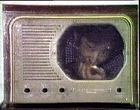
An Homage to Global Communications
Documenta 6 Satellite Telecast, by Joseph Beuys, Douglas Davis, and Nam June Paik; Video; 30 min, color, sound, 1977. Available at Electronic Arts Intermix:
"In 1977, Documenta 6 featured the first live international satellite telecast by artists. Performances by Nam June Paik, German conceptual artist Joseph Beuys, and Douglas Davis were transmitted to over twenty-five countries. Paik and Charlotte Moorman are seen live from Kassel in Fluxus-inspired collaborative performances, including TV Bra, TV Cello, and TV Bed. They fuse music, performance, video and television in an homage to global communications. Also from Kassel, Joseph Beuys presents a direct address to the public, elaborating on his utopian theories of art as "social sculpture," which were crucial to his conceptual project. From Caracas, Venezuela, Davis performs The Last Nine Minutes, a participatory piece in which he addresses the time/space distance between himself and the television viewing audience."
Posted by jo at 11:12 AM | Comments (0)
January 20, 2005
E L E C T R O N I C S P A C E
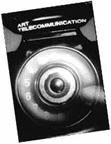
Telecommunications Projects: Robert Adrian
"...products or objects resulting from a telecommunications project are mere documentary relics of an activity that took place in the electronic space of a network. But this kind of problem had already been confronted during the 70's by performance artists who found that their work had been reduced to scrapbook photos, card files and dinner party anecdotes.
The electronic space in which telecommunications artists - along with transnational corporations, stock markets and the military - operate is a complicated concept made possible by another phenomenon of art in the 1970's ... conceptual art. Conceptual art demands a conceptual space in which to exist and a culture that has grasped that elusive notion will have no trouble at all de-materialising its power structures into something as relatively concrete as the electronic space of international electronic communications networks.
But, although Performance Art had shown how artworks could be related to duration (time-based) and Conceptual Art had shown how they could be located in conceptual space (dematerialised), it was Mail-Art with its concept of postal space - a blizzard of images circling the globe through the integrated postal services - that made it possible to conceive of artworks in the electronic space of the new networks." Robert Adrian
Nettime Interview with Tilman Baumgaertel
AudioHyperspace Interview with Sabine Breitsameter
Posted by jo at 02:50 PM | Comments (0)
January 19, 2005
Trekhprudny Lane

A Waste of Time and Money
Photo (left): MOSCOW 16.1.1992, by Alexander Gormatiuk, Vladimir Dubosarsky, Avdey Ter-Oganian, and Alexander Kharchenko: A tour guide was hired to guide the public with a megaphone on a four hours bus trip around Moscow. The trip included all the typical Moscow sight-seeings as well as some carefully selected liquor stores and it finally ended up where it had started, at the Trekhprudny Lane.
"The history of Trekhprudny Lane began in 1990, right after the end of the "USSR boom" in Western art institutions and shortly before the collapse of the USSR. Avdey Ter-Oganian arrived in Moscow from a provincial Town called Rostov-on-Don, together with some artist-friends in order to conquer Moscow with their artist-group called "Art or Death". The artists squatted a building on Trekhprudny Lane, a street in the center of Moscow, where they installed individual studios and a gallery space in common. They defined their gallery program as a "waste of time and money" and enjoyed their burlesque weekly openings together with the Moscow art community that soon found its way to Trekhprudny Lane." Kristofer Paetau [via Rhizome]
Posted by jo at 02:31 PM | Comments (0)
January 04, 2005
Historical Summary
What We Learned
Exactly when is the "live" performance of the pre-recorded video presentation? What space is the artist occupying, the loft or the circulatory system of the Internet itself? Live "chat" was being received by the Pseudo chat jockey from viewers around the world. After the "live" show was performed, the streaming video image was saved on Pseudo's server for six months. This event could subsequently be viewed "on demand" from any point on the globe with a live Internet connection for as little or as long a time as the viewer chose, adding yet another dimension to time and space as embodied by art on the Internet. Read Martha Wilson's essay.
Posted by jo at 07:04 AM | Comments (0)
December 29, 2004
Questioning the Frame
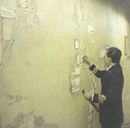
Thoughts about maps and spatial logic
"...Terms such as "mapping," "borders," "hacking," "trans-nationalism," "identity as spatial," and so on have been popularized in recent years by new media theories’ celebration of "the networks"—a catch-all phrase for the modes of communication and exchange facilitated by the Internet.
We should proceed with caution in using this terminology because it accords strategic primacy to space and simultaneously downplays time—i.e., history. It also evades categories of embodied difference such as race, gender and class, and in doing so prevents us from understanding how the historical development of those differences has shaped our contemporary worldview.
..." Read full article Questioning the Frame: Thoughts about maps and spatial logic in the global present by Coco Fusco, In These Times, December 16, 2004. Responses to the article culled from Locative and nettime:
Responses to the article culled from locative and nettime:
Date: Thu, 16 Dec 2004 22:26:27 +0000
From: Pall Thayer
Subject: [Locative] Questioning the Frame
To: locative@x-i.net
hmmm.... I just wish she would mention some of the mapping projects she's talking about. She really seems to have a narrow understanding of what artists are doing with locative media. She seems to suggest that one of the problems is that the artists have too much control over the social picture that the maps portray. And other artforms don't? I'm going to have to read this through a couple of times to make sure I really understand what she's saying but after a couple of scans it really looks rediculous and I almost get the feeling that she regrets not being a "hacker".
Pall
Ewen Chardronnet wrote:
well, she always comes with interesting art critics and post-colonial discourses, but use same dialectics each time. I remember reading same dialectics in her critics on "art and science" hipe and "critical art ensemble trial" hipe. And now the "locative media" hipe... You can be sure there will be a critic on "pervasive arts" and "space arts" soon, etc. and of course better if those arts are done by white male artists
E.
Date: Thu, 23 Dec 2004 17:08:14 +0100 (CET)
From: Brian HOLMES
Subject: [Locative] A Reply to Coco Fusco
As a critic it's important to read your peers, and try to assess the pertinence of your own work in the mirror of theirs. So I was curious to read Coco Fusco's recent article on mapping [www.inthesetimes.com/site/main/article/ questioning_the_frame]. However, I must say that her continuous assertions of cultural authority leave me feeling highly ambivalent. On the one hand, the threads of historical memory she brings up are extremely welcome. On the other, her unwillingness to engage with current conditions and projects tends to reduce the past to a complaint: Why isn't it the present anymore?
It's true that the raw fact of being older than the majority of the people in a given crowd can make you feel uncomfortably lucid. When I went to a conference on so-called "locative" or GPS-based media at the RIXC center in Latvia, I found most of the projects quite naive, developing a few stylistic traits of situationist psychogeography in the absence of any geopolitical critique of power relations, or any philosophical critique of instrumental rationality. In effect, a Cartesian worldview has been built into the computerized technology of graphic information systems, which are undergirded by megaprojects of military origin, or what I call "imperial infrastructure." But rather than just giving a disciplinary lecture with all the answers stated in general terms, I tried to show how changing conditions had made the once-subversive traditions of psychogeography quite superficial, to the point where the aesthetic forms the artists were using seemed to render the very infrastructure of their projects invisible. And when I recently published that paper out of context in Springerin, I took the time to name all the artists and projects in question, so as to establish the precise referents of the critique [springerin.at]. I wish Coco Fusco would make that kind of minimal effort, as it would bring her sharp observations into contact with actual projects, and open up a space of possible transformation.
More to the point: When I began my work on mapping, about four years ago now, as a direct result of involvement in demonstrations against the policies of the WTO and IMF, I too felt that the most important reference was the history of the Third World movements of national liberation, in their relations to the Western civil rights and new left movements of the 60s and 70s. In an early text that was finally published in the book Moneynations, I tried to show how the very concept of the Third World, and then above all, the reality of the Movement of Non-Aligned Nations, acted to open up new imaginary and real spaces within the dominant bi-polar map of the Cold War [http://2002.memefest.org/en/defaultnews.cfm?newsmem=15]. I asked the question whether the emergence of the World Social Forum in Porto Alegre could be compared to the Bandung Conference in 1955. Obviously, the answer was that it could not: both because the current antisystemic movements do not (yet) have the strength that Bandung represented, and because the operative modes of opposition may well have changed fundamentally since 1955.
The global importance of the Third World movements lay in the new kinds of international solidarity that they helped provoke. But something important remains unstated in Fusco's references to these movements, and this is the fact that the major links that tied them to the First World do not exist anymore (nor, indeed, do the movements themselves, for we are talking about specifically national movements in the period of decolonization). One of these links was an aspiration to create a non-Stalinist form of communism, according to the examples given by the successful Cuban and Vietnamese guerrilla insurgencies, and also by Yugoslav self-management (one must remember that the non-aligned movement came officially into existence in Belgrade). Another powerful link was the notion of cultural authenticity, or inherent difference from the Western norm, as a liberating foundation upon which newly independent nations could be built. This Third World concept served as a basis for the struggles toward a multicultural society in the First World. Today, however, the egalitarian aspiration to a self-managed communism has no objective touchstone in reality, leaving those who feel its lack in a deep state of ideological disarray. At the same time, the notion of cultural authenticity has been largely usurped by nationalist or fundamentalist projects which, although they have fortunately not eradicated all work towards equal rights in a multicultural society, have nonetheless made it very difficult to raise the banner of cultural or ethnic difference as a rallying-point for international solidarity.
Instead of relying on the old internationalist slogans (Third Worldist or proletarian), the transnational movements of dissent that gathered strength throughout the 1990s tried to use the communicative power of the discourses of human rights that had gained currency in the 80s, largely through the resistance of people in the former Eastern bloc to totalitarianism, and in Latin America to dictatorship. It was subsequently necessary, in the late 90s, for the Western participants in these transnational movements to take the further step of putting their own bodies on the line, of taking direct action against the international economic institutions, in order to go beyond the abstract character of the human rights discourse. This was a way of responding, in the overdeveloped countries, to the sacrifices of the many "IMF riots" that had been held, often at great cost of life, in what was now being called the Global South. Anyone who believes this step was taken by middle-class white kids acting on internet fantasies, in the absence of direct input from social movements around the world, quite obviously didn't go to any of the demonstrations and paid no attention to the planning process or the reports.
The point, however, is not to suggest that a brief flare-up of worldwide protest has brought about any substantial change. It is rather to recall what a difficult and long-term effort is really needed, both to grasp the way that transnational state capitalism now functions, and to articulate large-scale resistance. When Josh On [www.theyrule.net] or Bureau d'Etudes [http://utangente.free.fr/index2.html] make their complex charts of contemporary power relations, one can be assured that the cold and abstract character of the results is very painful to them. I can testify, particularly in the second case, that they are acutely aware of what is missing from such documents: namely, some affective indication of resistance from below, who does it, how they work and why. What has been achieved in such cartography projects, however, is a contribution to the very large-scale effort to rebuild a critical grasp of the oppressive forces that create the dominant map of the world. This kind of power-mapping is a necessary prelude to any effective resistance or counter-proposition. The fact that the difference between such efforts and the current military maps used by the Pentagon does not appear clearly on American TV is hardly something you can blame the artists for! There is a difference between general culture critique and constructive critique directed toward people carrying out specific projects.
Somewhat like Coco Fusco, I often wonder why contemporary artists appear so broadly unable to infuse the dominant map with representations of - or even better, direct links to - the many and diverse dissenting groups and alternative philosophies that are now emerging in the world, or that have remained active over decades. Unlike Coco Fusco, however, I don't think it's useful or necessary to berate artists today for not having been born earlier. The great philosophical frameworks of national liberation and egalitarian self-management that were able to articulate far-flung resistance movements in the past are inoperative in our time. The urgency is for real individuals of all generations, on all continents, to put their heads and hearts together and create new articulations. The specific job of writers and organizers is then to give those articulations conceptual clarity and popular currency, so that they can effectively challenge the absurd world-views presented on American TV.
As to artists, for whom the naked power structures of the contemporary world must now be quite visible, I encourage them to delve more deeply into the diverse efforts that are being made to resist the imposition of a homogeneous control structure on the entire world. This requires looking outside the boundaries of class, ethnicity and nationality, as certain artists and intellectuals of previous generations effectively did. To live up to the great examples of the past then means imagining something quite different for the future. Need it be said that certain kinds of imagination can serve as the first steps towards a transformation of reality?
Date: Fri, 24 Dec 2004 04:13:32 +0000
From: Saul Albert
Subject: Re: [Locative] A Reply to Coco Fusco
To: Brian Holmes
Hi Brian,
I read both Coco Fusco's piece and your response with interest and a little bemusement. You addressed the lazy generality of CF's rant very well, and touched on a couple of things that provoked me to write back:
Firstly, can we please get away from technological determinism?
Yes, the use of military-industrial technology can be problematic, but that criticism in your text is as widely and as targetlessly applied as Coco Fusco's. Many people are using these technologies (GPS/mobile phones/internet/high-tech gizmos), the social movements that you use as your reference points as much as anyone. In fact, it's not like we really have the choice about using these technologies , being subjects in a technocracy... and it's only out of the appropriation and reuse of these technologies that critique can form and attempt to reconfigure the social and political relations that produced them in the first place. Even on a non-technical level, using these technologies and observing their effects and deployment has been instrumental in the development of a number of political discourses: information and affective labour, precarity, [cyber]feminism etc. The critique develops as much from practice as practice develops from critique.
example: London Free Map - http://uo.space.frot.org/?node=LondonFreeMap
http://chinabone.lth.bclub.org.uk/albums/misc/london_free_map.sized.jpg
Jo Walsh and Schulyer Erle have been working on the 'London Free Map' This project encourages participants to walk, drive, cycle or skate through city streets with GPS units and then use the 'traces' of points representing latitude and longitude that these devices generate to help create publicly licensed geodata. They are also working on adapting existing open source software to enable people to annotate and extend these maps in a very flexible way. The example linked to above shows straight lines representing GPS traces made wandering the streets of Limehouse, East London, an area undergoing a huge urban regeneration process in preparation for the proposed Olympic games in 2012. The labeled points are the locations and names of approved planning permission applications made to the London Borough of Tower Hamlets in the last five years, automatically retrieved from the council's website and plotted onto a scanned out-of- copyright historical map of the area from 1916. This is just one potential use of the London Free Map, a way of visualising physical and historical changes to a space undergoing a huge social and economic upheaval. The potential for further uses and the development of new, as yet unimagined maps from this project seems evident.
Secondly, I found the distinction between these technologically specific, less overtly political projects, and the 'power-mapping' practices of (the wonderful) Bureau D'Etudes and many many others to be a bit thin. I know you share their frustration at having to use the language of power to map power, but the problem is not just in the inability of this form to represent the fertile heterogeneity of the social movements. 'Power mapping' deals in the currency of power, and its representational structure can reinforce the dynamics of the relationships it represents. More worryingly, the unnerving coherence of these representations can also become ised easily - the currency of power made visual, or (worse) 'data visualisation' knits neatly into artistic and authorial currencies and relationships that can become as reactionary and totalising as the military-industrial technologies you were warning against earlier.
I know you know this, your descriptions of the playfulness of the Bureau's maps illustrates the path they choose out of this bind : 'solidarity with aliens'. But people using similar or derivative techniques seem to embrace the solemnity and darkness of their maps without having the escape pod provided by their humour.
What encourages me about initiatives like the London Free Map and many of the projects in the orbit of the 'locative media lab' is that they often work, on a very basic level, to avoid totalising representations. To some extent this is emerging as an informal agreement on technologies, open Semantic Web standards and other esoterica that I'm not really equipped to explain. Also, many of these projects are based on public workshops, working with people and groups on producing representations of themselves, spaces, movement and relationships. Of course none of this is inherantly interesting. Public workshops and 'open' technologies carry their own wealth of dead ends, vices and travesties, but they certainly are politicised - and politicising, in a very different and more subtle sense than that of 'power maps'. The contingency on input from the map-users is the most obvious distinction between these forms of mapping and the two examples of 'power mapping' you mentioned. Of course this aspect of 'participation' in the making of the map is just as worrying in terms of which currencies it evokes, auteurship and the 'framing' of 'public use' in the interests of pseudo-ehthographic artistic value creation etc. etc.. But the locative media lab's engagement with corporations, the way some of it is like cheap corporate R&D in exchange for getting to use fancy devices, the links with 'community groups' funded and instrumentised by arts bodies, and with governments for use of geodata is all messy, difficult, and suspect, but necessary if the technology, and the discourse are going to develop.
This probably warrants more examples, which I'm too tired to start with now.
I guess the problem is that criticising something is difficult because you have to explain why, whereas blithering pleasantries about things you like is not so demanding.
keep up the good work brian!
X
Saul.
Date: Sun, 26 Dec 2004 23:48:54 -0800
From: John Hopkins
Subject: Re: [Locative] A Reply to Coco Fusco
To: locative@x-i.net
>>Firstly, can we please get away from technological determinism? Yes, the use of military-industrial technology can be problematic, but that criticism in your text is as widely and as targetlessly applied as Coco Fusco's. Many people are using these technologies (GPS/mobile phones/internet/high-tech gizmos), the social movements that you use as your reference points as much as anyone. In fact, it's not like we really have the choice about using these technologies , being subjects in a technocracy... and<<
Why no choice? If no choice, isn't that technological determinism to the extreme degree?
It is an incremental process -- each mile you drive onwards in your fossil-fuel burning device, or crank open the thermostat in the house, that drives the social system further onward in its dominance. (it propels the US military machine a bit further in its desparate mission to secure the true power/energy-base of the social structure that is is an integral part of). each time you don't do those things de-poweres that same system.
each time you watch one minute of centrally organized media you give that structure more power. each time you cross social-structural boundaries and engage an Other human directly, you depower those ordained structures.
hmmm.
JH
Date: Mon, 27 Dec 2004 11:32:20 -0000
From: "Armin Medosch"
Subject: Re: [Locative] A Reply to Coco Fusco
Hi Saul, Hi Brian,
let me first make some sort of disclaimer: I am happy that Coco's article (which I have not read, but can roughly imagine what it contains) triggered this discussion about locative media which was long overdue. I think many people have felt uncomfortable with the unarticulated political 'content' or 'meaning' of locative work but have not spoken in public. One reason for that might be that they felt, as I did, that there is a lot of potential in that field and that the (mostly young) people involved did not deserve to be bashed for all their good intentions, even though those intentions sometimes gave relatively weak results. Finally the lid has been blown off and that is a good thing. I now do neither want to argue for or against Saul or Brian but just throw in my two-pence. I also have to say that writing something really meaningful about that whole area would take at least a day and I simply don't have that time right now. So please excuse the immaturity of my words which are quickly written in a sort of email improvisation which I guess was once the spirit of internet discussions which is now often sadly missed.
Saul said at the very beginning of his reply:
>> Firstly, can we please get away from technological determinism?
What does this statement mean? It is indeed important to 'get away from technological determinism'. But what this statement should not mean is that we should not consider or discuss technological determinism.
Saul continues:
>> Yes, the use of military-industrial technology can be problematic,
I would go further and say that 'can be problematic' is not strong enough. It _is_ problematic, always. The instrumental power that is contained in those technologies is a central issue of our time, and by 'our time' i do not only refer to the last couple of years or so but to the last 50 or even 100 years. Therefore I think such statements about technological determinism and military-industrial technology should not be used to quash any discussion about those issues. Those issues should exactly be the starting point of any discussion about 'locative' projects and indeed media art and net art projects. This is where the media art community has failed over the last 20 years which I was able to witness as a grown up person. It is one of the big failures of that community and possibly one of the reasons why it made so little real progress over that period of time. When I say 'real progress' I of course don't mean technological progress, of which we have seen plenty, but a progress in the social use of those technologies, in their accessability and applicability, in their ability to have an actual impact on the improvements of the situation of people.
I am arguing from a point of view of art that is based on a definition of art whose main reason to be is political. Such an art should be able to transcend the current power system. By 'transcending' i don't refer to metaphysics but to the actual socio-historic situation. In this situation and its projection of possible futures it should open up spaces, spaces for alternative ways of thinking, spaces that offer people different opportunities, for instance to realise alternative viewpoints outside the dominant system, or, more practically speaking, to be able to develop ways of resistance and at least limited ways of autonomy. Of course we cannot ask too much from art and the current level of oppression is so high, the ideology of technological determinism so deeply entrenched that it has become very hard to imagine anything that makes a real difference. But at least people should try. I am afraid I could not see that in most locative projects and in most of the discussions that have been had about the topic so far.
Most of the projects (I am aware that such generalisations without reference to particular projects are always lame but simply have not the time to go through bookmarks and list archives now) simply continue the master trope of the narration of hypermodernity, which is about expansion of technological mastery, coupled with economic growth, all under the banner of 'usefulness' for the people. This is how new communication technologies are being advertised. The mobile phone gives you freedom, it improves your social life, you can use it to form Rheingoldian Smart Mobs and if you put a little FOAF into it you can even realise alternative politicised virtual communities with it. Of course you can do all this stuff, it is even true. But by doing so, you are not leaving the established playing field, a field that has been established by the forces of techno-rationality in the service of capitalism.
I know it is a bit unfair to mention that here but the most significant 'locative' projects in that regard are Blast Theorie's mobile games. The critical content of those projects is nil. The whole thing blew up at futuresonica last year but most people could not read the signs on the wall. Of course their projects are resourceful, maybe well programmed, maybe even entertaining. But they are fundamentally affirmative of the world we live in and completely one-dimensional.
Now, to come back to the core question: it is simply wrong to ask if we are allowed to use military-industrial technologies. of course we should use them (and I do that by simply typing an email) but if we do it matters how we do that. do we contribute to the disguise of the political content of those technologies and thereby continue the positivistic narration of expansion and 'usefulness'? or do we use them to expose that which is always subconsciously present, that in this system, as Herbert Marcuse said 40 years ago, power is transferred into technological systems and that our dependency on those system makes us to their reified subjects? It is a general trait of this society that the powers that be try to cordon off the political. The positive side of things (technological things, gadgets, gps, pda's) gets highlighted but not what comes with it, not this hard to pin down element of power that has become nameless and faceless because
it has been inscribed in, is contained in the technological system.
Now, coming back to locative per se, I think Brian is right to say: "In effect, a Cartesian worldview has been built into the computerized technology of graphic information systems, which are undergirded by megaprojects of military origin, or what I call "imperial infrastructure."
Maybe he ment to say Geographical Information Systems (GIS). GIS combined with GPS and so forth truly signify the victory of Cartesian space over real space. Of course this victory is only a fake victory and never a final victory but it defines the current state of the arts in 'mapping'. Is it therefore forbidden for artists to use GIS? Of course not. The project by Jo Walsh and Schulyer Erle that Saul mentions, 'London Free Map' is a very good example. It is maybe not an art project but that does not matter. It tries to democratize GIS power, democratize in the sense of direct bottom up democracy and not fake vote rigging mind manipulating democracy (oh, that word, can someone suggest a better one?). It is experimental and utopian, it relies a lot on FLOSS and is probably difficult to use for people who are not tech-savvy, but that does not really matter at this point; it does not entertain in the way Blast-ed projects try to but that is effectively its strength. It involves fun, but of a different kind. We need more projects of this kind and we need a discourse that is better able to differentiate between projects that open up those other spaces and projects which simply fall into the technological deterministic trap.
I hope we can begin conversations that are critical and constructive and not about our personality disorders of which we all suffer to a certain degree, necessarily, because they are a function of that system we are subjected to. In this sense I agree that a lot of the 'psychogeography post-situationist' talk sounds naive. But at least it shows a desire to get away from Cartesian space and to reconceptualize the highly regulated spaces we live in. It makes a lot of sense to link FLOSS, art and the history and presence of liberation struggles, but that debate needs updates and rejigging too.
Hoping to be able to talk about those issues in a more elaborate way soon and also hoping to hear from other people now
regards
armin
Date: Tue, 28 Dec 2004 02:21:22 -0800
From: karlis
Subject: [Locative] Don't be shy
To: locative@x-i.net
...Executive Summary:
While studying locative media projects, a computer user realizes the value in talking to people.
Extended Commentary:
A romance of the aesthetic of the internet. Be somewhere, anywhere, it doesn't matter, "jack in" to the internet, and you're home, with your office and your contacts and connections. The presently inhabited city, be it Riga, Ljubljana, or Vancouver, is like wallpaper or decor in a restaurant. The principal interaction with the world is through the internet, and the information available there, the rest is somehow peripheral. So naturally when we approached the ability to make computing mobile and location aware, there seemed to be an answer of integration; finally the drift and nomadism would be informed and fulfulled with the power and potential of the network computer. All your revolutionary fantasies come true. Except the devices are retarded and complicated and expensive; they don't work properly, and they make you into a Steve Mann cyborg, someone more appopriately dressed for a mid 1990's DefCon hacker fair in Las Vegas than any part of life in public.
We tried to simplify the gear and determine what it was supposed to do, which was connect us to the network, make us contextually aware within that network, and informationally aware within that spatial context. The equipment had to be "naturally human", so that it is still possible to interact with the environment and the local culture without handicap.
No cyborg head displays or cybergloves, or star-trek tricorders. It also has to be inexpensive and uncomplicated and break-proof.
A beautiful natural language interface was developed (using selective evolutionary algorithms, no less). Billions of client terminals connected to a global information network have been deployed, planet-wide, that use this natural language interface.
They're called people.
Sitting behind my computer and obsessed with the internet for ten years, I totally missed the obvious connection that local people are connections to the whole network, the network of all information connections which includes the internet but also "old Joe Smith" with whatever he's got to offer. It's the same reason why I haven't needed a watch since I was 15 - someone around me always knows the time. The connection to the network is not limited to a GPS satellite signal reciever and a 2.4GHz wireless internet supercomputer laptop. Rather it's just a link to the next node with different information that what you can access on your own. The easiest, most locative way to access that network is by talking to people, and if these studies are urban, there's going to be people. Forget WiFi and GPS. Ask for directions. Ask the nearest person, or if you're aesthetically driven, ask the nearest good-looking one. If they don't have the answer, they might know someone who does, or can suggest an alternative. If they don't speak your language, they'll likely direct you to someone who does.
Maybe that's should be obvious. But as a bedroom caveman computer hack, to look around and find that this perfect system has already been implemented is amazing. It's multi-modal with multiple redundancies. Ubiquitous. Reliable. All-weather. Fuckable.
Maybe an internet legacy of the military paradigm has poisoned our preconceptions about the reliability and desirability of technology vs people. But if we are nice and friendly and not locally despised imperial soldiers, we don't have to bring all our knowledge in a computer. We can talk to the nearest person.
When I was in an busy new space I formerly looked around and saw great potential for overlaying great collections of information and data or media texture in location, if we could develop the system to realize it.
Now I see that this network is already in place, mobile info nodes are walking all around, ready to be engaged, connected to vast networks of people and information. Standard APIs. It's amazing. Sometimes you have to ask a bunch of times, even before you realize the right question to be asking. But if the information is there, someone has it, and you can find it.
The mention of technological determinism and political action, brought up in the context of locative media, seemed to make this "amazing" revelation relevant again. It has been called a serious political action to find ways beyond the gap between people in the very technically-focused and alienated population. Techno-fetish locative media projects made me realize how important and powerful it is just talking to people.
OK!
cheers
karlis
Date: Wed, 29 Dec 2004 14:15:32 -0800 (PST)
From: coco fusco
Subject:
In response to Geert's request, below is my commentary that was published in IN THESE TIMES recently. The comments were based on my lecture at the School of the Art Institute of Chicago in November, 2004. The series is entitled:
MAPPING / CULTURE / BORDER / HACKING /
and the school's description of the series is:
"This lecture series examines the work of artists, artist-collaboratives, and film/video makers whose works address or proceed from shifts in articulations of global culture, politics of the border and dilemmas of transnational or diasporic identities--identity as a spatial concern. Special attention will be given to artists who use the gesture and organizational logic of mapping, cartographic sciences and the grid to locate identity as well as its displacements."
I found this description so baffling and overladen with jargon that it prompted my response.
I have not had a moment yet to respond to Holmes's post. I found it a bit surprising that he would locate a response to an article in a left-wing Chicago newspaper on a list-serve with a primarily European readership (of his allies, I would add). A decision to locate his response HERE as opposed to THERE seems more like a rallying cry to his nettime readership than an address the substance of my argument or to the public in Chicago, a city with a long and venerable history of community and labor organizing, activist media, and radical black politics.
Coco
Posted by jo at 10:19 AM | Comments (4)
December 27, 2004
netzwissenschaft
![]()
Emerging Infrastructures of All (Inter)net Research
Dr. Reinhold Grether's network research | netzwissenschaft site maps the "emerging infrastructures of all (inter)net research endeavours. net.science as an anthropology of connectivity is trying to overcome the constraints of specialist method transfers on net matters. the protuberance of technical networks necessitates a professionalization of human net knowledge. neither the isolation of concepts as in basic research nor the encapsulation of processes as in applied sciences will ever be able to adequately describe the complex autopoiesis of networks. net.science is undoubtedly developing into a scienza nuova of its own right."
Check out his Mobile Art and Virtual Performance research areas.
Posted by jo at 04:45 PM | Comments (0)
December 08, 2004
The Leonardo Awards Program
![]()
Award Recipients
Leonardo/ISAST, through its Awards Program, recognizes artists and organizations involved in the use of new media in contemporary artistic expression. Artists and organizations are nominated by Leonardo/ISAST Associate Members. The following award recipients have been named:
Steve Mann (Canada) is the recipient of the 2004 Leonardo Award for Excellence. In his winning article, the author presents "Existential Technology: Wearable Computing Is Not the Real Issue" as a new category of in(ter)ventions and as a new theoretical framework for understanding privacy and identity. Mann has written more than 200 research publications and has been the keynote speaker at numerous industry symposia and conferences. His work has been shown in museums around the world, including the Smithsonian Institute, the Museum of Modern Art in New York, the Stedelijk Museum in Amsterdam, the Triennale di Milano and the San Francisco Art Institute. He received a Ph.D. from MIT in 1997 and is now a faculty member at the University of Toronto. Read his Leonardo article [PDF].
Critical Art Ensemble (U.S.A.) are the recipients of a special 2004 Leonardo new Horizons Award for Innovation in recognition of their artistic work in fields such as biotechnology, robotics and tactical media. Their performances and installations have reached viewers around the world and have broken new ground in the often controversial area of new technologies. The Leonardo/ISAST Governing Board voted to give CAE this special award to affirm the principle that artists should engage emerging technologies and be willing to take critical stances that may be at odds with those of the mainstream. Freedom of artistic expression and research form a part of the foundation of an open society. For more information on Critical Art Ensemble, please visit http://www.critical-art.net.
Arthur Elsenaar and Remko Scha (The Netherlands) were the recipients of the 2003 Leonardo Award for Excellence for their article "Electric Body Manipulation as Performance Art: A Historical Perspective," published in Leonardo Music Journal 12. Arthur Elsenaar is an artist and electrical engineer who ran his own pirate radio station and built the transmitters for many illegal radio and television stations throughout the Netherlands. Elsenaar’s recent work employs the human face as a computer-controlled display device. Remko Scha is an artist, DJ, and computational linguist. He has built an automatic electric guitar band ("The Machines"), designed an image generation algorithm ("Artificial"), and developed a theory about language-processing ("Data-Oriented Parsing"). Arthur Elsenaar and Remko Scha have jointly developed a series of automatic performance pieces and video installations that involve computer-controlled facial expression, algorithmic music, and synthetic speech. These works have been presented at scientific conferences, theatre festivals, and art exhibitions throughout Europe and the United States. Elsenaar and Scha also explore the use of automatic radio stations as a medium for computer art. Read their Leonardo article [PDF].
See full list of recipients.
Posted by jo at 11:33 AM | Comments (0)
October 30, 2004
more on radio's history, #2:
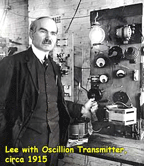
the radio voice
This carries on from the earlier post, more on radio's history, #1.
Marconi’s receivers could pick up morse code – but not the continuous oscillations of the human voice. It was Reginald Fessiden and Lee De Forest who developed the possibilities of continuous wave transmission that would make voice communication possible.
Fessenden, in partnership with Swedish engineer, Ernst F.W. Alexanderson, then working for GE, designed an alternator, a "critical breakthrough in radio technology and elegant evidence of Fessenden's genius in synthesizing his previous work in the electric power industry with his need for a transmitter" (Douglas, Inventing American Broadcasting, 156). By 1906 he had transmitted the human voice over a distance of 10 miles. Fessenden also established an experimental station in Brant Rock, Massachusetts, just south of Plymouth. From there he wrote to phonograph companies asking for a good phonograph and several records, especially recordings of Sousa, Caruso, and violin solos. At 9 p.m., Christmas Eve, 1906, when wireless operators of several United Fruit Company ships in the Atlantic, tipped off to expect something unusual on their NESCO*-provided sets, listened in, they heard Fessenden transmit a recording of Handel’s "Largo" on an Ediphone, play "Oh Holy Night" on the violin, and read from the bible before wishing them a Merry Christmas.
"The Christmas Eve program is still considered the first radio broadcast in American history…" (Douglas, 156).
Lee De Forest, on the other hand, "never shy of borrowing from the work of others" (Douglas), made use of the work of John Ambrose Fleming to produce a device known as "the audion." The prototype of the 3-element vacuum tube, De Forest’s "audion" was able to receive and amplify music and the human voice.
In 1909 De Forest began manufacturing wireless telephone sets for the Navy; and testing each set by means of phonograph records. "Much to my surprise," he wrote later, "many wireless amateurs and professional operators intercepted and enjoyed these test transmissions..." By 1914 he was broadcasting both music and voice from his laboratory north of Manhattan.
In later years, all inventors, Fessenden and de Forest included, would reflect back on their radiophone work as broadcasting. But their major purpose at the time was to make a fortune either by finding a wireless replacement for the wired telephone or by finding an acceptable system the Navy would use for all of their ships.
Between 1912 and 1917, the rights to the continuous wave components these inventors invented were transferred to large corporations like G.E. and AT&T. But while the corporations wrangled over turf and patents, it was "American amateurs [who] unwittingly revealed where the real radio profits lay" (Douglas, 291).
*National Electric Signaling Company, organized in 1902 by Fessenden and his two partners, Thomas Given and Hay Walker, Jr.
Posted by newradio at 10:15 AM | Comments (0)
October 08, 2004
flow

It's the Moment of Connection
Researching the early history of telematic art, I came across an interview with Robert Adrian by Jeremy Taylor, the Digital Archivist working on contract at Open Space.
Adrian is a Canadian artist based in Vienna who began work in telecommunications in the late '70s. In 1982 he designed his first major telecommunications art project, "The World in 24 Hours," a global multimedia linkup involving 24 cities and using fax, email, and slow scan-video where it was available. Adrian defines telematic arts as "art (or artworks) that exist(s) at least partly in more than one place at the same time and/or within the space of a communications network."
What particularly struck my attention were the three things Adrian thought important to remember about producing interesting telematic or network art:
1) The fact that nothing is permanent in network art. The moment of connection, where the work really happens, is dependent on the machines being turned on. When the machines are off the work is gone--and even worse, the machines and software upon which the work depends will probably no longer exist within 5 years of the creation of the work.
2) The work exists at the point of connection--with the receiver. It is always very hard to remember that not only can you not control the way your work is received but it is actually undesirable to want to exert control. This demands a completely different attitude than we know from industrial art practice. Perhaps it can best be described as "flow" rather than "process"--the creation of the space where things or objects may exist or happen rather than the making of things or objects themselves.
3) Like Mail-Art, the only really interesting thing about Network Art is that everybody is an author or potential author. There is no obligation to reply but the question is open and the means are available. The art industry is trying very hard to establish "artistic criteria" in order to exclude the riff-raff but so far without much success...luckily.
I put this out as a reply from one of the pioneers of telematic art to Liza Sabater's post on Rhizome Raw, reproduced on this blog 10/5/04: Art: Object or Process?.
Posted by newradio at 08:45 AM | Comments (1)
October 06, 2004
goodbye "performance"
In an October 1, 2004 New York Times review of a show, Don't Call it Performance, at the Museo del Barrio, New York, we learn that the term "performance" has been challenged by no less an authority than performance artist Vito Acconci.
Where were you, Mr. Acconci, when we initiated this blog with the What is___? questions:
"What is Performance? performance? performative? And within that discussion, what is authorship, interaction, participation?"
Acconci holds that performance is a theater term. And that new work differs from professional theater by being 1) unscripted for the most part; 2) non-oral-- the body is the predominant mode of expression--and 3) played out in real time. It also has a different relation to its audience, in that it "tries for a relationship with the viewer that is more direct and spontaneous [and] meant for less structured spaces than stages, silver screens and museums."
"Performative" is Acconci's word of choice.
Posted by newradio at 02:37 PM | Comments (0)
September 28, 2004
more on radio's history, #1
We are learning to launch our winged words. (New York Times, November 5, 1897)
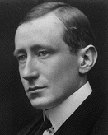
When Gugliamo Marconi, traveled from England to the U.S. in 1898 to demonstrate that Morse Code signals could be sent through the air without wires, he was officiating at the beginning of what we now take for granted: wireless communication.
The fantastic nature of his invention gripped the journalistic imagination of the time and its beneficial use was forecast in elegant prose not unlike that used to usher in the Internet and wireless in our time.
Families and friend now separated would be bound together…A distant friend could call to a distant friend in an electromagnetic voice: “where are you? He would say...[and] A small reply would come “I am at the bottom of a coal mine, or crossing the Andes. Or in the middle of the Atlantic” … Think of what this would mean, of the calling which goes on every day from room to room in a house, and then think of that calling extending from pole to pole, not a noisy babble, but a call audible to him who wants to hear, and absolutely silent to all others. It would be almost like dreamland and ghostland, not the ghostland cultivated by a heated imagination, but a real communication from distance based on true physical laws.” (P.T. McGrath in Century Magazine, March 1902. Quoted in Susan J. Douglas, Inventing American Broadcasting, 1899-1922 , John Hopkins University Press, 1987 – another great book!)
or:
Telegraphy without wires – how attractive it sounds. No more unsightly pole lines disfiguring the streets and highways, ornamented with the dangling skeletons of bu-gone kites. No more perpetual excavation of the streets, to find room beneath their surfaces for additional circuits that cannot possibly be crowded on to the staggering lines that darken the sky with their sooty cobwebs. A little instrument that one can almost carry in the pocket…and if your correspondent be likewise equipped, you may arrest his attention and talk to him almost any time or place, with no intervening medium but the …ether… Possible? Certainly. But will it pay? (Electrical World, June 10, 1899. Also quoted in Douglas, Inventing American Broadcasting)
Marconi's interests were a good deal more practical than the rhetoric used to describe them. He wanted to compete with the cable companies. He wanted to prove that information could be moved faster and more effectively without underwater pipes and he wanted to exploit his invention for commercial purposes. He was a business man.
But the way was not without difficulty. In 1901 he erected an enormous circular aerial in Cornwall, England , "a ring of twenty wooden masts, each about 200 feet high, arranged in a semi-circle 200 feet in diameter", made up of 400 wires and covering an acre of land.
Think of that when you dial that small and infinitely more sophisticated instrument you carry with you today!
On September 17, 1901, one month after Marconi’s elaborate structure was erected, a severe coastal storm blew it down. A few weeks later, its sister antenna on Cape Cod was also blown down.
Marconi began again. He changed his location from Cape Cod to Newfoundland -- opted for one way transmission and a less elaborate system: in Newfoundland he attached his receiving aerial to a kite. And on December 12, 1901, having instructed his assistants in Cornwall to send the code that represents the letter S for three hours each day, he heard the three dots. From Cornwall to Newfoundland -- a distance of 2000 miles.
On December 21, 1902, slightly more than a year after he received the letter S, Marconi succeeded in transmitting a full message from the Governor General of Canada to King Edward VII: “ The New World Sends Greetings to the Old”. In January 1903 he successfully established an American link and sent “most cordial greetings” from President Roosevelt to Great Britain’s King.
And Ray Stannard Baker wrote:
Think for a moment of sitting here on the edge of North America,” , “and listening to communications sent through space, across nearly 2000 miles of ocean from the edge of Europe! A cable, marvelous as it is, maintains a tangible and material connection between speaker and hearer; one can grasp its meaning. But here is nothing but space, a pole with a pendant wire on one side of a broad, curving ocean, an uncertain kite struggling in the air on the other -- and thought passing between." ( "Marconi's Achievement",McClure's Magazine18 (Feb.1902).
Now there's a beautiful idea -- thought passing between!
Posted by newradio at 05:59 PM
oh that ether!

More on Sky Ear
Rereading David Pescovitz’s article State of the Artists, where he discusses Sky Ear–a “surreal electric ‘cloud’ of mobile phones and helium balloons that connect participants with the electromagnetic ether…," I am reminded of early radio.
It was Guglielmo Marconi who first exploited Heinrich Herz’s discovery of electromagnetic radiation and demonstrated that radio waves could be used to transmit morse code over hundreds and then thousands of miles. When he first introduced wireless to America, during the popular America Cup races in 1899, the press hailed him as a hero and a wizard. Wireless itself evoked “psychic metaphors” (see Susan Douglas’ great book, Listening In). It was magic; Popular Science Monthly wrote that it was as if “the nerves of the whole world (were)…being bound together.” And the reputable scientist, Sir Oliver Lodge, one of the leaders of the British Association for the Advancement of Science, suddenly began praising mediums, insisting the dead don’t die and describing contact with the spiritual world. The connection between radio, the ether and spirituality ran strong.
Sky Ear, which is designed to acquaint you with these same "hidden mysteries of the wireless spectrum” by triggering high-intensity colored LEDs within the cloud, seems to be falling on a different sensitivity in 2004, with one correspondent remarking that “putting mobile phones into the clouds just to blink colors is ridiculous.”
Sky Ear had its last public launch in England on September 15, and according to its web site, there are no confirmed "flights" planned for the future, although talks go on. For more on Sky Ear and other works by Usman Haque. For more on radio: Susan J. Douglas, Listening In: Radio and the American Imagination, Times Books, 1999.
Posted by newradio at 04:19 PM | Comments (0)
September 27, 2004
Closed Circuit Videoinstallationen
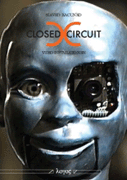
space and time in a global context
After extensive research Slavko Kacunko has published Closed Circuit Videoinstallationen in German. The 1,200 paged book is accompanied by a DVD. It focuses on "the important aspects of the history of media art-"live" video installations. Unlike the few attempts to date to present a survey of the diversity and notably the quantity of international media art, the book is the first to consider the global context in which the sphere of (interactive) media art is developing.
From the historical perspective, links between Europe and the USA, Australia and Asia, Eastern Europe, and South America are highlighted, with focus on regional, national and individual achievements. The book looks in detail at the individual artistic approaches in the context of space and time, and it includes a description and record of 1100 works and 650 artists. This and the notes on further reading and viewing will enable deeper explorations of the material. In recent years, theoretical debate has diagnosed with some precision where the electronic video image stands between analogue and digital codes, or again, between media "representation" and "presentation". This position is subjected to examination against the pertinent examples.
Video technique makes it possible to simultaneously record and reproduce images, sound and sequences of motion; that potential can be seen as a specific characteristic of the medium. The closed-circuit video installations based on it represent the attest field of experiment for the assumptions on art and the theory and history of the medium that it might lead one make."
Table of contents:
Introduction
1. The history of media art: state and competence of research
2. Positioning of current project: visual criticism and cultural criticism
3. Structure and contents
I. Media Art: Category Definitions:
1. "Installation"
2. "Performance"
3. "Input"/"Output"
4. "Feedback"
5. "Immediacy"
6. "Interface"
7. "Interaction"
8. General terminological pairings
a) "Art" and "Medium"
Excursus: "Simulation" and "Metaphor"
b) "Representation" and "Presentation"
c) "Analogue" and "Digital"
II. Closed Circuit Video Installation: A Theoretical Review Prologue: on research specialisms in art and media theory
1. "Subject" - "Object" relationship
2. Constructions of reality
3. System models and behavioural blueprints
4. Game concepts and learning processes
5. Data collation and checking
6. Telecommunication
III. Closed Circuit video Installation: A Geo-historical Overview Towards a Definition: an overview
Suggestion for a Definition
On Structure and Groupings
1. The first decade (1966 - 1976)
2. The second decade (1977 - 1989)
3. The third Decade (1990 - 2002)
Each of these periods is "illustrated" with hundreds of examples of artists and their work from many different countries (In 2. The second decade is from
Denmark mentioned "Golden Boys", Carsten Schmidt-Olsen, Torben Soeborg)
Concluding Remarks
1. The "materiality" of media
2. The "immateriality" of art: the "performative"
3. The "supremacy of appearances": the false mirror
a) "Guardians of the Image"
b) Feedback as pseudo-argument
c) Ecstasy, rationality and reversibility: Apollo and Hermes
d) "Video Spheres" and Irreversibility
4. Closed-circuit as an "open system": target concept - interaction
5. The history of media art: strategies and perspectives
Literature and Correspondence - URLs - Index
The book is accompanied by a DVD-ROM with a catalogue with artists and their works (images, descriptions & URLs).
Posted by jo at 05:38 PM | Comments (1)
September 17, 2004
The Avatar

The Avatar is Legal Voting Age
"I finally got around to scanning my copy of the first print reference for the use of the term Avatar to represent a user's graphical online presence.
Definition Habitat: A make-believe world inhabited by small, colorful creatures, called Avatars. Human beings may visit Habitat and move freely about its regions, interacting at will with with Avatars. Human beings reach Habitat by traveling many miles through tiny telephone lines and entering through a large gateway, called QuantumLink. Once a human being enters Habitat, he or she takes on the visual form of an Avatar, and for all intents and purposes becomes one of these new-world beings. In the world of Habitat, people can play games and go on quests, but mainly they meet other people and have fun. -- Run Magazine, August 1986
The Avatar just turned 18."
Posted by Randy on Habitat Chronicles, September 13, 2004
Posted by jo at 09:53 AM | Comments (0)
September 14, 2004
Report from ISEA 2004

Report from ISEA 2004
by Jonah Brucker-Cohen
ISEA 2004: August 14-22, 2004, Helsinki (Finland), Baltic Cruise, Tallinn (Estonia)
Held over a week and located in Helsinki, Tallinn, and a Baltic Sea-roving cruise liner, ISEA 2004 was a marathon media arts conference like none other. With over 1,500 artists taking part in panels, performances, fashion shows, keynotes, and installations, there was little time for sleep among all of the commuting between venues. The conference's theme examined the crossover between wireless culture, wearable or fashionable technology, and networked experience. ISEA 2004 aimed to explore themes surrounding critical notions of interaction design, open source software culture, and geopolitics of media. This approach attempted to challenge accepted notions of interaction by focusing on possibilities of re-appropriation instead of mere re-evaluation. Although the conference schedule was an often strenuous journey through multiple cities and events, the discussions, interventions, and realizations that manifested contributed to an exhilarating experience.
The festival officially began aboard the "Networked Experience" Baltic sea cruise (I missed the Koneisto sound event the night before in Helsinki), where the focus was on how networked culture iterates human understanding through shared experiences such as email lists, collective performance, interactive narrative, and GPS sound installations. The panel entitled "The List: The mailing list phenomena", began in the Metropolitan ballroom of the ship, with a panel of list-serve moderators such as Melinda Rackham of Empyre, Kathy Rae Huffman of Faces, Axel Bruns of Fibre Culture, and Charlotte Frost who is studying list culture for her Ph.D. thesis. Examining networked culture, the debate centered around the nurturing of lists and what types of communication technologies are appropriate for specific communities. I spoke on the challenges of my BumpList project as an example of an email community that focuses on shifting the structure of a system to change its participants behaviors. Other panels and events focused on community awareness in digital media projects like "E-Tester" and UNESCO meetings with African and Asian award winners and participants.
Arriving bewildered and tired in the city of Tallinn, Estonia, the "Wearable Experience" theme of ISEA began with a keynote from Concordia University's Joanna Berzowska. Her talk was an overview of wearable trends and projects that aimed to challenge traditional notions of strapped-on gadgetry by emphasizing the integration of sensors and displays into clothing. Her own research on "Memory Rich Garments" showed how everyday emotions and intimacy could be projected and enhanced through computationally enhanced clothing that stores non-personal data about people it comes into contact with. ther panels focused on the how technology and fashion can integrate into networks, how clothing can act as a display for portable signage, or how intimacy could be conveyed over distance. This discussion continued to Helsinki's "Wireless Experience" theme, which began as hundreds of ISEA attendees were stuck in passport control after arriving on the SuperSeaCat ferry from Tallinn. Machiko Kusahara of Japan's Waseda University opened the conference with a keynote address on mobile phone culture in Japan. Her focus centered around how "socially acceptable" mobile phone or "ketai" use had become and how advertisements for services emphasized how "left out" of mainstream culture people have become without a phone. Although her talk emphasized the social pressures of technology, it left out dangers of extended mobile phone use or the advent of surveillance culture. These questions were made more evident through the many parallel sessions over the next few days.
The second keynote by the Sarai New Media Initiative's Shuddhabrata Sengupta focused around the conference theme of "Histories of the New" and how reinventing the future is often tied to lessons from the past. His talk "The Remains of Tomorrows Past: Speculations on the Antiquity of New Media Practice in South Asia", presented the history of technical networks from the telegraph to the Internet. His talk referenced Tom Standage's book "The Victorian Internet" to illustrate how these information networks are not new and how they simply provide frameworks for a centralized space that expands global discourse. UCLA's Erkki Huhtamo, followed this talk with his take on the "Archaeology of Mobile Media", or how media does not exist independently from the social framework that envelops them. He showed imagery of the amateur photographer of the early 20th century comparing the public perception of this "nuisance" to the current mobile phone camera phenomenon: both seen as invasions of privacy and unwanted surveillance in the hands of the people.
Following this theme, the GPS art panel, moderated by San Francisco based-artist Marisa Olsen, attempted to ground location-based media projects into a defined genre. The current ghettoization of media art into technology-defined categories like GPS or Wi-Fi tends to counter creativity at its roots. Instead the focus should be on crystallizing an idea so that the technology becomes less awkward and central to the output. Projects discussed included Pall Thayer's "Hlemmur in C" that tracked taxi movements through GPS and composed real-time soundtracks based on their position in the city, Joel Slayton's (of the C5 collective) mapping of altitudes on the Great Wall of China to plot where it could have been built in California, and Teri Rueb's "Trace" which allows people to discover location-based sound clips embedded into positions on a nature trail in Canada. In a sense, most of the work in this area centers on GPS enabling you find or discover things in your environment or enabling people or devices to find you. Little was mentioned about the surveillance aspects of tracking or the social aspects of why this technology is becoming pervasive?
Filling in the hard theory was keynote speaker Wendy Hui Kyong Chun of Brown University who spoke on "Control and Freedom: Interactivity as a Software Effect". Her talk was probably the most seminal moment of the conference as it connected up the central themes. Chun emphasized the role of technology as a contributor to social stigma especially in networked culture and outlined how surveillance is becoming a visual and territorial metaphor for control. Her breakdown of the utopian view that current software assumes that users cannot understand computation showed explicitly how layers of mediation between code and interface are getting thicker. Nina Wakeford of the University of Surrey spoke on "Identity Politics of Mobility and Design Culture", focusing on the importance of local knowledge with examples of projects that emphasized aspects of mobility as a driving force in design.
The exhibitions scattered around Tallinn and Helsinki showcased everything from fashion tech and accessories to social and political projects, to interactive installations and data visualizations. Some impressive projects included Bundith Phunsombatlert's "Path of Illusion", a series of street lamps with rotating LED displays that passerbyers could type into rounded keyboards at the base of the lights. Also meant to display information in public space was Steve Heimbecker's "POD (Wind Array Cascade Machine)" which consisted of sixty four air flow sensors in Montreal that transmitted data to towers of LEDs that resembled a large-scale graphic equalizer. Also interesting was Diego Diaz's "Playground" which turned a kids merry-go-round into a collective joystick to navigate a shared 3D space. I think someone got overexcited and broke the piece midway through. In Tallinn, the wearable showcase features Tina Gonsalves and Tom Donaldson's "Medulla Intimata", video jewelry that changes depending on the emotional state of the wearer and the conversations in which they are engaged. Other projects such as Kelly Dobson's "ScreamBody" which consists of a bag you scream into and release the sound later, Sabrina Raaf's "Saturday" which used gloves with bone transducers to hear sampled CB radio conversations through your cheekbones, and "Seven Mile Boots" by Laura Beloff, Erich Berger and Martin Pichlmair that allows people to traverse chat rooms by walking around a physical space. Overall the projects in the show examined how wearable technology can impact and change our environment, personal experience and social landscape
As ISEA ended, most people were thoroughly exhausted. Although the constant shifting of venues, cities, and themes might have contributed to this, the questions raised by the presentations and exhibitions remained strong throughout the event. Why is interaction engaging? Is there a larger message involved? How do creative systems and practice filter up to decision and policy makers to provoke and result in global action? With diverse speakers such as the Sarai Collective's challenge to the hegemony of the digital art canon and Mark Tribe open-sourcing his presentation online so that people could "remix" it after his talk, the conference presented a wide array of contrasting opinions that attempted to make sense of the current media arts landscape. With so many perspectives, the endpoint seemed scattered but also manageable. The more we question the fundamental reasons why technology is important, the more we discover why we cannot live without it. Only through events like ISEA can we really come to grips with this realization.
Jonah Brucker-Cohen (jonah (at) coin-operated.com)
originally published on coin-operated
Posted by jo at 01:18 PM | Comments (0)
September 13, 2004
Digital Performance Archive
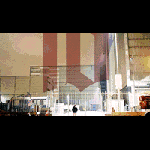
The Digital Performance Archive (DPA) was a major research project documenting developments in the creative use of computer technologies in performance--from live theatre and dance productions that incorporate digital media, to cyberspace interactive dramas and webcasts. DPA also collated examples of the use of computer technologies to document, discuss or analyse performance--from specialist websites and e-zines, to academic CD-ROMS. As a central aim DPA collated an extensive online searchable database of virtual theatre performance and related events 1990-2000, including selected video documentation and statements by creators. You can search by keywords, technologies (drop down menu) and practitioners.
Posted by jo at 09:34 AM | Comments (0)
September 03, 2004
oldies but goodies
Three from 1995
Thanks to Katherine Moriwaki for personaldebris… for all of life’s detritus and the documentation that leads back to the wonderful 1995 exhibition at Galerie La Centrale, Montréal, Québec. Canadian artists, by the way, have played a major role in networked art from very early on. I’ll be mentioning a number of them in my hopefully upcoming and definitely idiosyncratic history.
The Galerie La Centrale, Montréal show included works by Barbara Layne and Ingrid Bachmann, David Rokeby, and Paul Sermon.
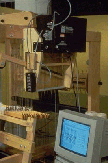
Fault Lines (1995) by Barbara Layne and Ingrid Bachmann, was described in Katherine’s blog. It was a work in which computer-assisted looms were programmed to translate recorded daily seismographic information between two locales: Montreal and Santa Monica, CA. Increments of cloth were then woven each day by individual handweavers at each of the sites. The tectonic movements of the earth were thus recorded through one of the earliest and one of the most recent technologies.
Very Nervous System (1986-1990) by David Rokeby was a non-visual interactive sound installation that made use of video cameras, image processors, computers, synthesizers and a sound system to create a space in which the movements of one’s body created sound/music. Upon entering a room, the viewer became aware that his/her simple displacement of air caused a reaction of sound within the environment., altering the otherwise seemingly empty site. As Wired said of this work: "David Rokeby's Very Nervous System does a number of things. But mostly it does this: it watches you. This piece of art tracks the slightest movement of the human body. Rokeby wires up a space the size of a dance floor, and whatever moves through it is sucked into the artwork. Very Nervous System makes something out of you. It turns you into a symphony. Or a jazz song. Or a samba."

And Paul Sermon's Telematic Dreaming (1992) - we described in an earlier blog. But here it is again. A bed was set up within the gallery space onto which an image of a person in another bed was projected in real-time. The viewer was then able to interact with this telepresence producing what one reviewer called “an uncanny exchange.”
The basic technical system consisted of a camera situated above a queen-size bed. The camera received an overhead view of the bed. The image of the bed and someone lying on it, was sent via ISDN lines and teleconferencing systems to a video projector situated above another bed in a geographically distant location. The live image was projected down on to the bed, and with it the live, life-size image of the person. Another video camera situated next to the video projector sent an image of the projection and the second person lying on the bed under the projection, back to the first bed.
You can google all three works for more information. What strikes me at the moment is that while they are all “installations” and exhibited in a gallery, they are also “performances” and either involve performers (handweavers in Fault Lines) or audience members who do something (perform) to create the work. And that all three deal with the physical or material and the virtual, challenging the notion, prevalent at the time (remember William Gibson?), that these two realms were separate.
Posted by newradio at 10:17 AM | Comments (0)
August 24, 2004
Musicians and mobilephones
"Musicians have subverted tools such as the record turntable, the digital sampler and the laptop computer, transforming them from their original purposes into instruments. Ringtones were the obvious starting point for the mobile phone as a creative device. In 2002, the Touch label released "Ringtones," a CD collection of sounds commissioned or collected from 99 artists and sources, ranging from Gilbert and George to sound recordist Doug Quin's tapes of arrow frog and baboon..."
For more of this great short history of musicians use of mobile phones, see
Walking Through Sound by David Troop. It's a great article.
Posted by newradio at 06:33 PM | Comments (0)
August 17, 2004
networked performance discussion on empyre
From the introduction by Christina McPhee: "How does performative space become networked space? How might the traditions of theatre, dance and ritual, such as butoh, or 20th century avantgarde processes such as fluxus, inform or critique the practice and theory of performative, live movement? Is there a 'ghost in the machine', like a generative algorithm that sets in motion relations to live movement and virtual reaction? Where is meaning, and where is body? Is there a sense of place in performative networked space"? Continue reading on empyre
Posted by jo at 03:55 PM | Comments (0)
August 11, 2004
performatives
speech acts and difference
In the early sixties, JL Austin coined the term performative - calling it an explicit utterance - which differs greatly (and seemingly magically) from the descriptive constative. While the latter explains, the former - often called a speech act - actually makes an ontological change. 'I now pronounce you man and wife,' 'I apologize' and 'Go, you fool!' (a command) are all actions, as well as words (whoa. 'actions speak louder than words' is now a void concept more info). In the present, many interventionist artists have taken on this term, and performative has come to mean virtually any expression, gesture or performance that transforms or births identity, ideology, history (and the list goes on...). So, beyond networked_performance, what would constitute a networked performative? What happens when we (click) submit? When we reset our form? Aside from a node, what can we create? And beyond making a difference, how different can we be? If Salvador Dali performed surrealism, what is it we are performing into or out of existence? (Posted on Nathaniel Stern)
Posted by at 04:27 AM | Comments (0)
August 09, 2004
report from SIGGRAPH
![]()
transverging in LA
I'm at SIGGRAPH this week checking out the scene - most notably, emerging and interactive technologies. Of interest yesterday, Sunday, were Artist Round Table sessions. In the session Researching the Future the panelists discussed their work in relation to creating new models that reflect epistemological changes resulting from current scientific and technological development.
The session led off with the Planetary Collegium model as a general framework for approaching the art + science collaboration.
While all quite compelling, the resonance for this blog (and applicable to all practice) came from Marcos Novak's presentation on 'transvergence'. This excerpt from Marcos' site summarizes the changes necessitating a transvergent approach to research and practice:
In short, we conceive algorithmically (morphogenesis); we model numerically (rapid prototyping); we build robotically (new tectonics); we inhabit interactively (intelligent space); we telecommunicate instantly (pantopicon); we are informed immersively (liquid architectures); we socialise nonlocally (nonlocal public domain); we evert virtuality (transarchitectures). He has also posited a new "Soft Babylon," a theoretical stance which posits that our digitized architectural palette is causing us to create a wired Situationist city, while we struggle with some of the massive paradigm shifts that our era will and must face.
Novak explains: “transvergence, in a pedagogical and research context, refers to the study and applications of concepts and methods by which convergence of disciplines, media and technologies is seen not as a goal in itself, not as the focal point of a predictable origin for divergences but as an opportunity to speculate and propose novel transdisciplinary epistemological and creative formations. Using willful strategies of derailment, it seeks to promote the mergence of previously unattainable but presently potentially viable species of efforts: future genres, future fields of inquiry, future arts, media and sciences”.
I wonder what a practice of willful deraillment would be when applied to networked performance and who is formally investigating this.
In another session, Ars Electronica: 25 Years of the Digital Avant-Garde, Michael Naimark discussed interactive art conventions. As an Ars juror reviewing vastly differing interactive works, he notes these problematic points that need to yet be addressed:
• difference between the content and the tool
ie - when projects have vastly different use of content and tool, the criteria was to favor the work that best subverted expectations.• actual versus apparent interactivity
ie - the clarity or ambiguity of interface responsiveness - most problematic in performances in which an audience is observing a performer - how does the audience know when the performer has interacted with the work?• does the user feel in control via the interface or not?
ie - such as with obvious versus metaphoric interaction and cases when using input and interaction as a 'not directly representational' form (as in the case of interaction controlled or effected by data collected by means other than direct navigational control.)
I'd also recommend folks cruise through the Ars archives for a 25 year chronicle of digital media art presented at Ars.
Posted by michelle at 10:36 PM | Comments (0)
August 08, 2004
Never say No
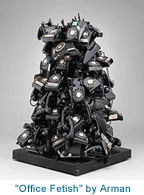
Phoneyvents
"There is No telephone Art," Gregory Battock proclaimed in New Artists Video, A Critical Anthology in 1978. But:
Have you ever heard of "phoneyvents"? Jim Pallas began work on them in 1973. They were originally audio works played to recipients in a telephone number book. Based on the idea that a "telephone bell elicits a state of focused attention in most Americans," and that most are ready for communication "whose content could be anything," Pallas' work invoked surprise and a sense of intrusion in those answering his calls.
"The Phoneyvent," he writes, "would be cued up on an audio cassette tape player. The player was patched into the phone line. DC voltage isolation was obtained by using a 50 mfd capacitor in series. I dialed the recipient's number and when they answered, I played the event while listening in."
Pallas went on, in 1978, to develop the less intrusive "dialevent," which consisted of a number you could call to get a "phoneyvent" played over an automatic telephone answering machine.
Phoneyvents became so popular after an article in the Detroit Free Press, that the Bell Telephone Company sent out an inspector to investigate why the trunk lines were overwhelmed with traffic. You can listen to a selection of original 1978-79 events at http://www.jpallas.com/phone/dialyvent.html
Posted by newradio at 12:10 PM | Comments (0)
August 05, 2004
On Categorization (herein)
Networked Performance Categories
For those of you who read Sara Diamond’s “Hello, Hello! A short history of networked performance art” in issue 13 of HorizonZero, Bruce Barber's definition of performance will be familiar. It’s inclusive, perhaps some will think too inclusive.
Barber "proposes performance as an engaged and committed task of acting on culture. ‘The task’ he says ‘ becomes restorative and critical’. "
As we struggle to set up categories for the works included on this blog, (hoping to make it easier for people to find works that interest them), we find ourselves struggling without much conviction. Networked performance--an area where borders are porous, dividing lines broken or to be broken, and territories redrawn or to be redrawn. All in process. Why categories then?
In this state of ongoing transformations, Barber’s proposal is welcome.
The categories on this blog evolved from the following thoughts -- to create categories that reflect:
1) how artists label their own work
2) a continuum with existing labels and practice
3) an intent to focus on the space in-between established practice.
With the latter, this also determined that entries would be catalogued in one or more applicable categories.
Now that a volume of content is amassing , the questions becomes one of utility. Are the intentions of the structural methodology overrun by the manifestation of similarities between categories and made confusing and/or meaningless? Or conversely, does the multiplicity of cataloguing enrich the cross-listing/cross-referencing?
We would like your response.
Posted by newradio at 08:40 PM | Comments (0)
Whitman's phones

Cellphone Performance
11 October 2002, Leeds, UK: (Evolution 2002: PROCESS) During his first visit to the UK, seminal American artist Robert Whitman produced a 30 minute cellphone performance based on a 1960's work he originally performed using payphones in New York City.
The performance in Leeds used 30 volunteers with cellphones stationed at pre-defined locations around the city centre. The volunteers repeatedly called a central telephone number and switch board situated in Millennium Square and, when their call was answered, gave a short description of their location. The resulting calls were mixed by Robert and relayed live through public address speakers to an audience in the outdoor square. The performance painted an aural description of the city at that given time.
During the 1960's Whitman distinguished himself with sophisticated theatrical works involving interaction between live performers and filmed images. For more information on this little-known artist, who along with with scientists Fred Waldhauer and Billy Klüver and artist Robert Rauschenberg, cofounded in 1966 Experiments in Art and Technology (E.A.T.), a loose-knit association that organized collaborations between artists and scientists, see Robert Whitman’s Telecommunication Projects by Bettina Funcke. As Funcke writes, "The little-known work of Robert Whitman...deserves serious reconsideration, partly because it can be seen as an unconscious prehistory to much of today’s art."
Posted by newradio at 08:29 PM | Comments (0)
July 31, 2004
The Technology Experience
2004.06.02 Helen Thorington
Looked at a piece called Dancing Beyond Boundaries done in 2001 between the Universities of Florida, Minneapolis, Campinas, Brazil and the SuperComputing Conference in Denver. Using the Access Grid and Internet2. It seemed to exploit technology in new ways but not explore virtual space as a stage, as over and against using a screen where a real-life stage is shown via film (video). Or: is this the perspective of the archivist?
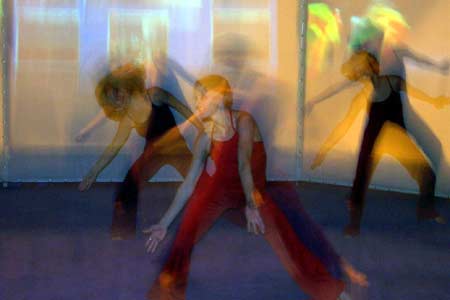
2004.07.31 Michelle responds:
Immersive, Pervasive, Ubiquitous, Sentient. Chris Salter's work with Sponge, though I've only read about it, is presented in a manner that makes me expect his group's works would be enveloping, engaging, interactive - that this is a responsive environment. Experiential, versus presentational, which is what Helen references when she questions what is it to "explore virtual space as a stage".
This raises interesting issues about space as both computer space and actual space now with tracking, compositing, GPS, sensors, that can interact in real-time via wireless networks. The space within the computer interacts with and responds to actions in physical space. We now simultaneously inhabit both.
GPS, like the internet, a military hand-me-down, is a double edged sword in terms of being both an enabler and a tracker, engaging the surveillance/ freedom issue. To use the technology one needs accuracy. The greater the accuracy the more information the less free the subject of the data. Who controls, accesses, data, the public air, space.
Posted by michelle at 02:11 PM | Comments (0)
From Hactivism to Tactical Media
Hacktivism (electronic resistence within the network) has fed into tactical media: urban, mobile performance events.
Being 'wired' has become mobile, ubiquitous, sentient, pervasive, OMNICIENT monitored, computing. As we desire our movies and games to be more realistic - hyper-realistic - we now inhabit our computer-mediated, if not computer-generated worlds. We interact through joysticks that exert pressure to our response. We track oursleves with GPS-equipped devices, we pass and receive data streams: enveloped, engaged, connected, linked.
There's a surge in public events - happenings - Kaprow's "Environmental Theatre" of the collective, enabled by wi-fi technology and taken to the streets: MOBILized.
From: The ABC of Tactical Media by David Garcia and Geert Lovink
Tactical Media
"In fact we introduced the term tactical to disrupt and take us beyond the rigid dichotomies that have restricted thinking in this area for so long: dichotomies such as amateur vs professional, alternative vs mainstream. Even private vs public. Our hybrid forms are always provisional. What counts are the temporary connections you are able to make. Here and now, not some vaporware promised for the future. But what we can do on the spot with the media we have access to. Here in Amsterdam we have access to local TV, digital cities and fortresses of new and old media. In other places they might have theater, street demonstrations, experimental film, literature, photography. Tactical media’s mobility connects it to a wider movement of migrant culture."
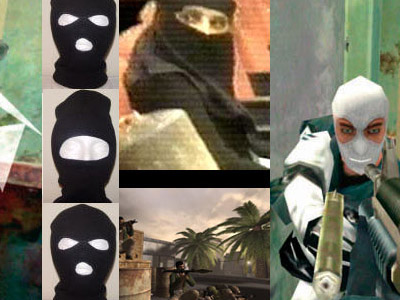 O.U.T.: Operation Urban Terrain :a live action wireless gaming urban intervention
O.U.T.: Operation Urban Terrain :a live action wireless gaming urban intervention
When: August 30, during the Republican National Convention, New York City.
Two women in gear are on the ground. One with a laptop and the other with a projector pointing onto building walls in 3 key locations in the city. They are connected through a mobile wireless bicycle to an online team of five game players located around the world. They intervene on servers in a popular online military simulation game with performance actions carried out by the whole team.The live projections in the city can also be viewed through a web cam on the OUT website.
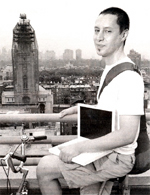 Magicbike is a mobile WiFi (wireless Internet) hotspot that gives free Internet connectivity wherever its ridden or parked. By turning a common bicycle into a wireless hotspot, Magicbike explores new delivery and use strategies for wireless networks and modern-day urbanites. Wireless bicycles disappear into the urban fabric and bring Internet to yet unserved spaces and communities. Mixing public art with techno-activism, Magicbikes are perfect for setting up adhoc Internet connectivity for art and culture events, emergency access, public demonstrations, and communities on the struggling end of the digital-divide.
Magicbike is a mobile WiFi (wireless Internet) hotspot that gives free Internet connectivity wherever its ridden or parked. By turning a common bicycle into a wireless hotspot, Magicbike explores new delivery and use strategies for wireless networks and modern-day urbanites. Wireless bicycles disappear into the urban fabric and bring Internet to yet unserved spaces and communities. Mixing public art with techno-activism, Magicbikes are perfect for setting up adhoc Internet connectivity for art and culture events, emergency access, public demonstrations, and communities on the struggling end of the digital-divide.
Posted by michelle at 01:51 PM | Comments (1)
Historically Locating Distributed Performance
2004.04.05 Helen Thorington, writing about an early conference proposal:
The following are examples of distributed performances:
Finding Time (Jesse Gilbert, 2000). Finding Time linked performers on six continents in a series of live musical events, each an hour’s duration.
World Wide Simultaneous Dance (1998, Laura Knott). The project took place simultaneously in twelve countries.
In both examples the performers played to audiences in their performance spaces and to a worldwide Internet audience by means of especially created websites.
I then move on to a brief history, beginning with Kaprow's "Hello Hello" in the mid-60s--about which I can find very little information other than that it linked five sites in a television event. And on to Kit Galloway and Sherri Rabinowitz.
But the history is the not the question for me. Internet works resonate with historical issues. But what I'm beginning to think as I research for the conference is that we may already have witnessed the passing of the (pre)structured presentation of large-scale performance works--I keep thinking, for instance, that while Adrift (1997-2001) was very different from other works produced at its time, it was also very traditional. It was a work by three artists (the senders), in which its audiences had no agency at all--Like radio, like television, they were cast in the role of "receivers."

From the Adrift performance
Now...when did it happen?...the Internet environment is in a far more participatory stage and people-interest runs to works/platforms/
environments in which the former viewer can play an active role. Which may begin to explain why there are really not very many interesting large performance works being produced at this time. Not only is the technology still difficult but the environment is no longer congenial.
Or am I wrong? And if not, what does this do for/to our conference?
I'm going to think about this for awhile. Right now my only thought is that if this is so, the conference itself should reflect it and include the many twists and turns performance has taken in the last years.
Posted by michelle at 01:22 PM | Comments (0)
July 30, 2004
Happenings
Goings On in the 50s and 60s:
They were non-verbal, theatrical productions that abandoned the stage-audience structure, did away with the usual plot or narrative line of traditional theatre; made objects of the performers and set them within an overall design of environment, timing, sound, color and light. They were accidental, spontaneous and planned -- each a unique event shaped by the action of the audience that participated in it.
See: "Happenings in the New York Scene (1961)" (Kaprow, Allan, Essays on the Blurring of Art and Life, University of California Press, 2003) " …a happening cannot be reproduced. The few performances given of each work differ considerably...and the work is over before habits begin to set in.”
Posted by newradio at 08:37 PM | Comments (0)
Distributed Performance or the Left Hand Knows...
July, 1962:
Nam June Paik devised a piano concerto for simultaneous performance in San Francisco and Shanghai, with the left hand part being played in the USA and the right hand in China. The first telecast to Europe and America took place over Telstar 2 in July 1962.
Posted by newradio at 07:33 PM | Comments (0)
A Portal into Difference
Woodstock, New York, August 29, 1952.
David Tudor placed John Cage’s hand-written score, 4'33" on the piano and sat motionless. The score indicated three silent movements, each of a different length. Tudor signaled its commencement by lowering the keyboard lid of the piano. The sound of the wind in the trees entered the first movement. After thirty seconds of no action, he raised the lid to signal the end of the first movement. It was then lowered for the second movement, during which raindrops pattered on the roof. The score was in several pages, so he turned the pages as time passed, but played nothing. The keyboard lid was raised and lowered again for the final movement.
And so Cage initiated a "creative process which successfully detaches itself from the intentions of its author – and from the self-expressive intentional purpose of music" – and introduced a new aesthetic of unintentional sound.
Posted by newradio at 07:28 PM | Comments (0)
What connects the future and the past?
The following comment from Benton Bainbridge frames a question that we, the organizers have been asking since we first thought of this blog. What connects the future and past of networked performance. How has networked performance evolved? What directions has it taken? A real understanding will come from individual replies to the questions Benton has posed. We hope you will make an effort to answer them.
From Benton: "my personal interest would be connecting the dots between the future and the past of networked/collaborative performance. can we advance today's efforts in distance collaboration through global and local digital networks by studying similar ambitions in earlier networked media?
my background is live audiovisual performance. the history of this discipline still hasn't been written, so as a country boy i drew inspiration and guidance from other collaborative arts: live music, underground comix 'jams' and performance art. Laurie Anderson, "Good Morning Mr. Orwell" and Youngblood's "Expanded Cinema" were key triggers too.
i'm curious how networked performance artists on this blog developed their art. how did you get into networked performance; what was your inspiration and how did you map the territory - firsthand R&D or study of past masters?
~benton-c"
Posted by newradio at 07:03 PM | Comments (0)
On Liveness and Presence
What is Live Art?
This from the UK: "Unlike with opera, people often ask, 'What is Live Art?' The answer is people have been experiencing it for the last hundred years, from the earliest events at the Cabaret Voltaire where DADA was born to the happenings of the Sixties which influenced Andy Warhol, and in the 21st century this tradition continues to mutate." 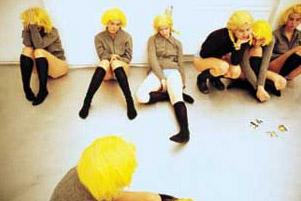
Today Live Art is witnessed at perfomances by Vanessa Beecroft or The Battle of Orgreave by Jeremy Dellar. Live Art is an interrogation of the aesthetics of presence. Live Art is about being there.
"Live Art mixes genres and diverse cultural experiences to express the complex organisation of contemporary life. It often involves work which questions commonly held assumptions. Live art is the trash-can of culture recycling and celebrating the debris of the modern world."
The History
: In 1965 Kaprow explained his evolution from collage to environments and happenings: "The action collages then became bigger, and I introduced flashing lights and thicker hunks of matter. These parts projected further and further from the wall into the room, and included more and more audible elements: sounds of ringing buzzers, bells, toys, etc., until I had accumulated nearly all the sensory elements I was to work with during the following years...." His works expanded until they filled the gallery, creating an integrated environment for the spectator. "I immediately saw that every visitor to the environment was part of it. And so I gave him opportunities like moving something, turning switches on -- just a few things. Increasingly during 1957 and 1958, this suggested a more 'scored' responsibility for the visitor. I offered him more and more to do until there developed the Happening...The integration of all elements -- environment, constructed sections, time, space, and people -- has been my main technical problem ever since."
Kaprow's progress did not occur in a vacuum, as he readily acknowledges. Robert Rauschenburg, Claes Oldenburg, and Jim Dine, among others, were also working on theatrical pieces, although they soon returned to more traditional areas; In Europe, Wolf Vostell and the Fluxus Group, and in Japan, the Gutai Group, were all investigating similar directions.
The Theory of Happenings: The Happening, as Kaprow developed it, is a non-verbal, theatrical production that abandons stage-audience structure as well as the usual plot or narrative line of traditional theatre. Although a compartmented organization may be used, the performers are considered as objects -- often kinaesthetically involved -- within an overall design of environment, timing, sound, colour and light. Found environments are often used and built upon, but the events are not casually arrived at, nor are they entirely accidental and spontaneous.
His view was that the Assemblage was to be "handled and walked around", the environment" was to be "walked into", but the happening was to be a genuine "event" involving spectator participation and no longer confined to the museum or gallery. Performers are encouraged to capitalize upon unplanned occurrences while acting out fantasies based on real life within a certain roughly pre-ordained structure that suggests symbolic and universally basic themes and meanings. A field of aesthetic operation is thus created in relation to life, combining artfully determined materials with strong associational properties, and dimensions with events and things from the sphere "outside" of customary definitions for art.
In the following networked performance types we directly see the influence of happenings particularly in the emergence of wireless network enabled Urban Gaming such as the Go Game. Go Game started off as a bunch of digerati having fun with their handhelds. Then it started becoming popular so the developers began marketing their services as event producers to corporations. Now their website has this decidedly corporate slant.
Pac-Manhattan was developed out of the NYU Interactive media program...possibly interesting if it doesn't fizzle out....
Urban Challenge, urrr I guess it's now Verison Urban Challenge. Enough said.
FlashMobs have matured to smart mobs.
GeoCaching is an entertaining adventure game for GPS users. Participating in a cache hunt is a good way to take advantage of the wonderful features and capability of a GPS unit. The basic idea is to have individuals and organizations set up caches all over the world and share the locations of these caches on the internet. GPS users can then use the location coordinates to find the caches. Once found, a cache may provide the visitor with a wide variety of rewards. All the visitor is asked to do is if they get something they should try to leave something for the cache.
Posted by michelle at 11:40 AM | Comments (0)

